https://www.blackgate.com/
A (Black) Gat in the Hand: Weird Tales Rings in Conan
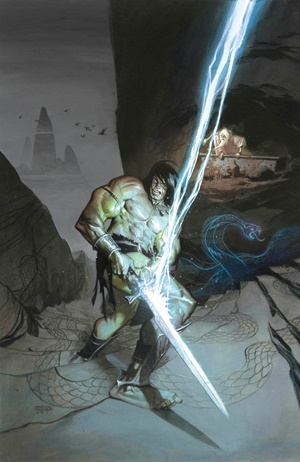 “You’re the second guy I’ve met within hours who seems to think a gat in the hand means a world by the tail.” – Phillip Marlowe in Raymond Chandler’s The Big Sleep
“You’re the second guy I’ve met within hours who seems to think a gat in the hand means a world by the tail.” – Phillip Marlowe in Raymond Chandler’s The Big Sleep
(Gat — Prohibition Era term for a gun. Shortened version of Gatling Gun)
Back in 2018, I started A (Black) Gat in the Hand because I wanted to share my love of hardboiled Pulp. I’ve had some friends join in, and they’ve added some non-hardboiled Pulp, while I’ve expanded my coverage. I’m currently working on my third Kirby O’Donnell essay, and my first on Harold Lamb, which takes us to the Adventure Pulps. And I’m starting another Robert E. Howard Weird Menace post, looking at his occult investigators, Conrad and Kirowan.
One of those stories has a direct link to Conan! A key part of that one is The Ring of Thoth Amon. And if you like the mighty-thewed Cimmerian, you know that ring is integral to the very first Conan tale, “The Phoenix on the Sword.”
Two years before I kicked off my Pulp series under the first title of With A (Black) Gat, I wrote one of the very first essays for Hither Came Conan. Six years ago now, I ruminated on “The Phoenix on the Sword.” I like that story quite a bit. So, we’re bringing that post back for the Summer Pulp series, while I work on the second life of The Ring of Thoth Amon.
I’m pretty sure “Phoenix” was the first Conan story I read. Now, it might have been “The Thing in the Crypt,” in the first Lancer/Ace collection, which I had bought and then stuck on a shelf for at least a decade or two. But I didn’t remember that story when I started going through the Ace books, AFTER exploring Conan via the Del Rey trilogy. So, I think it was “Phoenix.”
The Phoenix on the Sword
It is well known that “The Phoenix on the Sword,” the first story of Conan the Cimmerian, was a rewrite of a previously unsold tale of an earlier Howard character, Kull, an exile from Atlantis.
Howard sold three Kull stories to Weird Tales, appearing in the August and September issues of 1929, and finally, in November of 1930. Howard also wrote nine more tales about the character, which were not published until after his death. So, only 25% of his Kull stories sold. Not exactly a money-maker.
However, “By This Axe I Rule!”, which had failed to sell to Argosy and Adventure, was dusted off to feature a less-philosophical barbarian.
I struggled through the Kull Canon. I definitely prefer Conan, Solomon Kane, and El Borak. The Kull stories seem, to me, to be overly philosophical and full of metaphysical meanderings. “The Mirrors of Tuzun Thune,” which actually appeared in Weird Tales, is one of my least favorite of Howard’s published work. Kull stares in mirrors all day, waxing thoughtful. It’s mind-numbingly dull.
SPOILER ALERT – You absolutely should already have read the original REH story, before reading this essay. Reading on before reading Howard’s “The Phoenix on the Sword” makes no sense at all. You’re definitely gonna ruin the story. END OF SPOILER ALERT.
The heart of “Axe!” and “Phoenix” is the same. A barbarian has taken the kingship of a civilized nation by the sword. He is hailed as a liberator at first, but his status as an outsider and a savage undermines his rule. A coalition of malcontents, led by one Ascalante, plots to assassinate him in his rooms at night: both stories include a banished former noble now outlaw; a useless noble with a faint trace of royal blood in his veins; a dwarf noble with waning influence and declining wealth; an ambitious military commander; and a fool-headed minstrel. That part of the story is all but the same, even to a bribed officer of the guard leading away the royal bodyguard and disappearing forever (smart guy).
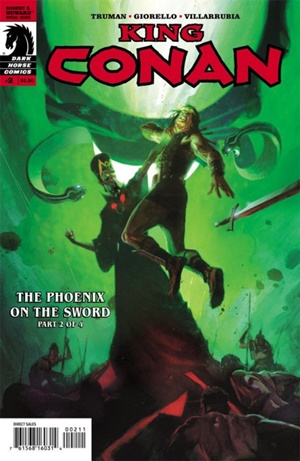 The fight, when the conspirators, with 16 nameless rogues to help, invade the royal bedchamber, is pretty much the same in both stories. Well, to a point…
The fight, when the conspirators, with 16 nameless rogues to help, invade the royal bedchamber, is pretty much the same in both stories. Well, to a point…
Where the “Phoenix” varies is that, in replacing Kull with Conan, Howard makes it a sword and sorcery story. The subplot in “By This Axe I Rule!” involves a young noble, Seno val Dor, who wants to marry Ala, a slave girl. However, such a union is forbidden by Valusian law. And law is inviolate. Even the king is helpless to change it. Seno and Ala cannot wed.
Kull fights off the almost two-dozen invaders, until only Ascalante remains. The rebel has the advantage, until Seno arrives and slays the would-be assassin with a thrown dagger. Ala had overheard the plot and gone to her beloved, who gathered up his men and rushed to the king’s aid.
Kull, wounded and weak, orders the tablet regarding the law of slaves to be brought to him. Once that’s done, he lets his thoughts be known:
“Hear you! I am weary of this business! I am no king but a slave! I am hemmed in by laws, laws, laws! I cannot punish malefactors nor reward my friends because of law – custom – tradition! By Valka, I will be king in fact as well as name!”
He declares that Seno and Ala saved his life, and they may marry. This does not go over well with the traditionalists, as you can well imagine. The king is… unperturbed.
‘”I am the law!” roared Kull, swinging up his axe; it flashed downward and the stone tablet flew into a hundred pieces. The people clenched their hands in horror, waiting dumbly for the sky to fall.’
Thinking outside the box was not exactly encouraged in Valusia.
The speech continues as Kull drives his point home, tossing aside the royal scepter and brandishing the bloody axe. At the end of the story, it’s clear he will rule, enforcing those laws he declares just and discarding those he does not. It certainly seems like the blueprint for an unchallenged despot.
It’s actually a decent enough read and not a bad story.
But for “The Phoenix on the Sword,” Howard completely tosses out the noble-slave love story and the discourse on the suffocating effects of unalterable law. Instead, he brings in the fantastic, making it a sword and sorcery tale.
Now, Conan does wax eloquent on the duties of kingship, just as Kull did. This:
“The trouble with me, Brule – I did not dream far enough. I always visualized merely seizing the throne -I did not look beyond. When King Borna lay dead beneath my feet, and I tore the crown from his gory head, I had reached the ultimate border of my dreams. From there, it has been a maze of illusions and mistakes. I prepared myself to seize the throne – not to hold it.”
Became this:
“I did not dream far enough, Prospero. When King Numedides lay dead at my feet and I tore the crown from his gory head and set it on my own, I had reached the ultimate border of my dreams. I had prepared myself to take the crown, not to hold it. In the old days all I wanted was a sharp sword and a straight path to my enemies. Now the path is straight and my sword is useless.”
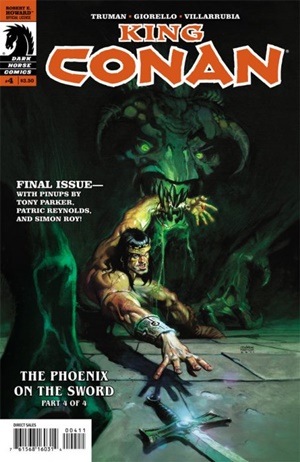 Pretty much the same thing. Though, the writing is a little bit better in the second version. Howard continually honed his skill.
Pretty much the same thing. Though, the writing is a little bit better in the second version. Howard continually honed his skill.
But while the focus of the remainder of the Kull story is instead of fretting over his limitations as king, Howard has Conan dream.
Now, this little dream interlude matters, because Ascalante has a slave named Thoth-Amon. A Stygian, he was once a powerful sorcerer, but he had lost his magical Ring of Set, and was now weak, and in hiding. He is sent to accompany Dion, the totally useless noble, to make sure that the latter doesn’t expose the plot. Dion, who is beyond clueless, has the very ring Thoth Amon seeks. Quickly reclaiming it with a dagger, the sorcerer turns to revenge against Ascalante, using his once-lost dark arts. Unfortunately for Conan, he’s only a few feet away from the potential royal usurper. He’s definitely in the neighborhood of being collateral damage.
Howard was the best prose writer I’ve discovered yet in the fantasy field. He just had a fantastic way with words:
“There was a movement about him, such a swirl as is made in water when some creature rises to the surface. A nameless, freezing wind blew on him briefly, as if from an opened Door. Thoth felt a presence at his back, but he did not look about. He kept his eyes fixed on the moonlit space of marble, on which a tenuous shadow hovered. As he continued his whispered incantations, this shadow grew in size and clarity, until it stood out distinct and horrific. Its outline was not unlike that of a gigantic baboon, but no such baboon ever walked the earth, not even in Stygia. Still, Thoth did not look, but drawing from his gridle, a sandal of his master – always carried in the dim hope that he might be able to put it to such use – he cast it behind him.”
From Thoth Amon staring at the ring he has longed for, through the beast passing by a stunned guard at the palace (which ends chapter three), this is a terrific sequence of writing.
Meanwhile, asleep in his chamber, Conan travels to a magnificent tomb. There he meets the long-dead sage, Epemitrius, who, during his life, fiercely battled the evil snake-god, Set. Epemitrius etches the symbol of a phoenix onto Conan’s sword. Then, Conan wakes in his room and hears stealthy footsteps in the corridor and begins to prepare himself for combat.
The battle scene is similar in both versions, with Kull and Conan trying to avoid harming the mad minstrel (I found that whole ‘a minstrel is greater than a king’ something more fitting for de Camp and Carter than Howard, myself).
With all the rogues either dead or fled (hey, that rhymed!), Ascalante gains the advantage and is about to kill Kull in the original version. Only to have Sena save the day. But there is no Sena and Ala in Conan’s version. And while I think it has been good up to this point, it is here that “The Phoenix on the Sword” really shines and we see Robert E. Howard’s emergence as one of the greatest fantasy writers.
Conan uses his axe-arm to wipe blood from his eyes at precisely the wrong moment. Ascalante, alone and with nothing to lose, rushes at him. The would-be assassin doesn’t quite make it there:
“But even as he began his charge, there was a strange rushing in the air and a heavy weight struck terrifically between his shoulders. He was dashed headlong and great talons sang agonizingly in his flesh. Writhing desperately beneath his attacker, he twisted his head about and started into the face of Nightmare and lunacy. Upon him crouched a great black thing which he knee was born in no sane or human world. Its slavering black fangs were near his throat and the glare of its yellow eyes shriveled his limbs as a killing wind shrivels young corn. The hideousness of its face transcended mere bestiality.”
“In those abhorrent features the outlaw’s dilated eyes seemed to see, like a shadow in the madness that enveloped him, a faint and terrible resemblance to the slave Thoth-Amon.”
I mean, WOW!!! (Yeah, I know. My keen analysis is breathtaking…)
Ascaltante dies of sheer terror: “Then, Ascalante’s cynical and all-sufficient philosophy deserted him, and with a ghastly cry he gave up the ghost before those slavering fangs touched him.”
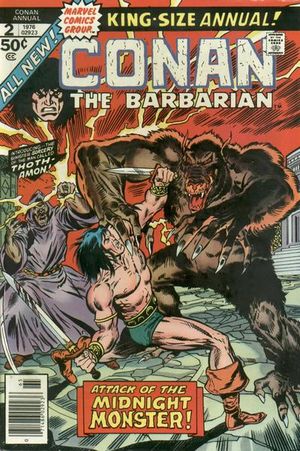 Howard had developed Ascalante in this short story. He is not just a paper-thin supporting character. And he did a fantastic job of having the man, in the absolute horror of his final moments, get at least a flickering understanding that his slave had gotten his revenge. And then, he dies. It’s brilliant work.
Howard had developed Ascalante in this short story. He is not just a paper-thin supporting character. And he did a fantastic job of having the man, in the absolute horror of his final moments, get at least a flickering understanding that his slave had gotten his revenge. And then, he dies. It’s brilliant work.
Which leaves a ‘frozen’ Conan to face this new threat. And in just THREE paragraphs, Howard gives us a marvelous fight between the Cimmerian and the supernatural creature. At this point, I think that “Phoenix” is simply a much more interesting and entertaining story than “Axe!” was.
The creature would have killed Conan, if not for the phoenix etched on his sword by Epimetrius. That allowed the weapon, even though broken earlier in the fight, to fatally wound it.
I think that “By This Axe I Rule!” Is a good enough story. Though, it’s not one I would turn back to very often. Whereas, I’ve re-read “The Phoenix on the Sword” quite a few times. In large part, because I like the swords and sorcery aspect of it.
Thoth Amon was the catalyst, though not actually present, in “The God in the Bowl.” So, Howard had him in mind for two of the first three Conan tales. But he never again used the Stygian sorcerer. And since “Bowl” was rejected by Wright and not published until 1952, he was effectively a one-shot character in the authentic Conan Canon.
That changed, however, when L. Sprague de Camp decided to make him the main antagonist in the barbarian’s life, as he laid out the original and ‘new’ tales as a Conan Saga. The Marvel comics also utilized Thoth Amon, so that he is now generally considered ‘the’ Conan villain.
While it’s not the best Conan story written by Howard, I do think it’s the perfect introduction to Conan. He already has many exploits behind him and is now a king. It’s got a royal assassination plot: and sorcery. And it has the quality writing characteristic of much of Howard’s work.
2025 (3)
Shelfie – Dashiell Hammett
Windy City Pulp & Paper Fest – 2025
Will Murray on Who was N.V. Romero?
2024 Series (11)
Will Murray on Dashiell Hammett’s Elusive Glass Key
Ya Gotta Ask – Reprise
Rex Stout’s “The Mother of Invention”
Dime Detective, August, 1941
John D. MacDonald’s “Ring Around the Readhead”
Harboiled Manila – Raoul Whitfield’s Jo Gar
7 Upcoming A (Black) Gat in the Hand Attractions
Paul Cain’s Fast One (my intro)
Dashiell Hammett – The Girl with the Silver Eyes (my intro)
Richard Demming’s Manville Moon
More Thrilling Adventures from REH
Prior Posts in A (Black) Gat in the Hand – 2023 Series (15)
Back Down those Mean Streets in 2023
Will Murray on Hammett Didn’t Write “The Diamond Wager”
Dashiell Hammett – ZigZags of Treachery (my intro)
Ten Pulp Things I Think I Think
Evan Lewis on Cleve Adams
T,T, Flynn’s Mike & Trixie (The ‘Lost Intro’)
John Bullard on REH’s Rough and Ready Clowns of the West – Part I (Breckenridge Elkins)
John Bullard on REH’s Rough and Ready Clowns of the West – Part II
William Patrick Murray on Supernatural Westerns, and Crossing Genres
Erle Stanley Gardner’s ‘Getting Away With Murder (And ‘A Black (Gat)’ turns 100!)
James Reasoner on Robert E. Howard’s Trail Towns of the old West
Frank Schildiner on Solomon Kane
Paul Bishop on The Fists of Robert E. Howard
John Lawrence’s Cass Blue
Dave Hardy on REH’s El Borak
Prior posts in A (Black) Gat in the Hand – 2022 Series (16)
 Asimov – Sci Fi Meets the Police Procedural
Asimov – Sci Fi Meets the Police Procedural
The Adventures of Christopher London
Weird Menace from Robert E. Howard
Spicy Adventures from Robert E. Howard
Thrilling Adventures from Robert E. Howard
Norbert Davis’ “The Gin Monkey”
Tracer Bullet
Shovel’s Painful Predicament
Back Porch Pulp #1
Wally Conger on ‘The Hollywood Troubleshooter Saga’
Arsenic and Old Lace
David Dodge
Glen Cook’s Garrett, PI
John Leslie’s Key West Private Eye
Back Porch Pulp #2
Norbert Davis’ Max Latin
Prior posts in A (Black) Gat in the Hand – 2021 Series (7 )
The Forgotten Black Masker – Norbert Davis
Appaloosa
A (Black) Gat in the Hand is Back!
Black Mask – March, 1932
Three Gun Terry Mack & Carroll John Daly
Bounty Hunters & Bail Bondsmen
Norbert Davis in Black Mask – Volume 1
Prior posts in A (Black) Gat in the Hand – 2020 Series (21)
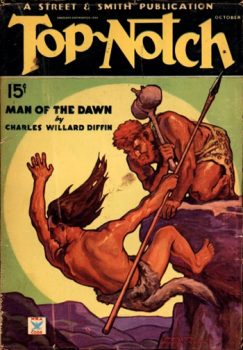 Hardboiled May on TCM
Hardboiled May on TCM
Some Hardboiled streaming options
Johnny O’Clock (Dick Powell)
Hardboiled June on TCM
Bullets or Ballots (Humphrey Bogart)
Phililp Marlowe – Private Eye (Powers Boothe)
Cool and Lam
All Through the Night (Bogart)
Dick Powell as Yours Truly, Johnny Dollar
Hardboiled July on TCM
YTJD – The Emily Braddock Matter (John Lund)
Richard Diamond – The Betty Moran Case (Dick Powell)
Bold Venture (Bogart & Bacall)
Hardboiled August on TCM
Norbert Davis – ‘Have one on the House’
with Steven H Silver: C.M. Kornbluth’s Pulp
Norbert Davis – ‘Don’t You Cry for Me’
Talking About Philip Marlowe
Steven H Silver Asks you to Name This Movie
Cajun Hardboiled – Dave Robicheaux
More Cool & Lam from Hard Case Crime
A (Black) Gat in the Hand – 2019 Series (15)
Back Deck Pulp Returns
A (Black) Gat in the Hand Returns
Will Murray on Doc Savage
Hugh B. Cave’s Peter Kane
Paul Bishop on Lance Spearman
A Man Called Spade
Hard Boiled Holmes
Duane Spurlock on T.T. Flynn
Andrew Salmon on Montreal Noir
Frank Schildiner on The Bad Guys of Pulp
Steve Scott on John D. MacDonald’s ‘Park Falkner’
William Patrick Murray on The Spider
John D. MacDonald & Mickey Spillane
Norbert Davis goes West(ern)
Bill Crider on The Brass Cupcake
A (Black) Gat in the Hand – 2018 Series (32)
George Harmon Coxe
Raoul Whitfield
Some Hard Boiled Anthologies
Frederick Nebel’s Donahue
Thomas Walsh
Black Mask – January, 1935
Norbert Davis’ Ben Shaley
D.L. Champion’s Rex Sackler
Dime Detective – August, 1939
Back Deck Pulp #1
W.T. Ballard’s Bill Lennox
Erle Stanley Gardner’s The Phantom Crook (Ed Jenkins)
Day Keene
Black Mask – October, 1933
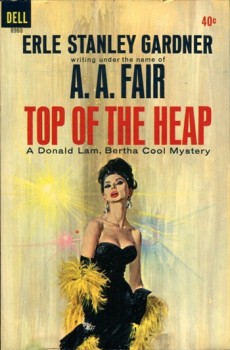 Back Deck Pulp #2
Back Deck Pulp #2
Black Mask – Spring, 2017
Erle Stanley Gardner’s ‘The Shrieking Skeleton’
Frank Schildiner’s ‘Max Allen Collins & The Hard Boiled Hero’
A (Black) Gat in the Hand: William Campbell Gault
A (Black) Gat in the Hand: More Cool & Lam From Hard Case Crime
MORE Cool & Lam!!!!
Thomas Parker’s ‘They Shoot Horses, Don’t They?’
Joe Bonadonna’s ‘Hardboiled Film Noir’ (Part One)
Joe Bonadonna’s ‘Hardboiled Film Noir’ (Part Two)
William Patrick Maynard’s ‘The Yellow Peril’
Andrew P Salmon’s ‘Frederick C. Davis’
Rory Gallagher’s ‘Continental Op’
Back Deck Pulp #3
Back Deck Pulp #4
Back Deck Pulp #5
Joe ‘Cap’ Shaw on Writing
Back Deck Pulp #6
The Black Mask Dinner

Bob Byrne’s ‘A (Black) Gat in the Hand’ made its Black Gate debut in 2018 and has returned every summer since.
His ‘The Public Life of Sherlock Holmes’ column ran every Monday morning at Black Gate from March, 2014 through March, 2017. And he irregularly posts on Rex Stout’s gargantuan detective in ‘Nero Wolfe’s Brownstone.’ He is a member of the Praed Street Irregulars, founded www.SolarPons.com (the only website dedicated to the ‘Sherlock Holmes of Praed Street’).
He organized Black Gate’s award-nominated ‘Discovering Robert E. Howard’ series, as well as the award-winning ‘Hither Came Conan’ series. Which is now part of THE Definitive guide to Conan. He also organized 2023’s ‘Talking Tolkien.’
He has contributed stories to The MX Book of New Sherlock Holmes Stories — Parts III, IV, V, VI, XXI, and XXXIII.
He has written introductions for Steeger Books, and appeared in several magazines, including Black Mask, Sherlock Holmes Mystery Magazine, The Strand Magazine, and Sherlock Magazine.
You can definitely ‘experience the Bobness’ at Jason Waltz’s ’24? in 42′ podcast.
A Challenge Worth Smiling About: Tim Waggoner on Writing Conan

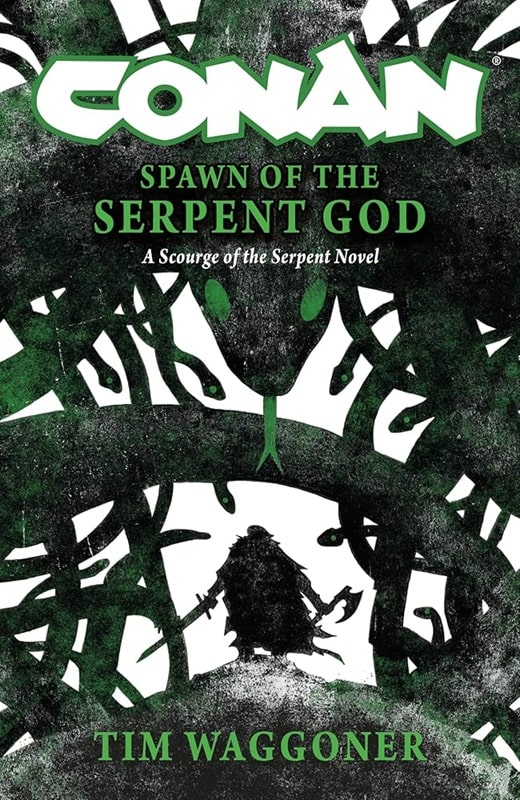
Tim Waggoner, and his upcoming novel Conan: Spawn of the Serpent God (Titan Books, October 28, 2025)
On a non-descript day I am intercepted on entering a coffee shop. It turns out to be a happy accident, an old colleague, eager to join me as I wait for my next interview to begin. The distraction is welcome but doesn’t help much. My interviewee isn’t late but they aren’t early either and I’m beginning to get nervous.
“You’re waiting for him, aren’t you?” the friend asks.
Neither of us mentioned his name because we didn’t have to. Some things, in certain contexts, go together like cheese and tortillas. With four Stoker Awards and many great novels to his name, Tim Waggoner has developed that kind of reputation in this part of Ohio. If Massachusetts is Lovecraft Country then downtown Dayton is Waggonerstan.
[Click the images for Conan-sized versions.]
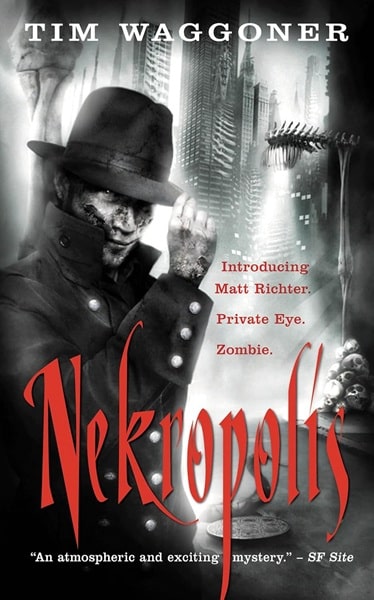
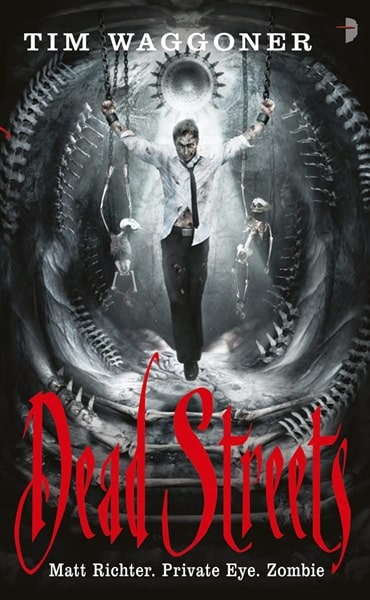
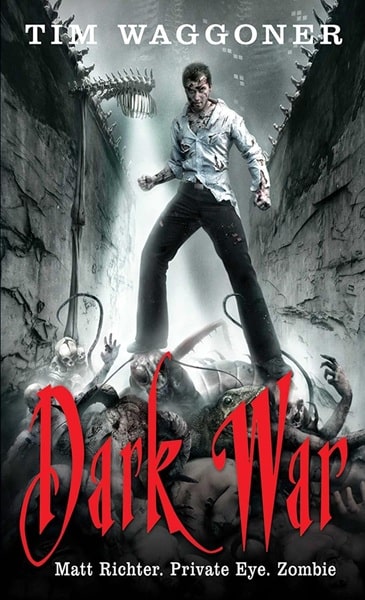
The Nekropolis series by Tim Waggoner: Nekropolis, Dead Streets, and
Dark War (Angry Robot, 2009, 2010, and 2011). Covers by Vincent Chong
“What’s the interview about?”
I swerve the question because this former colleague is a journalist too. When it comes to what Waggoner has to say about the novel we’ve come to talk about, I’d rather get it in Black Gate first. A book the author later estimates is the 62nd or 63rd of his career.
That brief period of forbearance is soon rewarded when Waggoner arrives. I can tell he’s been busy cooking up something special with his new novel. It does not take long before coffee and talk of Conan begins to flow.
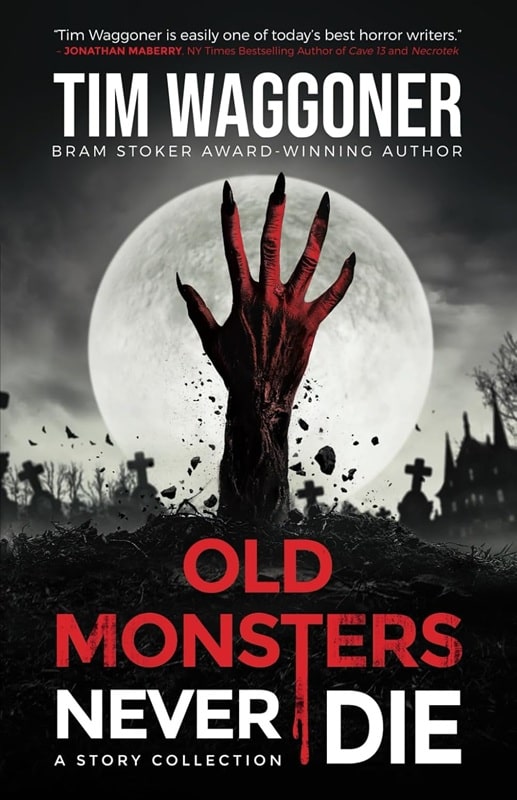
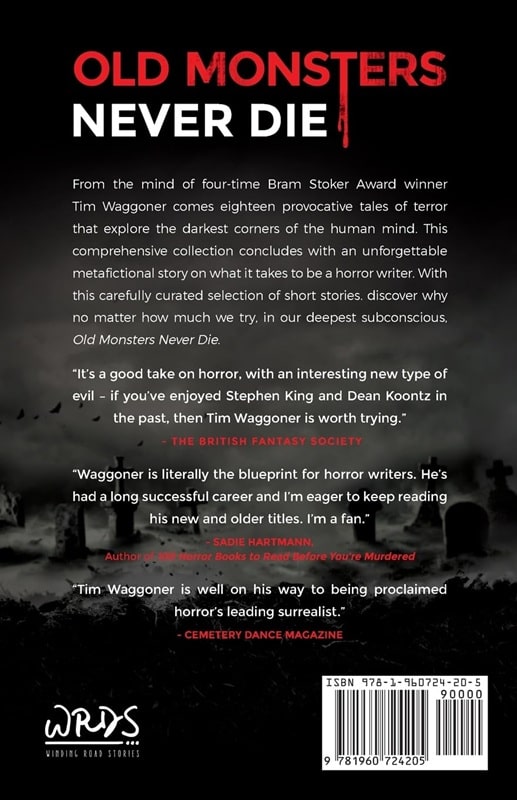
Old Monsters Never Die: A Story Collection by Tim Waggoner
(Winding Road Stories, May 24, 2024). Cover art uncredited
Anyone familiar with Waggoner’s literary career knows he’s worn many hats over the years, dipping his proverbial toe in one genre or another. There’s the Nekropolis series, the fantasy Blade of the Flame novels, and award-winning books on the craft of writing such as Writing in the Dark. Even among those massive projects, trilogies, and the travails every writer faces, working on a Conan novel was a special challenge. In fact, that’s exactly why the first time opportunity came knocking he said no.
“My agent told me Titan was doing Conan and asked if I was interested. I just thought there was no way I could do it because it’s not just about Conan but also the world he inhabited. It’s a very realized world with multiple countries. I just didn’t know if I could do it. After saying no the first time, when I was asked again I just had to do it. I said yes and immersed myself in all the Conan stories I could,” Waggoner told me.
That meant diving deep into the lore of the famous barbarian, going back to the original stories and working his way up to Titan’s ongoing series. It’s clear, however, that like many fantasy fans Waggoner was not coming to Conan blind. This certainly wasn’t his first time in the Hyborian Age.
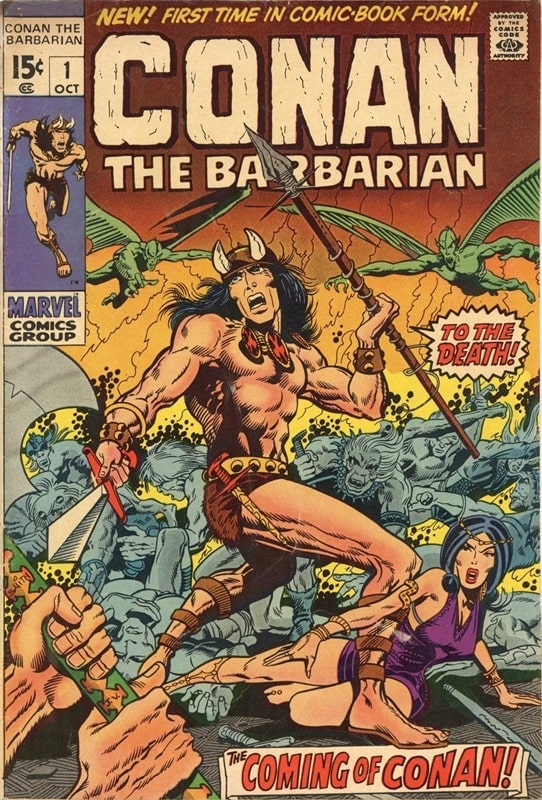

Marvel Comics Conan the Barbarian, issue #1 (Marvel Comics, October, 1970). Cover by Barry Windsor-Smith
“Most of my experience with Conan had been with the comics. As a kid I knew him mostly through Marvel Comics. I had the very first issue for years and wish I’d kept it. I don’t know what happened to it. Probably fell apart I read it so often.”
Through cultural osmosis he learned more about the character through films and other comics. But going back to the original well of creativity that spawned one of fantasy’s greatest protagonists taught him a lot that would serve him well during the writing process. He listened to them on audiobook and read them at home. Waggoner also went on to read the King Kull stories, El Borak, and even Solomon Kane. But it was the stories about Conan that were most integral.
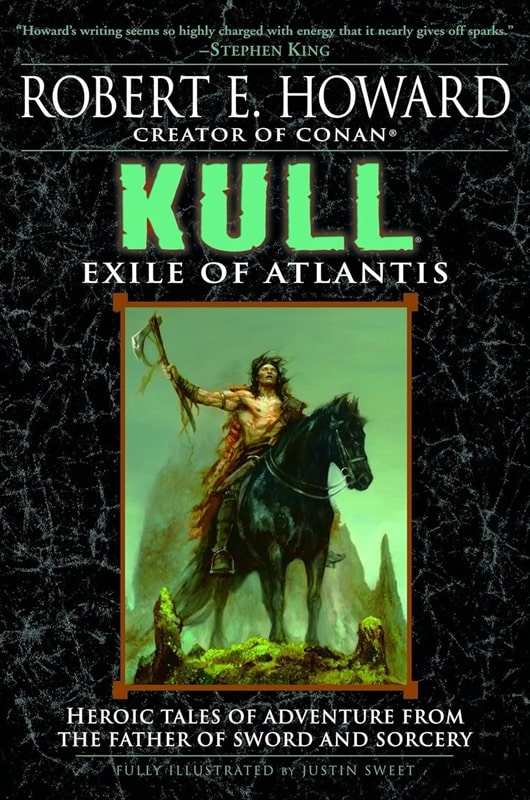
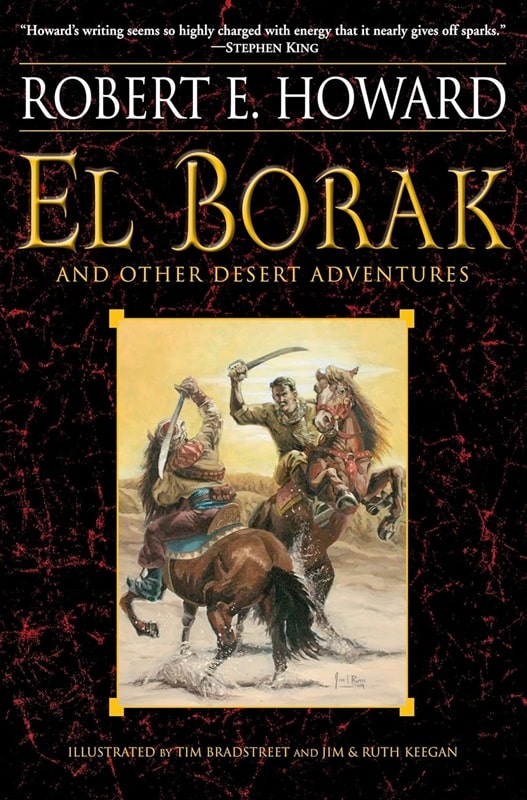
Two Del Rey Robert E. Howard volumes: Kull: Exile of Atlantis, and El Borak and Other Desert
Adventures. (October 31, 2006, and February 9, 2010). Covers by Justin Sweet, and Jim & Ruth Keegan
“It really helped me because the one thing I didn’t get in the comics or in the movies is how much a part of the story the setting is,” he said. “It took me forever to get started on it. I couldn’t figure out where to start but eventually it clicked overall. But a big part of it was realizing the setting was a big part of the story.”
Writing the book was an experience Waggoner described as ‘intimidating’. Who can blame him? Even with decades of experience, taking on a character with such a rich history and fans spanning the globe would challenge anyone.
“I had to try and think of what my version of Conan was because no matter what I knew I wouldn’t be able to write his,” said Waggoner in reference to Howard. “Part of what I did is work that out on the page. Here’s this guy who will critique civilization even as he is drawn to it. I asked myself, ‘why does he do that?’”
One aspect of Conan that fascinated Waggoner is his evolution over time, from thief to pirate to mercenary and eventually king. As the author explains, Cimmerians generally don’t travel outside Cimmeria. Finding out where that thirst for adventure came from was integral to understanding the character.

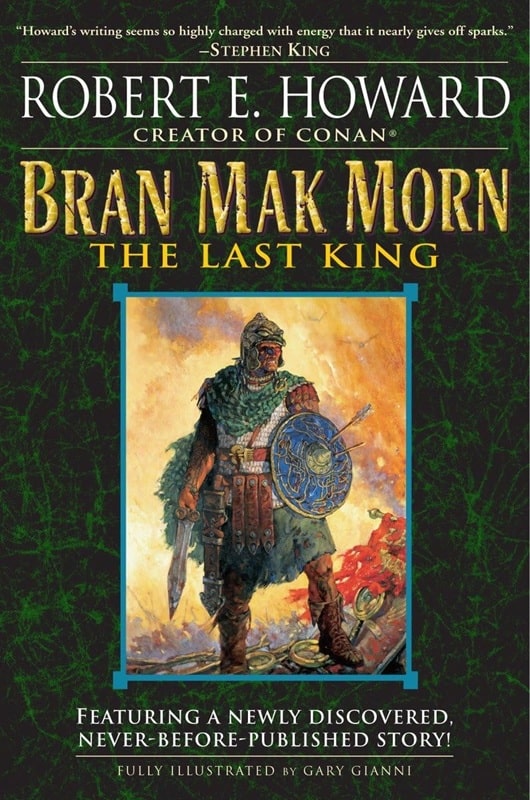
Two more Del Rey Howards: The Savage Tales of Solomon Kane and
Bran Mak Morn: The Last King (July 2004 and June 2005). Covers by Gary Gianni
“I did find out that in a letter Robert E. Howard wrote that Conan’s grandfather had traveled some, told him stories as a kid, and that was of what woke that in him. While he (Howard) never wrote it in a story that helped me see where part of that aspect of Conan came from. But part of that is just his nature too,” Waggoner explained.
The novel, according to Waggoner, will show readers two sides of the barbarian with the story focused on Conan’s life at 17 and 32. It’s a two-part story separated by 15 years, which helped the author show the titular character’s growth over time. This can be seen in his natural cursiotiy as a teenage thief as well as in his expansive knowledge of other languages and cultures later on. Conan’s interactions with religion and the origin of his unique sense of chivalry are also touched on in the book.
“That’s because when I write any kind of tie-in like this I try to imagine them as real people. If I’m trying to write about Conan being real then I have to ask myself why does he do these sorts of things and why are they so important to his character?”
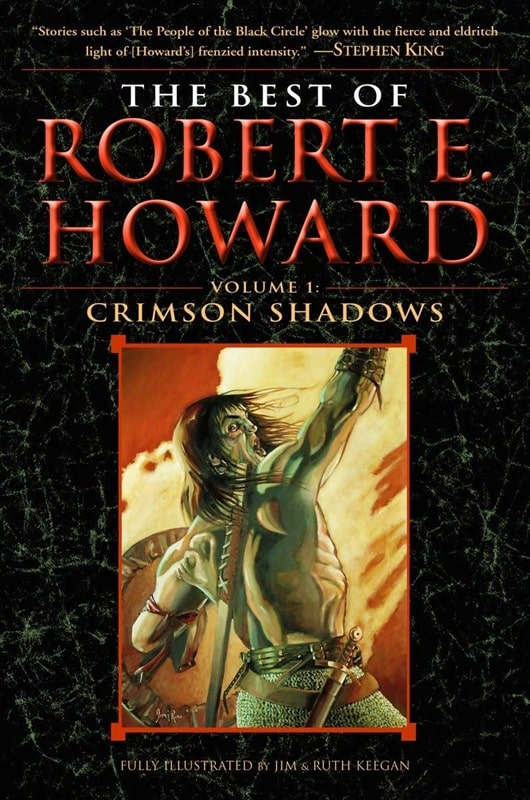

The Best of Robert E. Howard, Volumes 1 & 2: Crimson Shadows and Grim Lands
(Del Rey, August 31, 2009 and December 2007). Covers by Jim Keegan and Ruth Keegan
Its an approach that has worked well in the past and allowed him to touch on a part of Conan a some have missed in the past.
“I think one thing some of the comics and movies miss is that while he (Conan) is dour and grim, that’s not all he is. Howard says in that one description ‘gigantic mirths and gigantic melancholies’. The mirth part you don’t see very much. I tried to put some of that in there. I also tried to show how he had a lot more anger and was quicker to violence at 17 than he was at 32. Over time, he becomes a lot more skilled.”
Of course, given the amount of time left between now and the book’s listed Oct. 27 publication date, things may change and edits might be made. Waggoner admits that some of what he wrote might be edited out though he is hopeful. Midway through the conversation I mention Conan’s connection to Cthulhu and Waggoner’s answer leaves me hopeful too.
“I tried to include some of that too,” he said with a smile.
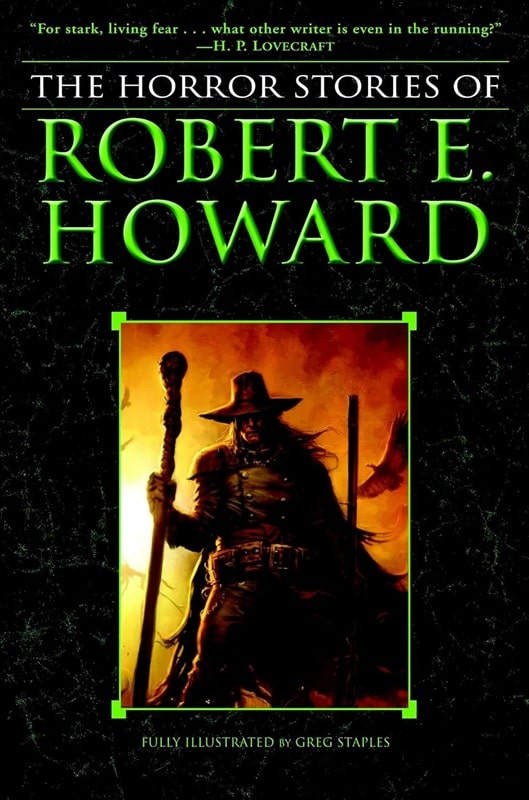
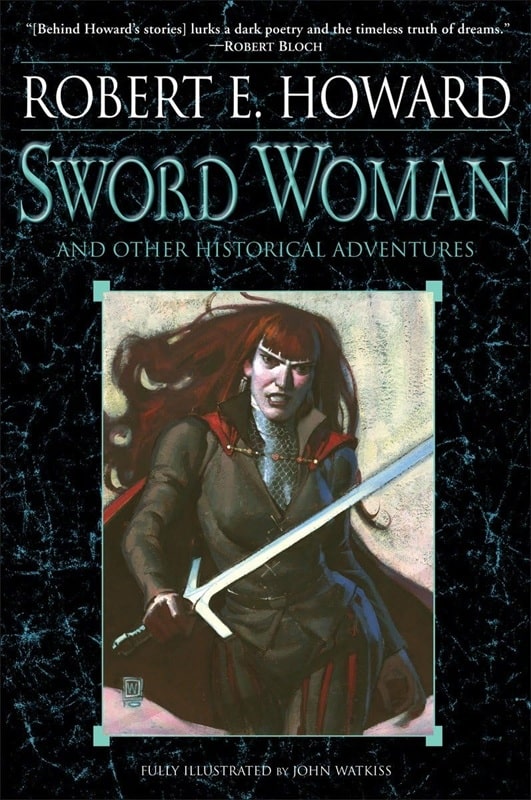
The Horror Stories of Robert E. Howard and Sword Woman (Del Rey,
July 29, 2008 and January 25, 2011). Covers by Greg Staples and John Watkiss
Regardless, its clear a ton of work has gone into making the novel as best as it can be. When Conan: Spawn of the Serpent God does come out, it will be a welcome addition to many bookshelves around the world. And if Titan’s release schedule is anything to go by, the beloved sword-wielding warrior shows no signs of slowing down. Conan, its no exaggeration to say, is thriving.
“I think he’s endured so long because he’s the same sort of character, ultimately, as the lone gunslinger or the private eye. He’s the individual that is true to himself and can be himself in whatever society he’s in,” Waggoner said.
But there is one other ingredient the author feels separates Conan from the pack. One so important it leaves other legacy characters like Sam Spade and The Shadow in the dust.
“With Conan his motive ultimately is adventure. It’s living life and experiencing it absolutely to the fullest. You don’t see that in a lot of warrior type characters. You don’t see that in the lone gunslinger. The private eye is usually depressed. Conan, however, I don’t think we even know what happens to him at the end of his life because eventually he tells his son ’you be king, I’m out of here’ and just goes adventuring all over again,” Waggoner said with a laugh.
Ismail D. Soldan is an author, journalist, and poet. His work has previously appeared in Illustrated Worlds, LatineLit, and The Acentos Review among other publications. A proud explorer of both real and imagined worlds, his most recently published short story can be read in the January 2025 issue of Crimson Quill Quarterly, and his last article for Black Gate was New Adventures for the World’s Favorite Barbarian.
Tubi Dive, Part V


Meatball Machine and Meatball Machine Kodoku (TLA Releasing, 2005 and 2017)
50 films that I dug up on Tubi.
Enjoy!
Meatball Machine (2005) and Meatball Machine Kodoku (2017)It’s a double-header in more ways than one, as I settled down to watch a couple of films that bookend a period known to cinephiles as Gonzo Japanese Splatter. Between these films, we were served up classics such as Tokyo Gore Police, Machine Girl, and the afore-reviewed Toilet of the Dead and Dead Sushi, but those are just the tip of the grue-coated iceberg.
If you are familiar with Tetsuo: The Iron Man from 1989, you’ll already have a grasp of the themes in these films; isolation, sexual desire, transformation, body horror and extreme gore.
Meatball Machine was directed by Yūdai Yamaguchi with effects by long-time Noboru Iguchi collaborator Yoshihiro Nishimura (Nishimura would later go on to direct the Meatball sequel). It looks like it was shot on digital video, with blown out colors, and I’m not a fan, but that could also be down to the dodgy copy Tubi has.
The story concerns Yōji, a downtrodden young man who has a rubbish job and stifles his loneliness by pining for a young woman, Sachiko, whom he watches from afar during his lunch breaks. In the background of this sob story, we learn that parasites are taking over people and mutating them into killing machines, for reasons.
Yōji stumbles across the carapace of one of these creatures and takes it home. One night, after saving Sachiko from a sexual assault, they finally get to sit and talk, and discover they are both lonely. This is all building up to a sweet moment, but then the carapace springs into life, attaching itself to Sachiko and OH MY FREAKING GOD. Yamaguchi cranks everything up to 11 and covers everyone in dripping gore throughout the rest of the film. It’s wild, utterly bonkers, and ridiculously entertaining (if you like that sort of thing, you disgusting person, you). Multiple fights and plot twists ensue, and a new sub-genre is kickstarted into horrific life.
Meatball Machine Kodoku takes the idea in a completely different direction, leaning heavily into an aliens angle while also expanding upon the lore. Director Nishimura, always on the lookout to outdo himself and everyone else in the genre, goes completely potty, coming up with some of the weirdest and most wonderful body transformations I have ever seen.
In this film, Yuji, a downtrodden, middle-aged man who hates his debt collecting job, secretly pines for a cute young woman, Kaoru, who works in his local bookstore. When he saves her from a potential assault, they finally get together and, yes, you guessed it, everything goes to poop. So far, so very similar.
However, this time the parasites infest a whole city, not only that, but they trap the entire city in a giant alien bell jar, and let everyone kill each other. For reasons.
One aspect I enjoyed about this one was that when mutated by a parasite, your body’s weapon is the thing you are most recently connected to. So a construction worker gets a jackhammer for an arm, while a burlesque dancer who was eating spaghetti ends up with a fork. It’s especially fun watching the parasites control their hosts with outlandish levers in their little pod ‘brains.’ This film is actually light on horror for the first 30 minutes, and then BOOM — a chopped off willy and a bisected pair of lovers kick off the whole shebang — and it all gets set to ludicrous speed.
It’s hard to elicit any sympathy for Yōji and Yuji, as in both films they immediately objectify their love interests, but in the end you can’t help rooting for them.
Naturally, if you have an aversion to extreme body horror, writhing tendrils, copious amounts of gore, boob and pantie obsessions and tasteless deaths, then these aren’t the films for you. However, I laughed a lot, and not necessarily at the right moments.
Let me know if you watch them!
7/10 and 8/10 respectively
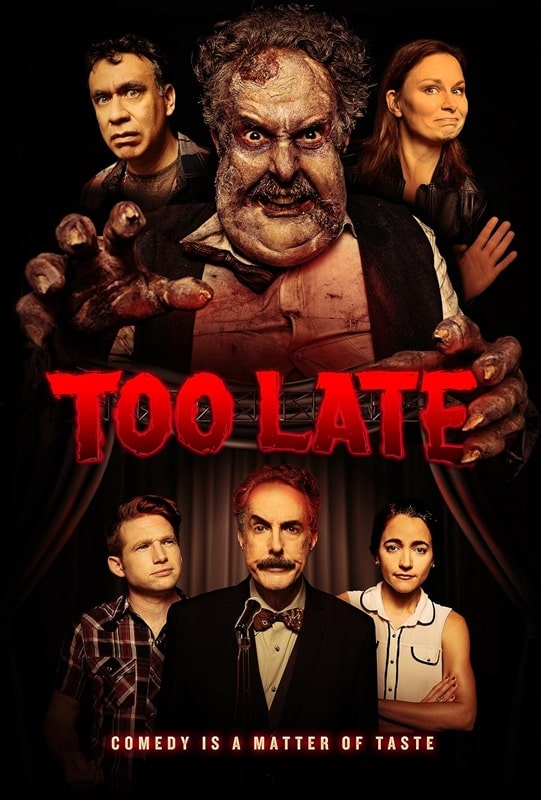

Too Late (Vanishing Angle, June 11, 2015) and Chawz (Lotte Entertainment, July 16, 2009)
Taking a break from gonzo Asian splatter-fests, I found myself settling in for what one might describe as a ‘cozy’ horror-comedy. Personally, I’d describe it as a missed opportunity, but a cursory glance at other reviews reveals I’m in the minority, so what do I know?
Violet (Alyssa Limperis) is the assistant to a famous stand-up comedian, Bob Devore (Ron Lynch), and she helps him find new talent for his late-night live show, Too Late. He doesn’t just need raw talent to entertain his crowds though, as Bob is a supernaturally old, shape-shifting monster that has to eat every four weeks. He’s been in the entertainment business a very long time, and only the most talented acts will sate his hunger. When Violet falls in love with one of his potential meals, she must find a way to terminate her contract and save herself. And that’s about the gist of it. A not-so-subtle allegory for the destructive nature of showbiz.
I’m good with this. It’s a solid concept and the film is well-shot and directed, and for the most part well acted. Fred Armisen and Mary Lynn Rajskub pop up for short cameos, mainly, I suspect, to help get the film funded and to put on the DVD cover, and the rest of the cast is filled out with the usual roster of genre types. They all do their jobs admirably. The horror itself is fairly tame, and other than a shot at the end, relatively bloodless, and I didn’t mind that either.
What I did object to though was the notion that this all takes place against the backdrop of a comedy club, and not a single one of the performers was funny. I get it. Comedy is subjective, but come on, some of this was the dullest observational humour I have ever heard. Not the main focus of the story, but it still irked me enough to get salty as I watched it.
Bottom line, OK.
5/10
Chawz (aka Chaw) (2009)The Korean title Chaw translates to ‘trap’, but this creature feature wears its influences on such a large sleeve, that it was rebranded to Chawz for its US release, capitalizing on that old shark movie.
I’ve been a sucker for giant, mutant boar movies ever since I first watched Russell Malcahy’s Razorback back in the day. Sadly, they are a bit thin on the ground, but this is a good one, so I’m glad I caught up with it.
It’s your usual monster movie fare; giant creature terrorizes a village, eats folk, is a bit of a nuisance etc., plucky group of tropes band together to hunt it down. So far, nothing new. However, this being a Korean film, it has to meet the 2 hour run time, so there is a lot more going on with a broad roster of characters. We have a fish out of water tale with Kim Kang-soo, a freshly transferred cop, a revenge tale with Chun Il-man wanting to avenge his grand-daughter’s savage death, some light comedy via a clutch of goofy cops and hangers-on, a doomed romance, a crazy lady, an incompetent official, etc etc.
It’s a lot to follow, and the film would benefit from a bit of pruning, but on the whole I had fun with it. The monster effects are fine; a combination of puppetry and B-tier CG, and there are plenty of homages littered throughout to prompt a drinking game.
It’s no The Host, but still worth a look.
7/10
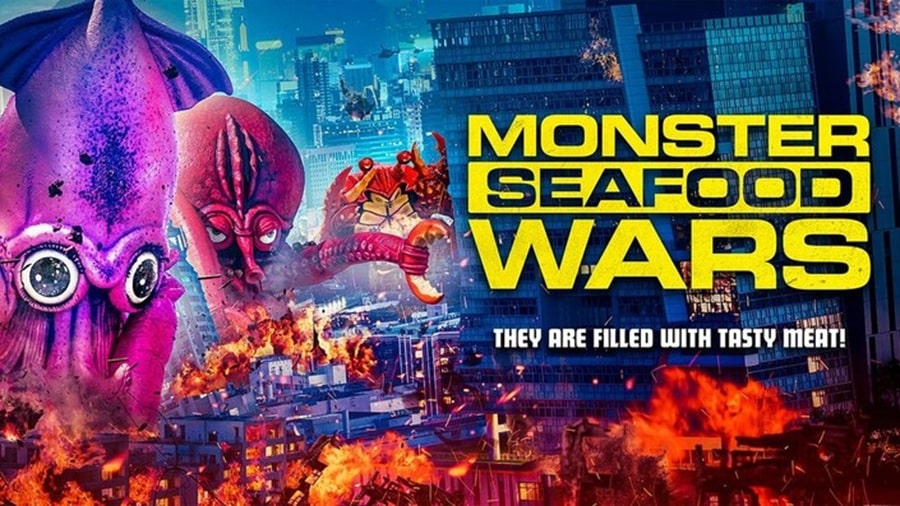 Monster Seafood Wars (Pal Entertainments, June 6, 2020)
Monster Seafood Wars (2020)
Monster Seafood Wars (Pal Entertainments, June 6, 2020)
Monster Seafood Wars (2020)
Never one to turn my nose up at a kaiju slam-fest, I started this one with some trepidation, and was wise to do so. It’s all rather maddening. Stuck inside this ‘comedy’ is a decent monster flick idea; a young slacker scientist creates a serum that can make creatures grow huge in an effort to cure world hunger. His invention is stolen by a nefarious rival, who also steals his shrine offerings (a squid, an octopus and a crab), which are then mutated to ridiculous size and promptly go on a rampage.
The aspect I really enjoyed was the fact that the populace discovers these kaiju are delicious, and so they are happy to let them fight while they control them with vinegar cannons, so that chunks get knocked off and turned into gourmet dishes. That’s what the story should have focused on — it’s a great hook that could allow some excellent moral dilemmas, but instead we have to wade through a tedious love triangle and unnecessary ‘mockumentary’ interviews with the witnesses to the shenanigans.
It also doesn’t help that the monsters themselves are cutesy mascot-style designs with googly eyes and fixed expressions. I wonder how awesome this film could be with realistic creatures and a focus on their deliciousness.
Oh well.
5/10
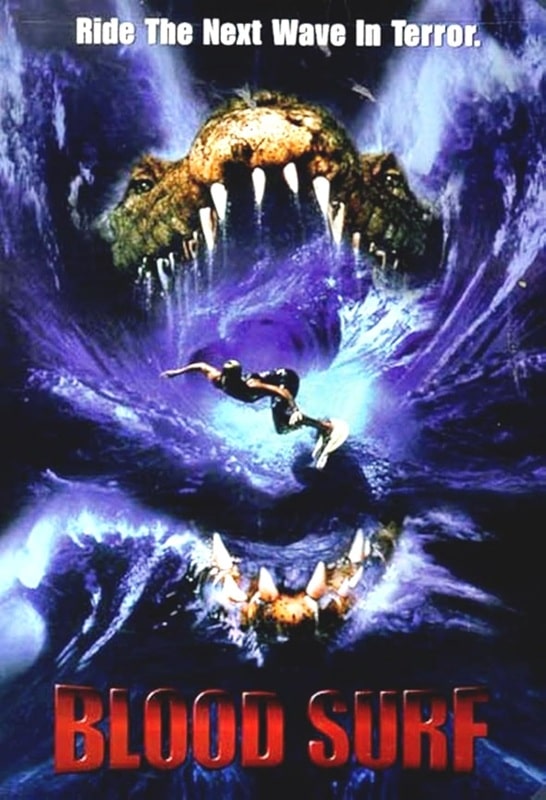

Blood Surf (Trimark Pictures, December 4, 2000) and Body Melt (Beyond Distribution, December 15, 1993)
If you know me by now, I’m always up for a killer crocodile/alligator flick, and when I learned that the late, great John Carl Buechler was responsible for the reptile effects, I got mistakenly excited.
You see, it’s a film about a hugely unlikable group of MTV brats who want to film themselves surfing with chum-crazed sharks, but instead get roped into a croc of shit. The effects are not good, lots of dodgy superimposition, and the filmmakers had no idea how to shoot the big croc puppet. The script is aggressively dumb, the actors deliver their stupid lines with zero interest, and the whole thing is a crushing bore.
What with a Jürgen Prochnow ordered off of Wish, a Matthew Lilliard/Seann William Scott hybrid, and two girls flashing their tits at the beast before one says, “I guess that’s what you call a croc tease,” I was done with it all.
The one single redeeming feature was that one character was called Melba, which allows me to make a ‘Melba was quickly toast’ joke.
Bah.
1/10
Body Melt (1993)Here’s a strange one from down under — a gonzo, sci-fi, body-horror goo-a-thon starring Ian (Harold Bishop from Neighbours) Smith as an evil doctor. Brilliant bit of casting.
The story is about an immoral pharmaceutical company that doles out free pills to the residents of a small community, and then records the various side-effects. Side effects include: exploding body parts (heads, willies, that sort of thing), sentient placentas, randomly placed tentacles, cannibalism, and various amounts of melting.
As you might be able to discern, there are no set rules to the side-effects, and this is the downside to the film. Rather than tell a coherent story, it plays out more as a series of gloopy vignettes, and we really don’t have a main protagonist to follow.
That said, it’s quite ridiculously fun, and there’s plenty of weird stuff going on (and one or two big laughs), so I’m recommending it to all the weirdos out there.
6/10
Previous Murkey Movie surveys from Neil Baker include:
Tubi Dive, Part I
Tubi Dive, Part II
Tubi Dive, Part III
Tubi Dive, Part IV
What Possessed You?
Fan of the Cave Bear
There, Wolves
What a Croc
Prehistrionics
Jumping the Shark
Alien Overlords
Biggus Footus
I Like Big Bugs and I Cannot Lie
The Weird, Weird West
Warrior Women Watch-a-thon
Neil Baker’s last article for us was Part IV of Tubi Dive. Neil spends his days watching dodgy movies, most of them terrible, in the hope that you might be inspired to watch them too. He is often asked why he doesn’t watch ‘proper’ films, and he honestly doesn’t have a good answer. He is an author, illustrator, teacher, and sculptor of turtle exhibits. (AprilMoonBooks.com).
Tor Doubles #5: Poul Anderson’s No Truce with Kings and Fritz Leiber’s Ship of Shadows
 Cover for No Truce with Kings by Royo
Cover for No Truce with Kings by RoyoCover for Ship of Shadows by Robin Wood
Both Poul Anderson’s No Truce for Kings and Fritz Leiber’s Ship of Shadows originally appeared in issues of The Magazine of Fantasy and Science Fiction, Not only did their initial publication occur in the same periodical, but both of those original issues sported covers painted by Ed Emshwiller.
No Truce for Kings was originally published in F&SF in June, 1963. It won the Hugo Award and received a Prometheus Hall of Fame Award in 2010. No Truce for Kings In is the first of three Anderson stories to be published in the Tor Doubles series.
Colonel James Mackenzie is the commander of Fort Nakamura in a post-apocalyptic California who receives a message that Judge Brodsky has been deposed and replaced by Judge Fallon. This message is the indication to Mackenzie that a civil war has broken out. Although Mackenzie and his troops are loyal to the old regime, the letter makes it clear that Mackenzie’s son-in-law, Thomas Danielis, is aligned with the rebels, as well as serving as a hostage for the troops who are coming to relieve Mackenzie of his command.
The story alternates between Mackenzie’s and Danielis’ actions in the subsequent war, and although Anderson includes many indicators of what the old regime looked like, with a series of local feudal lords called bossmen, and the attempts to destroy that society by the forces of Fallon and his allies, the use of time jumps throughout the story give it a somewhat disjointed feel. However, the use of a Mackenzie and Danielis, as relatives, along with the occasional appearance and frequent mention of Laura, Mackenzie’s daughter and Danielis’ wife, as well as her pregnancy and the birth of her child, combine to give the discussions of tactics and strategies a more personal flavor throughout the story.
While No Truce for Kings starts out as a pretty generic post-apocalyptic story, Anderson adds in an alien element that sets it apart. His aliens, who mostly appear in conversation with themselves as observers of the actions of the humans seem as if they are a response to the psychohistorians of Isaac Asimov’s Foundation series, which was originally published twelve years before No Truce for Kings. These aliens make use of psychodynamicism to guide the events of the humans as they come out of the fall of civilizations. Furthermore, while Asimov created the religion of scientism to help guide the galaxy, Anderson’s aliens have introduced Espers, people who ostensibly have psychic abilities.
The interludes have only a minor direct impact on the action of the story, but they allow Anderson to provide the information the reader needs so the main characters can continue interacting with their world without providing a data dump and allows the reader to have additional background knowledge they don’t have. When Mackenzie comes into contact with a group of Espers, who are theoretically neutral in the war between Fallon and Brodsky, the information Anderson has provided in the discussion of his aliens provides more depth to the Espers’ actions that may seem odd to Mackenzie but can be explained away, except the reader has an understanding where he has gone wrong.
Anderson doesn’t just place Danielis and his father in law on opposite sides of the war, he provides them with a reason for being on those sides. Mackenzie grew up in the system of bossmen and thrived because of it. To him it was the natural order of things. Danielis was an orphan who had to work his way up through the system, eventually succeeding in a military career. He was helped along the way by the Espers, and although they were officially neutral, there is no point in the story that it doesn’t seem like common knowledge that they are supportive of Fallon’s rebellion.
Eventually, of course, the existence of the aliens becomes known and changes the course of the war. The forces of Fallon and Brodsky, all of whom are aware that there was once a more unified country that had collapsed and all of whom have hopes to reestablish in their own ways, suddenly become aware that there is more out there, and can offer them a higher level of technology than humans had previously had access to. This is an area that Anderson had previously explored in works like The High Crusade, published three years before No Truce for Kings. Although Anderson addresses the dichotomy of science, it is done in an almost cursory manner, providing the story with something of an anticlimax from that point of view.
At the same time, his decision to follow Danielis and Mackenzie throughout, focusing on their experiences and the stresses caused by the knowledge that they were on opposite sides of the civil war, imbues the story with a human connection that ultimately does come to a satisfying conclusion, even if the situation does not allow for a happy outcome for all who are involved.
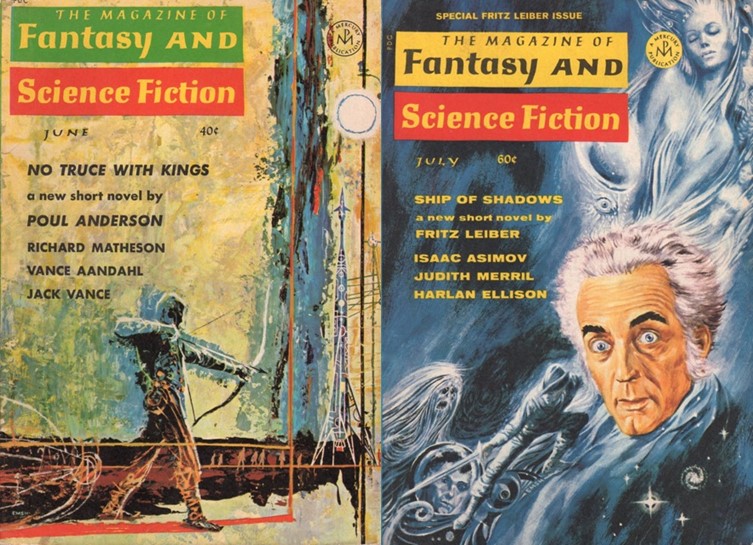 Fantasy and Science Fiction 6/63 cover by Ed Emshwiller
Fantasy and Science Fiction 6/63 cover by Ed EmshwillerFantasy and Science Fiction 7/69 cover by Ed Emshwiller
Ship of Shadows was originally published in F&SF in July, 1969, which was an issue dedicated to Fritz Leiber and included a portrait of him by Ed Emshwiller on the cover. The issue included essays on Leiber by Judith Merril and Al Lewis as well as a reprint of Leiber’s recent poem “iix. ‘Out the frost-rimmed windows peer,…’” and this original novella. Ship of Shadows was nominated for the Hugo Award and the Nebula Award, winning the former. Ship of Shadows is the first of four Leiber stories to be published in the Tor Doubles series, including two that would be published in the final official release of the series.
There is a saying that science fiction (and fantasy) stories have to teach the reader how to read the individual story. The readers must be taught which words should be taken literally and which can be understood metaphorically. Nothing about the story’s setting can be assumed and the reader should allow the author to explain where the story is taking place. Leiber is more than happy to keep the reader in the dark about the actual location in which Ship of Shadows takes place, only revealing the details slowly.
The reader’s entry into this world is Spar, an older man who works as a bartender at the Bat Rack, a dive which serves moonmist, a low grade alcohol. Spar is accompanied by Kim, a talking cat who seems to be his closest friend, although Spar also has a connection with his boss, Keeper, and several of the bar’s patrons, ranging from Doc to Crown to the various women who frequent the bar. Those relationships range from awkwardly cordial to almost adversarial.
Spar has bad teeth and can barely see. He prefers to stay in his menial job at the Bat Rack rather than explore the world around him, taking comfort in the known space, even though it is relatively clear to the reader that even those who seem to have affection for Spar do not respect him or see him as an equal. Even Kim appears to view Spar more as a means to an end.
The world he inhabits appears to be one in which witches and zombies move with impunity, a four day week is in place which includes days for work, idleness, play, and sleep. The world, referred to as Windrush, may also be a ship of some sort, although the characters are not fully aware of its nature. How much of Spar’s knowledge of his world is accurate, how much is legend, and how much is authorial misdirection only becomes partially clear as the novella continues.
Just as Spar seems to have a limited understanding of the world in which he lives, Leiber isn’t in any hurry to provide the reader with any details. It isn’t until he is sent on an errand by Keeper that the world begins to come into an sort of focus, perhaps reflective of the fact that during the errand Spar plans to make a stop to see Doc and have him provide Spar new teeth and new eyes. In his travels, Spar discovers a that Windrush has a variety of different neighborhoods which don’t quite mesh with the world he has pictured living and working in the Bat Rack.
His travels take him to the Bridge, a world of “irregularly pulsing rainbow surfaces, the closest of which sometimes seemed ranks of files of tiny lights going on and off—red, green, all colors. Aloft of everything was an endless velvet –black expanse very faintly blotched by churning, milky glintings.” This revelation, which will be recognized by readers, is strengthened by the fact that it is described through Spar’s imperfect eyesight, which further reinforces the idea that, through no fault of his own, Spar’s impressions of his world of unreliable.
Because of the amount of information Leiber keeps hidden from the reader (and his characters), Ship of Shadows is the sort of work that benefits from re-reading. The first pass lives the reader at a loss for much of the story, but once the explanations come late in the tale, they can illuminate the earlier action when read with the knowledge of what Leiber will eventually reveal.
The cover for No Truce for Kings was painted by Royo. The cover for Ship of Shadows was painted by Robin Wood.
 Steven H Silver is a twenty-one-time Hugo Award nominee and was the publisher of the Hugo-nominated fanzine Argentus as well as the editor and publisher of ISFiC Press for eight years. He has also edited books for DAW, NESFA Press, and ZNB. His most recent anthology is Alternate Peace and his novel After Hastings was published in 2020. Steven has chaired the first Midwest Construction, Windycon three times, and the SFWA Nebula Conference numerous times. He was programming chair for Chicon 2000 and Vice Chair of Chicon 7.
Steven H Silver is a twenty-one-time Hugo Award nominee and was the publisher of the Hugo-nominated fanzine Argentus as well as the editor and publisher of ISFiC Press for eight years. He has also edited books for DAW, NESFA Press, and ZNB. His most recent anthology is Alternate Peace and his novel After Hastings was published in 2020. Steven has chaired the first Midwest Construction, Windycon three times, and the SFWA Nebula Conference numerous times. He was programming chair for Chicon 2000 and Vice Chair of Chicon 7.
Goth Chick News: Exploring GalaxyCon’s Newest Addition – Nightmare Weekend
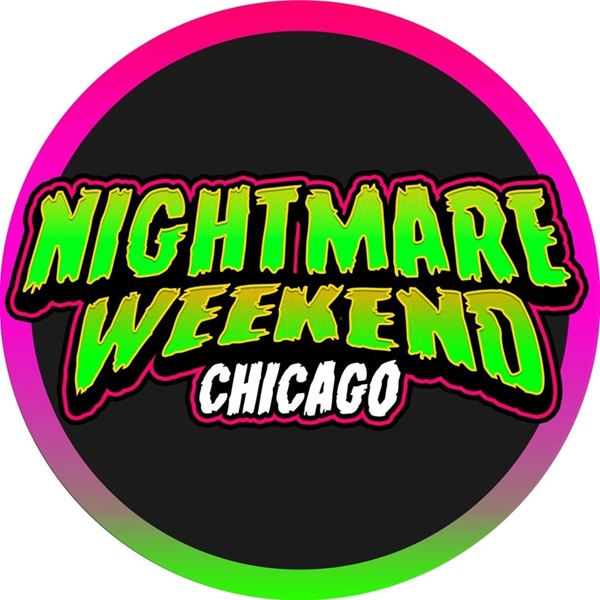 Nightmare Weekend Chicago 2025
Nightmare Weekend Chicago 2025
One of the most entertaining aspects of working for Black Gate is hitting the road with Photog Chris Z to cover horror-themed events in the Midwest. Though many people think about Halloween during the fall months, there is an enormous subculture of vendors, artists, and fans for whom the spooky season never ends. This year, Chicago was not only the site of an entirely new show just for this audience but also the first city to host it—and we had a front-row seat on opening night.
GalaxyCon, LLC, founded in 2006 by Mike Broder and based in Fort Lauderdale, Florida, is one of the leading organizers of pop culture conventions in the United States. Initially focused on comic books, anime, and broader fan engagement, GalaxyCon has successfully expanded its portfolio to include horror-themed entertainment with its Nightmare Weekend series.
 The crowd at Nightmare Weekend Chicago 2025
The crowd at Nightmare Weekend Chicago 2025
The expansion into horror began in response to the genre’s increasing popularity, particularly its blend of nostalgia, cult fandom, and crossover appeal to mainstream audiences. With Nightmare Weekend, GalaxyCon has carved out a distinct identity in the horror convention scene, blending celebrity meet-and-greets, specialized vendors, themed parties, and curated entertainment.
The Nightmare Weekend events (of which there are four more in other cities this year) reflect Broder’s business philosophy of engaging fans across diverse interests. “Horror is not just a genre; it’s a lifestyle for many fans,” Broder explained in a recent interview. “Nightmare Weekend is our way of celebrating the culture and giving horror enthusiasts a place to connect and indulge their passion.”
 Best. Cosplay. Ever.
Best. Cosplay. Ever.
We were thrilled to get an invite to cover the inaugural event in Chicago last weekend. To start, there was an impressive lineup of celebrities, including William Shatner, Jeremy Renner, and Barry Bostwick just to name a few. Unfortunately, many of the top names only appeared on Saturday and Sunday so we missed them. Chris Z did get to meet his favorite cosplayer, Ashlynne Dae and we both had a chance to catch up with our favorite Munster, Butch Patrick, who is starting to feel like a member of the family.
Though GalaxyCon hasn’t released official stats for Nightmare Weekend Chicago, we counted roughly 100 artists in the “Artists Alley” area and over 150 vendors, who together occupied one of the largest halls in the Rosemont Convention Center. We inevitably saw a few people and products we had seen at other shows. However, we were thrilled at all the uniqueness we found. Here’s few in no particular order…
 Soheyla Seiff and her incredible wreaths
Soheyla Seiff and her incredible wreaths
Seiffs Wreaths: Based in South Elgin, Illinois, Soheyla Seiff has been crafting handmade, custom wreaths since 2024. The company specializes in creating unique deco mesh wreaths that cater to a variety of themes, including holidays, special occasions, pop culture, and horror fandoms. Each wreath is meticulously designed to reflect its theme, offering customers a personalized touch to their decor. Notably, Seiff’s Wreaths has gained recognition for its horror-themed wreaths, featuring designs inspired by classic horror films and characters, making them a favorite among genre enthusiasts. Customers can explore and purchase these handcrafted creations through Seiff’s official website or their Etsy shop, where each piece is made with attention to detail and a passion for thematic artistry.
 Wynnwood Farms Teas, Elixirs & Bitters
Wynnwood Farms Teas, Elixirs & Bitters
Wynnwood Farms Teas, Elixirs & Bitters: This boutique tea and apothecary brand, based in Houston, Texas, and owned by Alexandria and Debbie Wynn, offers a unique fusion of storytelling and sensory indulgence through their “Dead to Me Collective” collection. This curated selection features horror and storybook-themed teas, elixirs, and bitters, each crafted to transport consumers into a world of imagination and flavor.
The “Midnight Horror” tea line pays homage to classic horror narratives, with blends like “Dr. Frankenstein,” “Final Girl,” and “The Raven,” inviting tea enthusiasts to experience tales of terror and intrigue with every sip. Complementing these are their handcrafted elixirs and bitters from “The Spellbound Alchemist” series, meticulously produced in small batches by a mother-daughter duo. These concoctions, such as “The Lovers” cocktail bitters — a blend of chocolate, cherry bark, and vanilla — are designed to elevate both wellness routines and mixology experiences.
 Crystallo Card Game
Crystallo Card Game
Crystallo Card Game: It wouldn’t be a convention without one of us picking up a new game. Though this isn’t “horror” per se, it is still a very cool concept. Plus, the shiny things attracted my attention. Crystallo, designed by Liberty Kifer, is a solo card game where players rescue magical creatures trapped by the Black Dragon’s crystal magic. Combining set collection and tile placement, the game challenges players to form crystal patterns and ultimately trap the dragon. With stunning artwork, tactile acrylic gems, and a 30-minute playtime, Crystallo offers an engaging and replayable experience for solo gamers. Expansions like “Untold Fortune” and “Den of Dragons” add depth and complexity to this enchanting adventure.
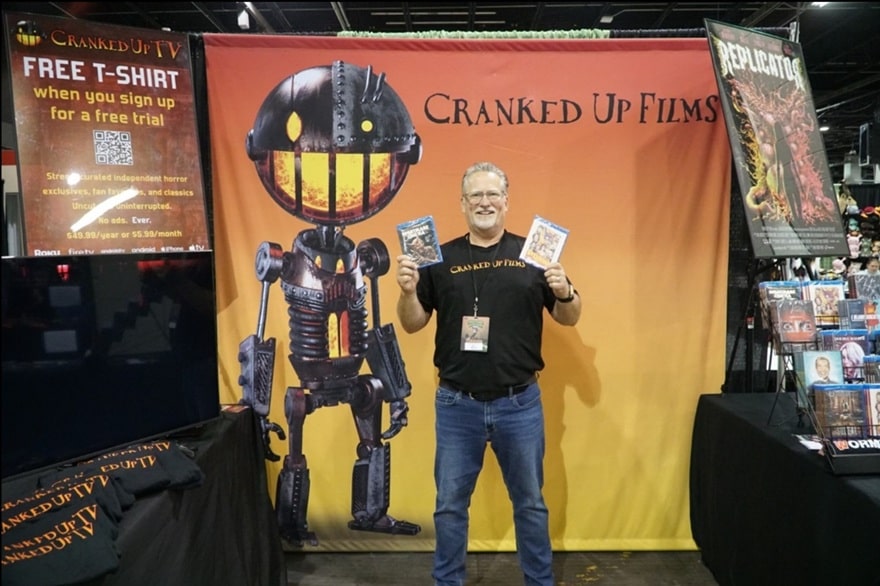 Scott Donley and Cranked Up Films/TV
Scott Donley and Cranked Up Films/TV
Good Deed Entertainment: Scott Donley is the founder and CEO of Good Deed Entertainment (GDE), an independent film studio established in 2012 and headquartered in Ashland, Ohio. Under Donley’s leadership, GDE has built a reputation for producing and distributing character-driven content across various platforms, including film, television, and digital media. The company is perhaps best known for releasing the Academy Award-nominated animated feature Loving Vincent, which tells the story of painter Vincent van Gogh in his signature style. In addition to Loving Vincent, GDE has distributed titles such as Karmalink, Carmen, and Some Freaks, along with the Independent Spirit Award-nominated To Dust and the Annie Award-nominated Charlotte.
Recognizing the growing interest in genre films, Donley launched Cranked Up Films, a division of GDE that focuses on high-concept horror, grounded sci-fi, and speculative fiction. This initiative has led to the production and distribution of films like Nightmare Cinema, a horror anthology featuring segments directed by notable filmmakers such as Mick Garris (Sleepwalkers, Critters 2) and Joe Dante (Gremlins, The Howling). Donley was at Nightmare Weekend promoting his newest venture, Cranked Up TV, the premier destination for ad-free, independent horror, so we now know where our next binge-watch will come from.
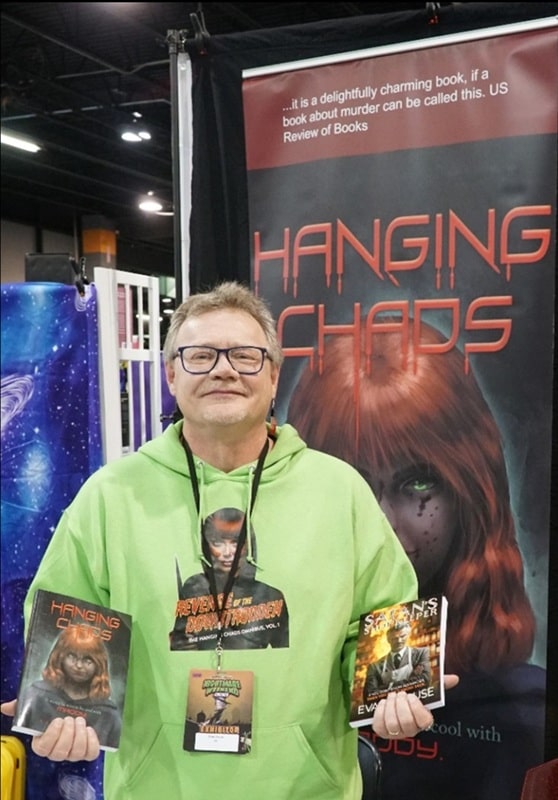 Author Evan Clouse of Hanging Chad Books
Author Evan Clouse of Hanging Chad Books
Hanging Chads Books: Evan Clouse, a former social worker turned author, has made a notable entry into the horror genre with his Hanging Chads series. Launched during what he humorously refers to as his “2/3-life crisis,” Clouse’s writing delves into dark, satirical narratives that blend horror, political commentary, and dark humor. The series follows Maddy Sommers, a vigilante serial killer targeting abusers and oppressors, offering readers a mix of gruesome justice and emotional depth. Clouse’s work has been recognized for its unique approach to horror, combining elements of mystery, love, and social critique.
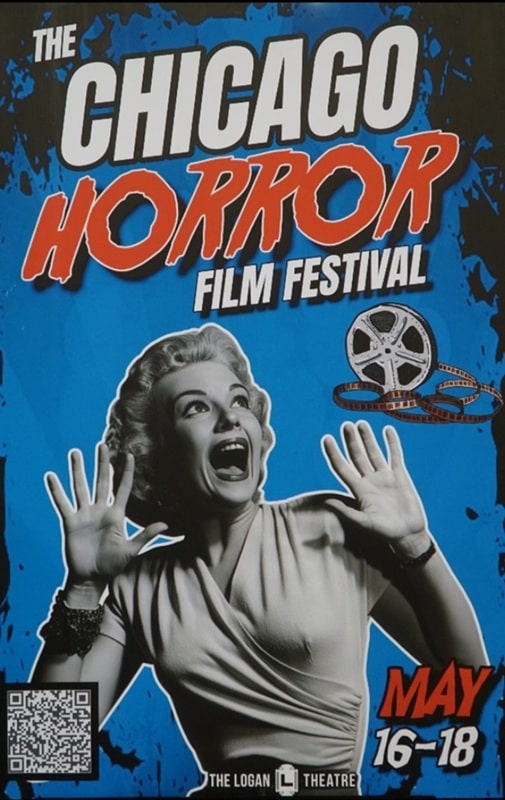 The Chicago Horror Film Festival 2025
The Chicago Horror Film Festival 2025
Last, we had to tell you about two other Midwest events coming soon. The Chicago Horror Film Festival 2025 celebrates its 26th year at the Logan Theater May 16-18. Touted as one of the top 10 horror festivals worldwide, CHFF showcases a curated selection of independent horror films from around the globe, including local and international shorts and features. Tickets start at just $10, with full weekend passes available for $68.99.
The Milwaukee Horror Con returns for its “Fall Frightmare” edition from September 5–7, 2025, at the Four Points by Sheraton Milwaukee Airport Convention Center. As Wisconsin’s only dedicated horror convention, this three-day event promises an immersive experience with horror legends, indie film screenings, themed vendors, cosplay contests, and late-night thrills.
As for GalaxyCon, they are aggressively broadening the reach of Nightmare Weekend to new cities in 2025, including:
- Nightmare Weekend Cleveland: August 29–31, 2025, at the Huntington Convention Center in Cleveland, Ohio.
- Nightmare Weekend Des Moines: September 12–14, 2025, at the Iowa Events Center in Des Moines, Iowa.
- Nightmare Weekend Richmond: October 17–19, 2025, at the Greater Richmond Convention Center in Richmond, Virginia.
- Nightmare Weekend Savannah: November 14–16, 2025, at the Savannah Convention Center in Savannah, Georgia.
A huge thanks to Justin Burkhardt and the Nightmare Weekend promotions team for including us in this first-ever event. We can’t wait for next year.
Life Lessons from David Cronenberg
Let me begin with two assertions, each of which is, in the immortal words of Vincent Vega, “a bold statement.” First: David Cronenberg is one of our greatest directors, and there is nothing he has done that isn’t worth seeing. Second: I am the dumbest, most suicidally foolhardy person you will ever meet. The first statement is arguable, ultimately a matter of opinion, but the second is not, because I can prove it. In fact, I can use the first proposition to establish the validity of the second one.
In case you’ve been living under a rock for the past fifty years, David Cronenberg is the Mutant King of body horror; in stomach-churning, Manson Family date movies like Rabid (an extremely icky form of vampirism), The Brood (nasty little “rage monsters” popping right out of poor Samantha Eggar), Scanners (you want exploding heads — you’ve got exploding heads), and Videodrome (I… I can’t even talk about it, and to this day, neither can James Woods) he set new standards in shockingly gross special effects and in the number of times he forced audience members to barf in their popcorn buckets or make panicked rushes to the restroom.
I thought all these movies were terrific (and not just because of the wild effects — wipe off all the blood and underneath you’ll find a sharp, mordant intelligence with something serious to say), so when Cronenberg’s version of The Fly hit the multiplexes in 1986 it was a must-see for me, and it was with high hopes that I took my lovely wife of barely eighteen months to see it. We were both looking forward to a fun night at the movies. Well…
I had a great time.
Marianne, on the other hand, checked out when Geena Davis gave birth to a bouncing baby maggot (which, to be fair, happened in a dream, so I don’t think it really counts) and spent the last twenty minutes of The Fly hunched over in her seat with her eyes tightly closed, waiting for me to give her the all clear, so she missed John Getz getting his hand dissolved into a bloody stump by fly-spit, Jeff Goldblum’s final insect form emerging while big chunks of his raw red flesh fell off and went splat on the floor, and the bug’s tragic end when his head gets blown to smithereens by a shotgun blast. (She assures me that hearing it all was just as nauseating as seeing it would have been.)
Hey, it was just one rocky evening at the movies; it could have happened to anyone. The main thing is to learn from an experience like that, right?
Fast-forward to 1988. Now the movie creating all the buzz isn’t The Fly — it’s a little something called Dead Ringers. Yeah, I know who directed it, but there are no exploding heads or weird vaginal apertures appearing where they have no business being in this movie. This one is a showcase for serious acting; it’s a character study, you know?
So it was that I persuaded my wife to go to another David Cronenberg movie. (I actually forgot to mention that he was the director. I guess it just slipped my mind.) Not only that, but I also convinced two of our closest friends to come along, women my wife taught school with. This will be great! Diane and Susan are going to love this movie, honey! It’s based on a true story! (Obviously, my motto is, “Be stupid. Be very stupid.”)
I wasn’t lying; Dead Ringers is a great movie, and it is indeed a brilliantly-acted character study. By any measure it’s a darkly seductive, ravishingly shot knockout.
So far, so good. There’s just one problem. Dead Ringers is also, first and foremost, a David Cronenberg movie. And there lies the rub.
Dead Ringers is about identical twin brothers, Elliot and Beverly Mantle, both played by Jeremy Irons. Elliot is smooth, socially ambitious, self-assured and confident (often too much so), while Beverly is introverted, cautious, and much more emotionally vulnerable than his glib twin.
The two characters share a lot of screen time, and one of the best things about the movie is how well Cronenberg employs all the tricks of the trade to make it seem as if Irons really is two different people in the same room together, a task made easier by Irons’ brilliance at subtly differentiating the brothers. (Whenever we see him alone, we instantly know which one he is.)
They are a peculiar pair, these two, and extremely close to each other, even for identical twins. They live together and are in business together, and often one brother seamlessly takes the other’s place when they have to appear at professional functions and the like, and no one is ever the wiser. (Remember The Patty Duke Show?) However, complications ensue when they start sharing the same lover, Claire Niveau, a movie actress played by Geneviève Bujold. The problem is that, for quite a while, Claire doesn’t know that she’s dealing with two separate people, and when she finds out, she’s not happy. Ooops.
The bulk of the movie is taken up with showing how first Beverly and then Elliot start to come apart under the pressure of their extraordinary personal and professional charade, with both brothers eventually becoming delusional drug addicts and descending into outright madness. As you might guess, it doesn’t end well, and things really go downhill when the fraternal craziness starts to manifest itself at the workplace; the whole ghastly situation is made far worse because of the unique nature of the twins’ profession.
What? I didn’t mention what the Mantle brothers do for a living? How careless of me.
No, they’re not architects. They don’t work at the DMV. They’re not certified public accountants or major league baseball players or long-haul truck drivers.
They’re gynecologists.
You begin to appreciate the depth of my folly, don’t you?
I began to think that I had made a mistake during the opening credits, which feature medieval woodcuts of women cross-sectioned to show the children they’re carrying against a background of antique medical instruments that look like they were found lying around Torquemada’s garage; the implications were not comforting.
My growing unease turned to outright panic when an increasingly demented Beverly uses a bulky surgical retractor to conduct an examination on an unfortunate woman; I don’t know if the lady was a method actress, but her winces and grimaces certainly seemed to be coming from someplace real. Halfway through this excruciating scene, I started looking around for an escape route, but I knew it was hopeless; they would drag me down before I made it halfway to the exit.
Then Beverly starts to believe that there’s “something wrong” with “the insides” of all of his patients, that all of the women he’s examining are actually mutants, and he commissions an avant-garde artist to make him a set of “gynecological instruments for working on mutant women.” They look like fruit hanging from a tree on some nightmare alien planet.
The twins operate a fertility clinic (judging from the body of his work — no pun intended — you have to believe that for Cronenberg, birth holds more horror than death), and when Beverly shows up for an operation with these grotesque instruments and actually tries to use them on a patient, he almost kills the woman and the career of the acclaimed Mantle brothers comes to an abrupt and ignominious end.
Despite my sense of impending personal doom, I was powerfully moved by the film’s somber ending, with the outcast brothers lying dead in each other’s arms, as close as they were in their mother’s womb, as close as they had always been during their tragic lives. It almost brought me to tears, in fact.
The tears on the faces of my wife and our friends, however, were of an altogether different kind. They say that it can get to almost fifty below zero in Antarctica. That’s positively balmy compared to the chill I felt walking out of the theater and in the car on the way home, and I was soon to learn that no lamed and bitter ex-cavalry officer can put as much rage and loathing into the word “stirrups” as your average woman can. Some things, I suppose, are just too personal for art.
Well, it was all a long time ago and all those fine ladies eventually forgave me for making them watch a gynecological horror movie, and I did learn a lesson. A year later, the shoe was on the other foot when I sat in the theater with the same group watching Steel Magnolias, and despite my agony, I knew better than to say a single word. I like having all my limbs.
Three or four years ago, I picked up a beautiful Criterion Collection edition of Cronenberg’s 1996 film of J.G. Ballard’s novel, Crash, which I missed when it was in the theater. When I read the book decades ago, my jaw hung open the whole time; it’s the most radically, shockingly transgressive thing I’ve ever read. Of course David Cronenberg made a movie of it. The Blu-ray has been sitting on the shelf since I bought it; I’ve never yet been able to work up the courage to actually watch it. Once seen, some things can never be unseen.
But I do wonder; some evening soon, Marianne is going to ask, “What are we going to watch tonight?”
What do you think? Should I…
Thomas Parker is a native Southern Californian and a lifelong science fiction, fantasy, and mystery fan. When not corrupting the next generation as a fourth grade teacher, he collects Roger Corman movies, Silver Age comic books, Ace doubles, and despairing looks from his wife. His last article for us was Odd Old Indie: Night Tide
Oof. Yet Another WorldCon Controversy

Good afterevenmorn, Readers!
I have been out of the writing world loop for a bit, being wrapped up in my own personal stuff (it’s a terrible combination of absolutely no time whatsoever, “out of sight, out of mind,” and having my head in the clouds as I’m neck deep in the first draft of a book), so I’m quite late to the party. Apparently, World Con has once again landed itself in some controversy.
Let me fill you in if you are like I was just two days ago; utterly clueless about it all.
 Image by Robert Fotograf from Pixabay
Image by Robert Fotograf from Pixabay
It appears that Worldcon 2025, which will be held in August in the fine city of Seattle, used an LLM (Language Learning Model; specifically Chat GPT) in order to vet panelists for their programming. This created quite the furor. You can read more about it in the File 770 article that covers most of it. Gizmodo also had an article about it. It’s understandable, really. There’s a lot of bad blood between creatives and the “tech bros” who stole their creations in order to train their LLMs.
I understand the impulse to use AI in order to do this, especially for a convention as huge as Worldcon. I do not volunteer for any conventions. I have no idea the amount of work involved in getting one together, but I can imagine. I expect that a good portion of manpower is devoted to vetting possible panelists and then matching them to a panel where they would be the best fit for that particular topic.
AI would likely be a godsend in cutting down the hours required to do it all. Or it would be, if there weren’t so many issues with it.
 Image by Dmitriy from Pixabay
Image by Dmitriy from Pixabay
It’s not even about stolen creations or jobs. What was taken in this case was volunteer hours. Is that better or worse? Not sure. There was one mention of why it’s not so great, and that while it might be a lot of work, it is good work, and can be a lot of fun. I cannot speak to that. But as an intention, that doesn’t seem bad to me.
At the most basic, practical level, without regard to ethics at all, LLMs are not great for vetting things. The examples of AI hallucinating are abound, and sometimes they flat out lie, or make things up and present them as facts though they don’t even exist. Wasn’t there some recent furor over an LLM citing supporting case law… by references cases that simply did not exist. The machine just… made them up. AI is constantly ascribing nonsensical things to people who had nothing to do with them, or making up answers to clearly nonsensical questions (specifically designed to prove just how unreliable the application is).
There is also the issue of the inherent bias in the data sets that is the internet. In short, the internet is a horribly bigoted place, and any LLM that gleaned its dataset from the internet is proven to be racist as all get-out.
Everything else does.
 A real firestorm
A real firestorm
Practically, it doesn’t seem great, given all the problems with AI at present (granted, as the technology improves, that will be less and less an issue). Ethically, it’s an absolute stinker.
The environmental toll of using AI is absolutely horrific. The energy and water requirements for keeping these things running as appalling. Anyone who cares remotely about the environment should have serious concerns about using it just on that alone. If all you care about is the environment, then any AI use is an absolute no-go.
Then there’s the issue of the principals. The attendees of this convention are the very kinds of people who had their creativity stolen in order to teach these LLMs. Using the exact application that thieved from the very people in attendance was probably not a great move. It’s quite a slap to the face, if you think about it. Many of those very people, based on these grounds alone, feel very strongly that there is absolutely no ethical argument for using AI.
It will not surprise anyone that I’m kinda on their side; both on the personal and environmental issues. I don’t think there can be any ethical reason to use AI. The time it might save doesn’t offset the other considerations here.
Easy for me to say, I know. I’m not trying to organize one of the biggest SFF conventions in the world. I just think that using AI was a stumble and can’t really be justified. At least, not to me.
 Thankfully unaffected this time.
Thankfully unaffected this time.
It’s become such an issue for Worldcon 2025 that three people have resigned from the board, and one author has withdrawn their books from award consideration (Yoon Ha Lee was in the running for the Lodestone Award, and withdrew following this mess). This, despite assurances that AI went nowhere near the Hugo Awards. Thankfully. I can’t imagine the mess if it had.
Honestly, in terms of controversies attached to Worldcon, this is the least aggravating for me personally. I am not in the running for a Hugo (could you imagine?), and I’m not attending Worldcon this year… or any convention in the US for the next few years. This is not the Sick Puppies, or Sick Puppies adjacent. The awards themselves appear to have maintained their integrity this year. My absolute dislike of LLMs on principal makes me dislike this situation intensely, but it’s not the worst thing that has happened to and with World Con.
Thank goodness. I don’t think my blood pressure could handle anything more egregious.
When S.M. Carrière isn’t brutally killing your favorite characters, she spends her time teaching martial arts, live streaming video games, and cuddling her cat. In other words, she spends her time teaching others to kill, streaming her digital kills, and a cuddling furry murderer. Her most recent titles include Daughters of Britain, Skylark and Human. Her serial The New Haven Incident is free and goes up every Friday on her blog.
What I’ve Been Watching: May 2025
 Wow. It’s been over half a year since I did a What I’ve Been Watching. I’ve already forgotten some of the stuff I watched since then! But let’s tackle a few more recent favorites. And what I’m re-watching, as usual.
Wow. It’s been over half a year since I did a What I’ve Been Watching. I’ve already forgotten some of the stuff I watched since then! But let’s tackle a few more recent favorites. And what I’m re-watching, as usual.
COUNTY LINE
From 2017 through 2022, there were three TV movies (is that still ‘a thing’) in this series. I did not recognize the main actor away. He reminded me of Dan Dierdorf, but I had to look him up on IMDB. It was good ol’ Tom (Luke Duke) Wopat!
He’s Alden Rockwell, a sheriff/former sheriff in some Georgia country town. The city is split down the middle between two counties. So, you’ve got Alden, and the sheriff of the other county, involved in the same case. In the first one, Alden’s best friend (and sheriff) is shot, so he tries to solve the crime – and there’s a bigger thing going.
There are plenty of familiar faces, which I enjoy. Patricia Richardson (Tim Allen’s wife on Home Improvement) owns the diner that is a common hangout. It’s on both sides of the county line. So Alden sits on one side of a table in a dry county. His buddy sits on the other side, where alcohol is legal. So, his buddy orders the beer and puts it on Alden’s side. It’s silly but works.
Jeff Fahey (Bodie’s grandfather on Fire Country) is a sheriff. Grant Goodeve (David on Eight is Enough) is in the second movie. Casper Van Dien (Starship Troopers) appears in the third one. I like seeing the faces from the past.
There’s that ‘Aw hell’ country cop resignation and humor, but it’s not a comedy. It’s a bit of a buddy cop movie, but not really.
Wopat is clearly the show’s center, and he’s good in the part. Looking older and rather beefy, he’s stubbornly likable.
I liked all three. The last two were both done in 2022, and it looks like the series is done. But it’s a fun little watch on Prime.
THE BONDSMAN
 ‘Resurrected bounty hunter Hub Halloran gets an unexpected second chance at life, love and his nearly forgotten musical career – only to find that his old job now has a demonic new twist.’
‘Resurrected bounty hunter Hub Halloran gets an unexpected second chance at life, love and his nearly forgotten musical career – only to find that his old job now has a demonic new twist.’
That’s a pretty good summary, from IMDB. Near the beginning of the opener, which is an Amazon original series, Kevin Bacon is killed while on a bounty hunting job. But he immediately comes back to life. He’s now hunting down demons, for Satan.
It’s not a comedy, but it’s got a lot of funny. The redneck setting makes it more fun, as well. Beth Grant is hilarious as his mom. She’s cut from the same vein as Ruth Gordon, Clint Eastwood’s mom in Every Which Way But Loose, and the sequel. She’s feisty, funny, and tough, as a former partner in the business.
The story line has high stakes, both on earth and for the afterlife. And the cliffhanger ending of episode eight absolutely sets up season two. I think Kevin Bacon – looking like life rode him hard and hung him up, is excellent in the lead.
The gore factor occasionally approaches my limit, but not too often. I don’t do horror, but I really enjoyed this, and look forward to season two. Highly recommended.
BOSCH: LEGACY
Michael Connelly’s Bosch books are huge sellers. The Amazon original series Bosch (which I wrote about here) covered 68 episodes over 7 seasons, from 2014-2021. Titus Welliver previously had over 100 credits, but Harry Bosch made him a star. And he’s perfect in the role. Strong cast, intense season-long story lines, and quality production values, Bosch should be looked at as a terrific adaptation of a best-selling book series.
 It was already announced that there would be a sequel series, Bosch: Legacy. With many of the same actors returning in their roles, Bosch has transitioned from being a cop, to a private investigator. He wasn’t exactly totally committed to the rules as an LA. homicide detective, but he’s got a lot more ‘flexibility’ as a PI.
It was already announced that there would be a sequel series, Bosch: Legacy. With many of the same actors returning in their roles, Bosch has transitioned from being a cop, to a private investigator. He wasn’t exactly totally committed to the rules as an LA. homicide detective, but he’s got a lot more ‘flexibility’ as a PI.
I really liked the original show. I liked the first two seasons of the sequel well-enough. I wasn’t as invested in it. However, season three was its strongest, and I think the series finished strongly, as it’s time for a spin-off.
Renee Ballard, played by Maggie Q, was an LAPD detective in the final episode of Legacy. She is the star of Ballard, which is to start airing later this year. Welliver will reprise his role in one episode. I thought her character was okay, and I’ll watch it to stay in the Bosch-verse.
One thing I really liked is that final season – and final episode – delivered on ‘Everybody matters, or no one matters.’ That little maguffin was dropped in the first season of the original Bosch, and mentioned more than once after in both series. And they paid it off. I appreciated that.
Season one of Bosch was almost too dark for me, but I continued on, and I have enjoyed my Bosch adventure. I would absolutely watch the original series: Legacy would be much less impactful if you watched it first. I’d even venture to say, it really wouldn’t work that great.
Side note – Welliver narrated the first several audiobooks for Robert B. Parker’s (Spenser for Hire) Cole and Hitch Westerns. Ed Harris made and starred in a very good version of the first one, Appaloosa, which I wrote about, here. Welliver is FANTASTIC. It’s a crime that Amazon or somebody has not signed him on to play Virgil Cole in a few movies, or a streaming series based on the books. He would be terrific.
AND….
Next installment, I’m going to cover Daredevil, and Daredevil: Born Again. I talked about Daredevil a bit a few months ago, and I think it’s my favorite Marvel series. And the reboot was very good.
I finally got around to watching The Chosen – from start to current. It’s a SUPERB show that deeply draws on the four gospels. It’s an amazing show and I can’t wait for the new season this Summer. They’re up to the Last Supper.
I am current on season three of Will Trent, which is an excellent cop show, with a little bit of Monk about it (and you know I loved that era of the USA Network). I’m gonna tackle that one as well.
I am in the middle of season three (of four) of my re-watch of Shakespeare and Hathaway: Private Investigators. This is a cute buddy cop/PI show with more of a Hallmark vibe, than something like The Bay (wrote about that here). It’s kind of in the same vein as Murder They Hope, which was originally three TV movies, then became a two mini-season series. Fun, lighthearted British mystery stuff. I re-watched all of that franchise, as well.
And I am almost to the end of season eleven of my Death in Paradise complete re-watch. Season fourteen, with yet another major cast change, finished dropping in March. I’m still working on it, while watching lots of other stuff. It remains one of my favorite shows.
I talked about Shakespeare and Hathaway, and Death in Paradise, in this Britbox-centric post.
I finished the current season of Krapopolis. I like it, but it’s all kinda the same. I don’t binge that one.
Some previous entries on things to watch:What I’ve Been Watching: May 2025 (What We Do in the Shadows, The Bay, Murder in a Small Town)
What I’m Watching – November 2023 (Brooklyn Nine-Nine, The Caine Mutiny Court Martial, A Haunting in Venice)
What I’m Watching – April 2023 (Florida Man, Picard – season three, The Mandalorian)
The Pale Blue Eye, and The Glass Onion: Knives Out
Tony Hillerman’s Dark Winds
The Rings of Power (Series I wrote on this show – all links at this one post)
What I’m Watching – December 2022 (Frontier, Leverage: Redemption)
What I’m Watching – November 2022 (Tulsa King, Andor, Fire Country, and more)
What I’m Watching – September 2022 (Galavant, Fire Fly, She-Hulk, and more)
What I’m Watching- April 2022 (Outer Range, Halo, Why Didn’t They Ask Evans, and more)
When USA Network was Kicking Major Butt (Monk, Psych, Burn Notice)
You Should be Streaming These Shows (Corba Kai, The Expanse, Bosch, and more)
What I’m BritBoxing – December 2021 (Death in Paradise, Shakespeare & Hathaway, The Blake Mysteries, and more)
To Boldly Go – Star Treking – (Various Star Trek incarnations)
What I’ve Been Watching – August 2021 (Monk, The Tomorrow War, In Plain Sight, and more)
What I’m Watching – June 2021 (Get Shorty, Con Man, Thunder in Paradise, and more)
Tucker and Dale vs. Evil
What I’ve Been Watching – June 2021 (Relic Hunter, Burn Notice, Space Force, and more)
Appaloosa
Psych of the Dead
The Mandalorian
What I’m Watching: 2020 – Part Two (My Name is Bruce, Sword of Sherwood Forest, Isle of Fury, and more)
What I’m Watching 2020: Part One (The Adventures of Brisco County Jr, Poirot, Burn Notice, and more)
Philip Marlowe: Private Eye
Leverage
Nero Wolfe – The Lost Pilot
David Suchet’s ‘Poirot’
Sherlock Holmes (over two dozen TV shows and movies)

Bob Byrne’s ‘A (Black) Gat in the Hand’ made its Black Gate debut in 2018 and has returned every summer since.
His ‘The Public Life of Sherlock Holmes’ column ran every Monday morning at Black Gate from March, 2014 through March, 2017. And he irregularly posts on Rex Stout’s gargantuan detective in ‘Nero Wolfe’s Brownstone.’ He is a member of the Praed Street Irregulars, founded www.SolarPons.com (the only website dedicated to the ‘Sherlock Holmes of Praed Street’).
He organized Black Gate’s award-nominated ‘Discovering Robert E. Howard’ series, as well as the award-winning ‘Hither Came Conan’ series. Which is now part of THE Definitive guide to Conan. He also organized 2023’s ‘Talking Tolkien.’
He has contributed stories to The MX Book of New Sherlock Holmes Stories — Parts III, IV, V, VI, XXI, and XXXIII.
He has written introductions for Steeger Books, and appeared in several magazines, including Black Mask, Sherlock Holmes Mystery Magazine, The Strand Magazine, and Sherlock Magazine.
You can definitely ‘experience the Bobness’ at Jason Waltz’s ’24? in 42′ podcast.
Half a Century of Reading Tolkien: Part Four – The Return of the King by JRR Tolkien
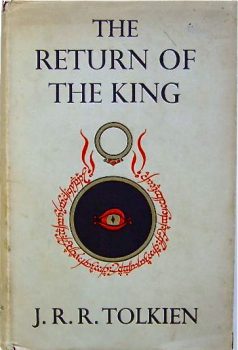 A wild light came into Frodo’s eyes. ‘Stand away! Don’t touch me!’ he cried. ‘It is mine, I say. Be off!’ His hand strayed to his sword-hilt. But then quickly his voice changed. ‘No, no, Sam,’ he said sadly. ‘But you must understand. It is my burden, and no one else can bear it. It is too late now, Sam dear. You can’t help me in that way again. I am almost in its power now. I could not give it up, and if you tried to take it I should go mad.’
A wild light came into Frodo’s eyes. ‘Stand away! Don’t touch me!’ he cried. ‘It is mine, I say. Be off!’ His hand strayed to his sword-hilt. But then quickly his voice changed. ‘No, no, Sam,’ he said sadly. ‘But you must understand. It is my burden, and no one else can bear it. It is too late now, Sam dear. You can’t help me in that way again. I am almost in its power now. I could not give it up, and if you tried to take it I should go mad.’
Frodo to Sam in Mount Doom from The Return of the King
And so we come to the end of the first part of my return to JRR Tolkien’s work. For those not following along with my earlier essays (links at the bottom), inspired by a hate watch of Peter Jackson’s Lord of the Rings movies, I picked up The Fellowship of the Ring and quickly succumbed to a complete reread of the trilogy. As I set out to write an article about Fellowship, I instead, found myself realizing I’ve been reading the professor’s books for fifty years and how much they’d meant to me.
Last time, I wrote that when I was young, I tended to struggle through bits of The Two Towers. That was never the case with The Return of the King, something that I found to remain so on this reading. It’s got wilder and bigger battles than the previous book, incredible scenes (including one of the greatest in all three books and that Jackson insanely cut omitted from the theatrical release!), and Frodo’s and Sam’s journey becomes more desperate and its evocation of Christ-like self-sacrifice more potent. The penultimate chapter, The Scouring of the Shire, portrays the transformation wrought on the four hobbits by their undertakings. Finally, the book ends with one of my favorite closing lines of any book.
As usual, here’s let me give a brief synopsis for those who’ve yet to read The Lord of the Rings. The first half of the book, The War of the Ring, contains three narratives. Gandalf and Pippin set off for Minas Tirith while Merry rides with the Rohirrim, again, for Minas Tirith, but by a different route. Meanwhile, Legolas and Gimli follow Aragorn along the Paths of the Dead in search of supernatural allies.
Everyone comes together at Minas Tirith at various stages in the great siege of the city and the ensuant battle outside its wall. When Mordor’s forces are broken and scattered, under Aragorn’s command, an army is sent north to the Gates of Mordor with hopes of distracting Sauron’s unblinking eye from Frodo and Sam.
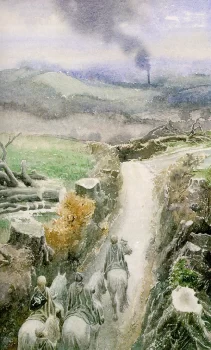 Homeward Bound by Alan Lee
Homeward Bound by Alan Lee
The End of the Third Age, the book’s second half, can be broken into several parts; the final leg of Frodo’s and Sam’s march to Mount Doom, the reunion of the surviving members of the Fellowship and Aragorn’s coronation, the scouring of the Shire, and a final farewell to Middle-earth. As with The Two Towers, this part of the trilogy evokes Tolkien’s wartime service, if not as in a direct way. On the one hand, both Merry and Pippin are transformed into hobbits of action and steel. There is nothing left that scares them. On the other, Frodo, never fully recovered from his wound on Weathertop, has been left drained and tired in the deepest parts of his soul by bearing the One Ring for so long, straight into the Enemy’s domain.
Each time around with LotR, I find myself noticing something new or being drawn with greater interest to a different part than previously. This time it was The Scouring of the Shire. I think, partially, it’s the better understanding that the fight against evil is never ending, and just as likely to happen in your own town as on some distant fields. More significantly, it was Frodo’s place in it. I remembered him as instrumental in the routing of Sharkey’s forces, but that is not the case at all.
When Frodo and Sam decide to lighten their load and ditch the orc gear weighing them down, Frodo makes an emphatic statement that “I’ll bear no weapon, fair or foul.” When it becomes clear that there are hobbits working for Sharkey and his ruffians, he issues an order:
“‘Fight?’ said Frodo. ‘Well, I suppose it may come to that. But remember: there is to be no slaying of hobbits, not even if they have gone over to the other side. Really gone over, I mean; not just obeying ruffians’ orders because they are frightened. No hobbit has ever killed another on purpose in the Shire, and it is not to begin now. And nobody is to be killed at all, if it can be helped. Keep your tempers and hold your hands to the last possible moment!’”
Pippin and Merry are ready to fight and do so when the time comes. Merry himself kills the leader of the ruffians. Frodo, though, doesn’t draw his sword and remains out of the battle. When it’s over, he steps in “to prevent the hobbits in their wrath at their losses, from slaying those of their enemies who threw down their weapons.”
Merry and Pippin prove themselves the highborn leaders they were always destined to be in the battle against the ruffians. It’s Frodo, though, after having suffered mightily and seen his share of death and destruction, who will have no more of it. I simply didn’t remember this aspect of Frodo. When we read that even the normally mild-mannered citizens of the Shire are pressing to kill their prisoners, it’s clear how different from them Frodo has become.
I understand Jackson omitting the scouring from his films. He’s had his big beat climax and the last chapter, wherein Frodo and several others exit the stage for good works well enough for a movie. What we lose, though, is the impact of learning that even the innocents of the Shire have been damaged by the war, and that even they can be driven to killing and murderous rage. In a land where presumably there’s never a murder, they suddenly have nearly a hundred corpses on their hands.
We also miss out that the once mighty Saruman, now reduced to a pitiful state, has become petty and spiteful. When finally confronted by the hobbits he revels in what he’s done to the Shire.
I have already done much that you will find it hard to mend or undo in your lives. And it will be pleasant to think of that and set it against my injuries.’
Despite many hobbits calling out to kill Saruman, Frodo only dismisses him with a sense of pity, largely for the noble being he once was. He even offers temporary sanctuary to Grima and the chance to escape his master’s control. From the beginning, Frodo is portrayed as a good person, but surviving the burden of the Ring seems to have turned into an outright noble one, something I don’t think I’ve tracked as closely before.
In the last few years, especially, it seemed, after the movies came out, there was a lot of talk that Sam Gamgee was the real hero of LotR. After this read, I think I’ve come around to that. Frodo sets out to take the Ring to Mount Doom, always with a sense of fatalism. His ownership of the Ring makes him feel obligated to take it to the end and he never has any doubts about what needs to be done.
Sam, however, chooses to go out of loyalty to Frodo, not for any sense of obligation to destroy the Ring. That does come upon him later when he thinks Frodo dead. He is the one tempted along the way, first by the visions in the Mirror of Galadriel and later by the Ring itself. He hesitates for a moment each time, but doesn’t falter. In fact, he is the only person we ever read of in the books or the appendices who gives up the Ring willingly. In a scene Jackson left out, Sam is tested and proved strong.
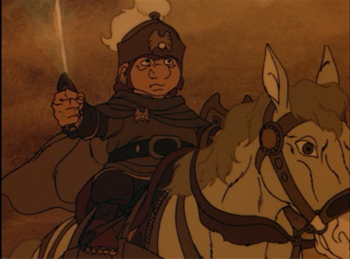 Samwise the Strong from Rankin and Bass
Samwise the Strong from Rankin and Bass
His thought turned to the Ring, but there was no comfort there, only dread and danger. No sooner had he come in sight of Mount Doom, burning far away, than he was aware of a change in his burden. As it drew near the great furnaces where, in the deeps of time, it had been shaped and forged, the Ring’s power grew, and it became more fell, untameable save by some mighty will. As Sam stood there, even though the Ring was not on him but hanging by its chain about his neck, he felt himself enlarged, as if he were robed in a huge distorted shadow of himself, a vast and ominous threat halted upon the walls of Mordor. He felt that he had from now on only two choices: to forbear the Ring, though it would torment him; or to claim it, and challenge the Power that sat in its dark hold beyond the valley of shadows. Already the Ring tempted him, gnawing at his will and reason. Wild fantasies arose in his mind; and he saw Samwise the Strong, Hero of the Age, striding with a flaming sword across the darkened land, and armies flocking to his call as he marched to the overthrow of Barad-dûr. And then all the clouds rolled away, and the white sun shone, and at his command the vale of Gorgoroth became a garden of flowers and trees and brought forth fruit. He had only to put on the Ring and claim it for his own, and all this could be.
In that hour of trial it was the love of his master that helped most to hold him firm; but also deep down in him lived still unconquered his plain hobbit-sense: he knew in the core of his heart that he was not large enough to bear such a burden, even if such visions were not a mere cheat to betray him. The one small garden of a free gardener was all his need and due, not a garden swollen to a realm; his own hands to use, not the hands of others to command.
Sam is the reason Frodo succeeds in reaching the furnace at Mount Doom. He rescues him from Cirith Ungol and later he carries him up the slopes of the volcano. He also matures along the journey. Several times in The Two Towers he is set to kill Smeagol. When given the chance to kill him again in this book, Sam finds himself unable to. Even though his time with the Ring was short, it has taught him much.
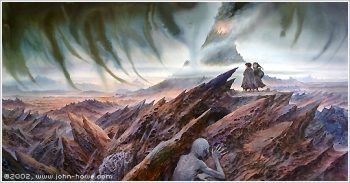 Mount Doom by John Howe
Mount Doom by John Howe
‘Now!’ said Sam. ‘At last I can deal with you!’ He leaped forward with drawn blade ready for battle. But Gollum did not spring. He fell flat upon the ground and whimpered.
‘Don’t kill us,’ he wept. ‘Don’t hurt us with nassty cruel steel! Let us live, yes, live just a little longer. Lost lost! We’re lost. And when Precious goes we’ll die, yes, die into the dust.’ He clawed up the ashes of the path with his long fleshless fingers. ‘Dusst!’ he hissed.
Sam’s hand wavered. His mind was hot with wrath and the memory of evil. It would be just to slay this treacherous, murderous creature, just and many times deserved; and also it seemed the only safe thing to do. But deep in his heart there was something that restrained him: he could not strike this thing lying in the dust, forlorn, ruinous, utterly wretched. He himself, though only for a little while, had borne the Ring, and now dimly he guessed the agony of Gollum’s shrivelled mind and body, enslaved to that Ring, unable to find peace or relief ever in life again. But Sam had no words to express what he felt.
‘Oh, curse you, you stinking thing!’ he said. ‘Go away! Be off! I don’t trust you, not as far as I could kick you; but be off. Or I shall hurt you, yes, with nasty cruel steel.’
Could Sam have carried the Ring himself to Mount Doom himself, probably not. But Frodo, for all his spiritual resilience, fails in the end. Only with Sam’s help could he have even made it to that point. Tolkien himself referred to Sam as the “chief hero,” so I guess I’ll have to go along with that.
Which leads me to Peter Jackson’s version. Instead of Frodo overwhelming Smeagol and dominating him by the power of the Ring. Which means we miss this:
‘Down, down!’ he gasped, clutching his hand to his breast, so that beneath the cover of his leather shirt he clasped the Ring. ‘Down, you creeping thing, and out of my path! Your time is at an end. You cannot betray me or slay me now.’
Then suddenly, as before under the eaves of the Emyn Muil, Sam saw these two rivals with other vision. A crouching shape, scarcely more than the shadow of a living thing, a creature now wholly ruined and defeated, yet filled with a hideous lust and rage; and before it stood stern, untouchable now by pity, a figure robed in white, but at its breast it held a wheel of fire. Out of the fire there spoke a commanding voice.
‘Begone, and trouble me no more! If you touch me ever again, you shall be cast yourself into the Fire of Doom.’
Instead of Sam refraining from killing him as described above, there’s a short, vicious encounter that ends with Sam cutting Smeagol in the belly. It continues Jackson’s rejection of nuance and complication for action every time.
There are so many problems I have with the movie. Two-trunked titanic oliphaunts that Legolas parkours on, well, they’re bad. Worst of all is the denigration of Denethor. Tolkien’s character is a man of great learning who has been lured into despair by his contact with Sauron. A once noble man has fallen into such hopelessness that he can’t even imagine there’s any chance of survival. Instead, Jackson gives us a snide, snarling man who makes Pippin sing for him while he devours food like an animal, juices dribbling down his face. Again, nuance of character has no place.
One thing that particularly stands out is the elimination of, what’s for me, one of the most iconic moments in The Return of the King. When the great gate of Minas Tirith is broken down, Gandalf confronts the Witch King. That Jackson chose to make up his own scenes and dialogue for the movies but excised this one, well, it’s inexcusable.
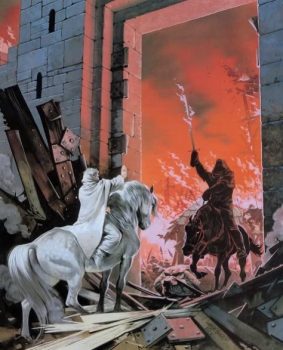 Witch King at the Gate by Angus McBride
Witch King at the Gate by Angus McBride
Thrice he cried. Thrice the great ram boomed. And suddenly upon the last stroke the Gate of Gondor broke. As if stricken by some blasting spell it burst asunder: there was a flash of searing lightning, and the doors tumbled in riven fragments to the ground.
In rode the Lord of the Nazgûl. A great black shape against the fires beyond he loomed up, grown to a vast menace of despair. In rode the Lord of the Nazgûl, under the archway that no enemy ever yet had passed, and all fled before his face.
All save one. There waiting, silent and still in the space before the Gate, sat Gandalf upon Shadowfax: Shadowfax who alone among the free horses of the earth endured the terror, unmoving, steadfast as a graven image in Rath Dínen.
‘You cannot enter here,’ said Gandalf, and the huge shadow halted. ‘Go back to the abyss prepared for you! Go back! Fall into the nothingness that awaits you and your Master. Go!’
The Black Rider flung back his hood, and behold! he had a kingly crown; and yet upon no head visible was it set. The red fires shone between it and the mantled shoulders vast and dark. From a mouth unseen there came a deadly laughter.
‘Old fool!’ he said. ‘Old fool! This is my hour. Do you not know Death when you see it? Die now and curse in vain!’ And with that he lifted high his sword and flames ran down the blade.
Gandalf did not move. And in that very moment, away behind in some courtyard of the City, a cock crowed. Shrill and clear he crowed, recking nothing of wizardry or war, welcoming only the morning that in the sky far above the shadows of death was coming with the dawn.
How do you decide to introduce those ridiculous looking oliphaunts but leave this out? Who the heck knows. To me, it seems like a terrible appreciation for what’s really cool and awesome. That said, the charge of the Rohirrim and the death of the Witch King are pretty solid.
In the beginning, I came to The Lord of the Rings just as the sequels to The Hobbit. Gradually, I understood they had something to say, artistically and thematically. Gradually, the complex architecture of the books and the characters became clearer. This time around, I think the tragic elements have resonated the most — the fallen state of Middle-earth, Boromir’s and his father’s fates, Smeagol’s, too, of course, and, ultimately, Frodo’s. By the last pages, all the magic has flowed out of Middle-earth and its fate is in the hands of men.
I really don’t know how many times I’ve read these books. There was a period where I read them every year or two. Nonetheless, each time I come back to them, it’s almost like I’m reading them for the first time. I’ve read my share of ridiculously big epic fantasies, but none of them have really earned their length in the way these books have. I can’t say when, but I will be rereading them sooner rather than later.
So, what’s next? I’m not sure. My plans include reading The Hobbit, The Silmarillion, and definitely Bored of the Rings. I might finally crack open my copies of The Fall of Gondolin and Beren and Luthien, too. I hope you’re willing to follow me along.
Gandalf and the Witch King from Rankin and Bass’ The Return of the King
Half a Century of Reading Tolkien: Part One
Half a Century of Reading Tolkien: Part Two – The Fellowship of the Ring by JRR Tolkien
Half a Century of Reading Tolkien: Part Three — The Two Towers by JRR Tolkien
Fletcher Vredenburgh writes a column each first Sunday of the month at Black Gate, mostly about older books he hasn’t read before. He also posts at his own site, Stuff I Like when his muse hits him
Tubi Dive, Part IV
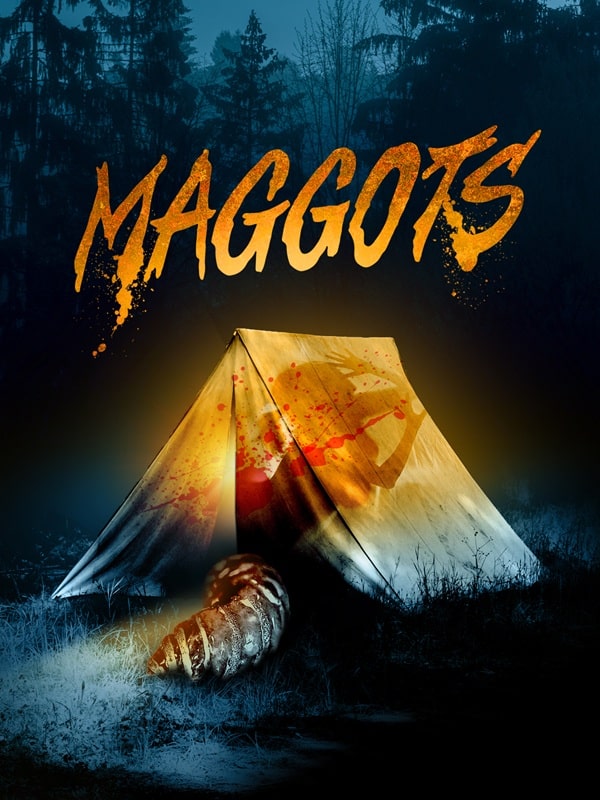 Maggots (JO JO New Media, 2017)
Maggots (JO JO New Media, 2017)
50 films that I dug up on Tubi.
Enjoy!
Maggots (2017)Despite usually taking the piss out of bad movies, I do have respect for filmmakers that actually complete them and get them seen. This brings us to Maggots — a horror/comedy that gets a couple of things right, and a lot wrong, but again I just can’t get mad at it.
The premise is simple; evil corporation dumping toxic sludge after fracking, bugs get mutated, bunch of disposables go camping.
The good stuff: the lead (Lawrence George) is good in his role as a nerdy science student who wants to expose the evil corporation, and the maggots are a lot of fun. They really reminded me of the Deadly Spawn, or naked Crites (from Critters). They are for the most part practical rubber effects, looking like fleshy windsocks with teeth.
The bad stuff: the script is terrible, and the acting goes from soulless mumble to shout. The director obviously thought one of his actors was hilarious, because we are subjected to his garbled nonsense throughout (this is comedy). We are told at the beginning of the film that his character suffers from ‘Sarcastic Tourette’s’ — so I guess I’m supposed to feel bad for disliking his banal schtick.
Anyhoo, we have the nerd, a tough female, a female willing to get her top bollocks out, a jock and a weirdo, along with a randy college professor and a pair of inept forest rangers, so the trope box is thoroughly ticked.
Honestly, I finished this one wanting to enjoy it more, and I can’t help thinking that if it had been played straight, and kept the goofy maggot puppets, this would have been a banger.
Fun fact — I gave it a higher rating than Rebel Moon on Letterboxd.
4/10
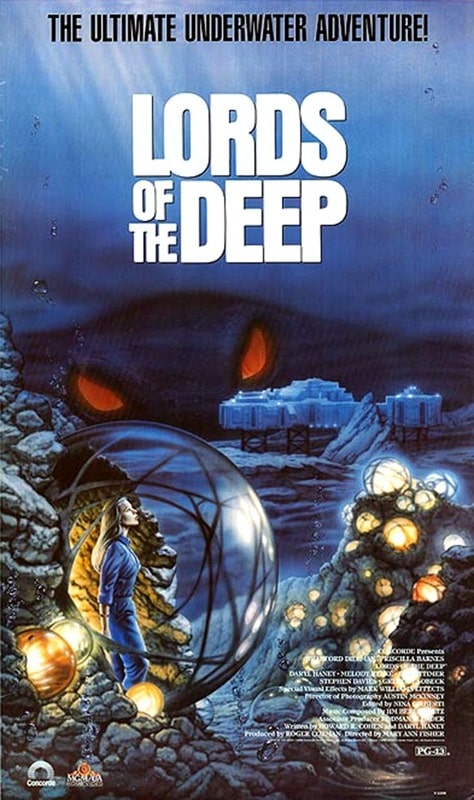
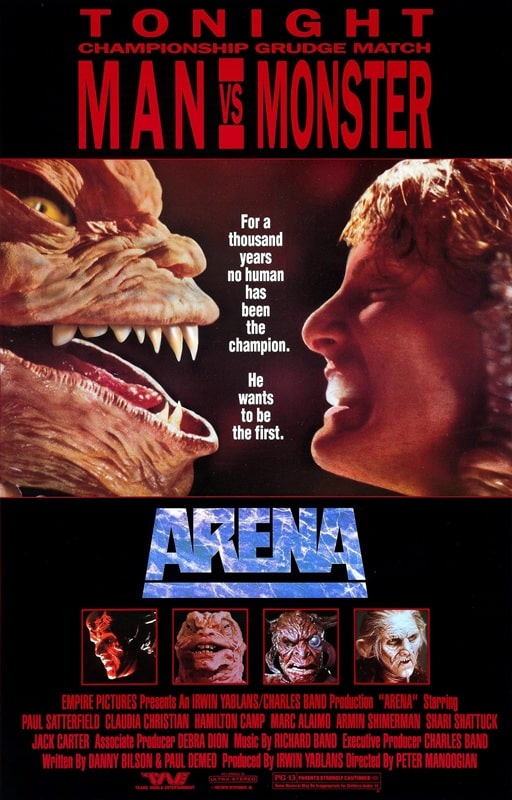
Lords of the Deep (Concorde Pictures, April 21, 1989) and Arena (Empire Pictures, March 29, 1989)
Fancied some cheap-looking rubbish, and luckily Tubi has an extensive Roger Corman collection.
It is the future, and once again we have messed up the planet. Therefore humanity has turned to the depths for somewhere new to screw up, and we hang with the crew of an exploratory vessel as they look for something or other. Lots of blue jumpsuits and sparsely decorated corridors ensue, before it all goes a bit Abyss, and the aliens start doing their thang. The undersea aliens messed up their own world and are here to tell us, in condescending Gort fashion, to stop our shenanigans. The aliens, a cross between a badly-folded fitted sheet and a flip-flop, are actually nice — so why are crew members dying? Could it be something to do with shifty-looking Bradford Dillman? You’ll never guess.
Fun fact: while reading up about this flick, I learned that two-time Oscar winner Janusz Kamiński was the DP, but was fired for being too good. Roger also cameos in this, but then he cameos in everything, bless him.
All in all, a bit pants.
3/10
Arena (1989)I wanted to chase the previous slice of Corman bunkum with one of his would-be heirs, and Charles Band has always been a reliable option. Empire Entertainment was catnip to weirdos like me in the 80s and yet, to my shame, I never got around to seeing Arena.
Well, I’ve fixed that oversight, and I’m jolly glad I did.
Empire is the company that churned out a ton of cheapo gore fests, normally with an incredibly daft premise, including beloved classics such as Ghoulies, Terrorvision, and Troll — and also produced stone-cold classics such as Trancers, Re-Animator and From Beyond.
Charles must have had decent cash flow going on, because he threw a bunch at this film — the production design is pretty good and the film is chockablock with prosthetics, animatronic beasties and derpy background artists. That said, one fun activity to do while watching is to count the mannequins in the medium crowd shots and the wiggling Q-tips in the wide shots. It’s all good though — clever mattes and inspired shot choices really pull this film together.
The story is about the heroically-named Steve Armstrong, a short-order cook who is handy with his fists. He ends up on the fighting circuit, and has the chance to be the first human in a long time to be champ. It’s all very Rocky, but everyone gives it their all, from Paul Satterfield as Steve, to Claudia Christian as his ‘owner’, Quinn. There’s a fun turn by Armin Shimerman under a couple of pounds of rodent rubber, playing a scummy henchman called Weezil, and Hamilton Camp playing a four-armed Nebulan called Shorty.
It’s all very silly, the actual fights are hilariously great and Richard Band’s music is on point. I had a fun time.
7/10

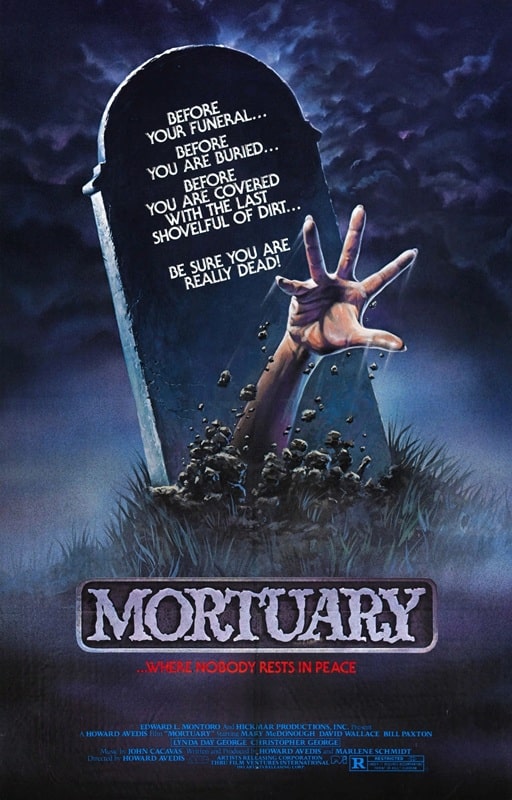
Zombie Ass: Toilet of the Dead (Nikkatsu, September 24, 2011)
and Mortuary (Film Ventures International, May 7, 1982)
This is the 25th review in our Tubi Dive, and we celebrate the quarter-century mark with quite possibly the most bonkers, disgusting, and hilarious film so far.
I’ve been a fan of Noboru Iguchi ever since I sat down to watch Machine Girl featuring the mind-blowing special effects of Yoshihiro Nishimura (who went on to direct Tokyo Gore Police), so imagine my delight when I stumbled upon a small collection of his films on Tubi. I’m going to watch them all — and I’ve started with this insanely offensive film.
Traumatized by the death of her sister, karate student Megumi has agreed to go on a camping trip with the usual group of stereotypes. One of her companions, Maki, is a self-absorbed would-be model, and her goal is to find a parasite in a fish, swallow it, and lose weight (not that she needed to). She succeeds, but the resulting tummy rumbles have her rushing to a disgusting outhouse in an abandoned village.
As she pops a squat to clear her bowels, she is attacked from below by a crap-coated zombie and, you guessed it, shenanigans ensue. What follows is some of the most ridiculous, stomach-churning, gory, and childishly fun action scenes you’ll ever see. Iguchi clearly couldn’t give a monkey’s about what anyone thinks of his films, and sets out to have a blast (no doubt satisfying some of his more ‘unsavoury’ tastes) by lacing the film with so many off-the-wall moments, homages to The Evil Dead, unnecessary nudity, hundreds of poop and fart gags, and sexually-charged monster attacks that border on live action anime.
Some shots are poorly done CG, but for the most part the creature and gore effects are practical and messy. I feel like my hyperbole might be getting in the way, but I seriously had such a fun time with this one — and I honestly can’t recommend it to decent folk.
For fans of poop, farts, blood and knickers.
9/10
Mortuary (1982)Just had time to sneak in another old slasher before I carry on with more Japanese nuttiness, and here’s an old chestnut that tries to elevate the slasher genre with zero success.
Christie believes that her father’s drowning was no accident (it wasn’t), but no one believes her; not her red herring of a mother, nor her chad of a boyfriend. Eventually the truth is revealed, but not before some dull stuff happens. Mortuary has all the trappings of a typical slasher (group of friends, creepy backstory, ‘masked’ killer, unusual weapon) but doesn’t follow through on any of them. A shame really, as it could have been a decent romp. It does get bonus points though for featuring an adorable young Bill Paxton.
For completists only.
4/10

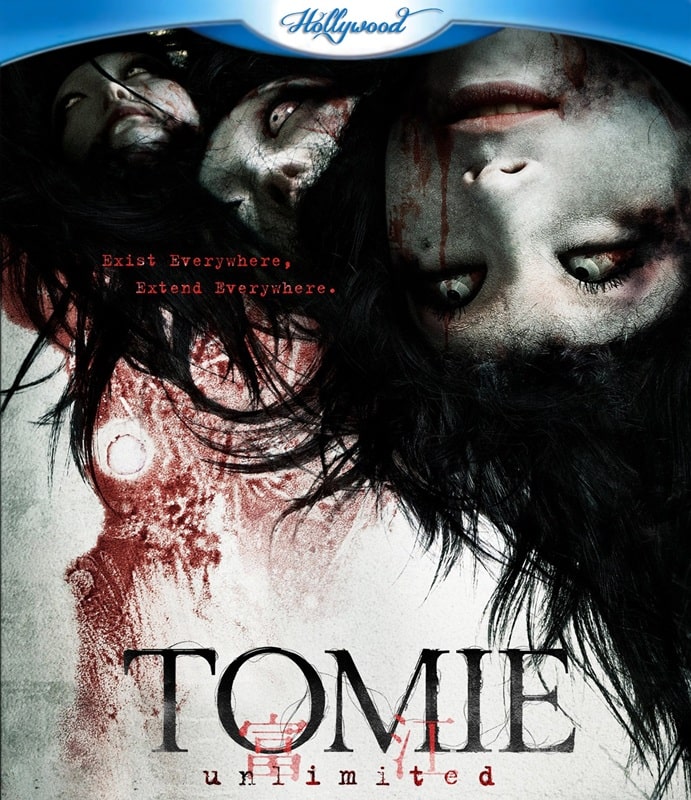
Dead Sushi (Alchemy/Millennium, 2012) and Tomie Unlimited (Toei Company, May 14, 2011)
Next on my Noboru Iguchi-thon is this diamond-encrusted slice of fried gold in video form. As equally bonkers as Zombie Ass, I didn’t enjoy this one quite as much, but don’t let that stop you from taking in this unique form of high culture.
In a nutshell (or seaweed cone), Keiko is the daughter of a famous sushi chef, but when she doesn’t measure up to his standards, she runs away to work as a hostess at a crummy inn. There she becomes embroiled in a surreal revenge story involving chemicals, dodgy sushi and dodgier businessmen.
Imagine for a moment how weird this film could possibly be. You’re dead wrong. It’s much weirder. In fact, one of the less weird moments is a tender scene between a girl and a slice of cooked egg.
Noboru really reminds me of Joe Dante, when Dante is on a live-action Looney Tunes kick (see Gremlins 2 or Twilight Zone), but with much less logic and much more in the way of farting and bosom fetishism.
Utterly stupid, and a whole heap of fun — the opening fight scene alone is worth your time. Watch it, you fools.
7/10
Tomie Unlimited (2011)The Noboru-thon continues with his take on the classic manga series created by Junji Ito. In the graphic novels (and 9 film adaptations), Tomie is portrayed as a demonic force; sometimes a succubus, other times a vengeful spirit, but always she is the catalyst for much screaming, stabbing and head-scratching.
Noboru Iguchi, being a big fan of rubber puppets, really leans into the body horror and has a whale of a time, even if the film is slightly more serious in tone than Dead Sushi or Toilet of the Dead.
There are some astonishingly weird scenes (almost House weird) on offer, with just a few moments marred by dodgy CG. On the whole though, it’s creepy, disgusting, and sublimely daft. Tomie is played really well by Miu Nakamara — she is all angular cheekbones and lacerating looks, and Moe Arai is perfectly cast as her put-upon younger sister. She’s Phoebe Cates adorable, and it is particularly rough to watch her being hurt both physically and mentally.
Not the best of the Tomie films, but certainly worth a look.
7/10
Previous Murkey Movie surveys from Neil Baker include:
Tubi Dive, Part I
Tubi Dive, Part II
Tubi Dive, Part III
What Possessed You?
Fan of the Cave Bear
There, Wolves
What a Croc
Prehistrionics
Jumping the Shark
Alien Overlords
Biggus Footus
I Like Big Bugs and I Cannot Lie
The Weird, Weird West
Warrior Women Watch-a-thon
Neil Baker’s last article for us was Part III of Tubi Dive. Neil spends his days watching dodgy movies, most of them terrible, in the hope that you might be inspired to watch them too. He is often asked why he doesn’t watch ‘proper’ films, and he honestly doesn’t have a good answer. He is an author, illustrator, teacher, and sculptor of turtle exhibits. (AprilMoonBooks.com).
Tor Doubles #4: Samuel R. Delany’s The Star Pit and John Varley’s Tango Charlie and Foxtrot Romeo
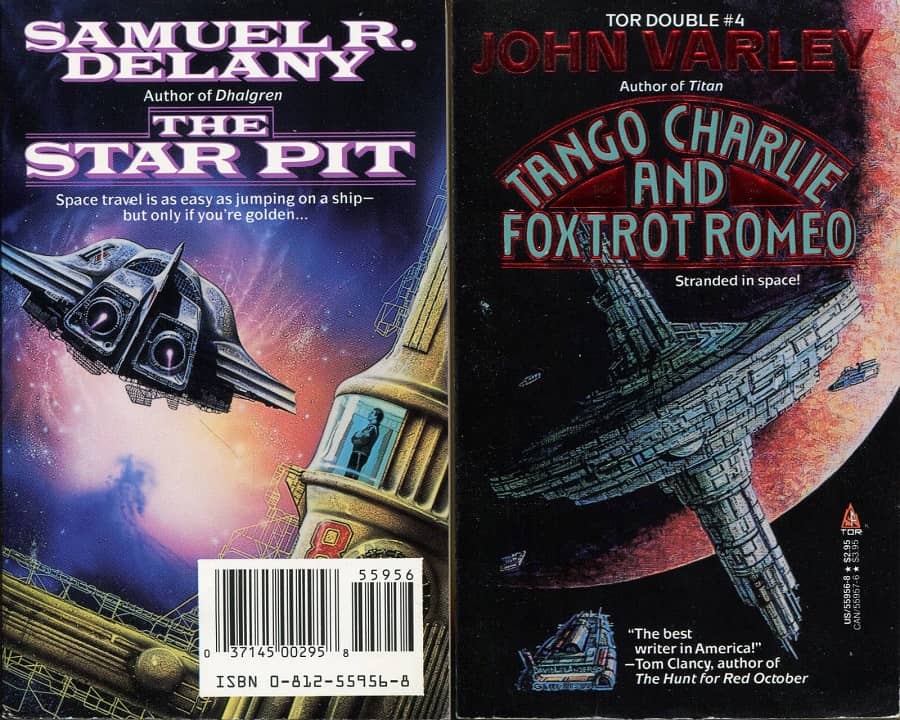 Cover for The Star Pit by Tony Roberts
Cover for The Star Pit by Tony RobertsCover for Tango Charlie and Foxtrot Romeo by David Lee Anderson
Originally published in January 1989, the fourth Tor Double included John Varley’s Tango Charlie and Foxtrot Romeo and Samuel R. Delany’s The Star Pit. Printed in the a tête-bêche format, David Lee Anderson provided the cover by Tango Charlie and Foxtrot Romeo and Tony Roberts was the artist for The Star Pit.
The Star Pit was originally published in Worlds of Tomorrow in February, 1967. It was nominated for the Hugo Award. It lost to Philip José Farmer’s “Riders of the Purple Wage” and Anne McCaffrey’s “Weyr Search,” which tied each other. Coincidentally, McCaffrey and Delany share a birthday.
Vyme, a mechanic at the titular Star Pit, serves as Delany’s narrator. Rather than start with the present day action, however, Vyme opens his narration with memories of his own childhood and his life from several years earlier. Born on the backwater Earth in New York, he talks about his childhood and the ant farm he had as a child, which would eventually break.
He also talks about his life after leaving earth participating in a procreation group, a futuristic group marriage which was meant to make child rearing easier for both parents and children. Mostly talking about his kid-boy Antoni, who had an ecologarium, a sort of ant farm on a larger scale, it is clear that at best, Vyme is an absentee father, using the structure of the procreation group to allow himself to travel off world to take jobs as a mechanic and nursing his alcoholism, which eventually leads to him abandoning his group marriage.
Eventually, Vyme sobers up, but not before he can no longer return to his group family. Instead, he is on a Star Pit, a way station in space which is used to dock and repair spaceships. He is aided in this by Sandy and a young prodigy, Ratlit, who at thirteen has written a novel despite being functionally illiterate. Ratlit also helps out Alegra, a drug-addicted girl two years older than he is.
Vyme, Ratlit, Sandy, and Alegra are living their lives on the Star Pit in a world which has significant space travel, but in order for it to happen, people need to be identified as “the golden,” individuals who can pilot starships and are the only ones who can travel beyond the galactic plane without going insane, although their sanity is in question in any event.
According the Vyme, the golden are stupid and mean and the details of his interactions with them certainly bear that out, as well as a certain pettiness and a parallel society which normal humans can only watch and not fully understand. When one golden kills another in Vyme’s shop, Vyme and Sandy take it in stride. The surviving golden claims ownership of the dead golden’s ship and, not wanting it, hands it over to Sandy.
The plot of The Star Pit, such as it is, is secondary to the characters and their relationships with each other. Despite Vyme’s paternal tendencies toward Ratlit and his mentoring of Sandy, or Ratlit taking care of Alegra and making sure she is being treated for her illnesses, none of the characters seem to particularly like each other. They have been thrown together by circumstances and deal with each other as best that can.
While Vyme presents his background at the beginning of the novella, the other characters’ stories are only slowly revealed, and, while Vyme is not necessarily an unreliable narrator, the explanation for Sandy, Ratlit, Alegra, and, eventually the young golden Androcles, are all viewed through Vyme’s point of view. When Androcles show sup looking for a job, it is clear that Vyme sees him, at least in part, as a surrogate for his own long lost son, Antoni.
There is a certain disjointedness to The Star Pit, perhaps representing the fact that Vyme is not entirely comfortable with his own position and the difficult relationships he has with Sandy and Ratlit, one of whom appears to represent his own failures and the other of whom represents the possibilities a young Vyme drank away and squandered.
The Star Pit postulates a galaxy in which humans have spread, but its tight focus makes the galaxy feel like a very small place. While the golden have the ability to travel, most humans are limited as to where they can go, which is a response and reaction to all the stories of galactic empires and humanity expanding throughout the galaxy and universe.
Rich Horton discussed The Star Pit in the essay “An Evocation of the Science Fiction Dream of Exploration: ‘The Star Pit’ by Samuel R. Delany” in Black Gate in December 2020.
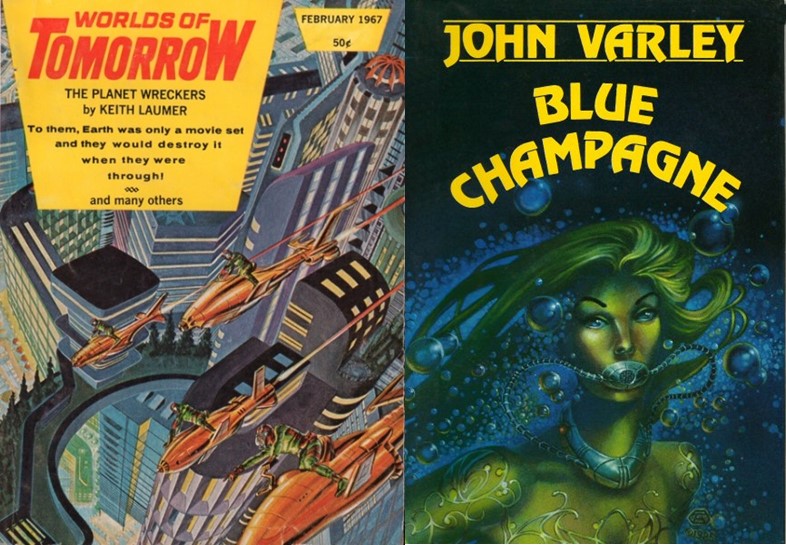 Worlds of Tomorrow 2/67 cover by Gray Morrow
Worlds of Tomorrow 2/67 cover by Gray MorrowBlue Champaign cover by Todd Cameron Hamilton
Tango Charlie and Foxtrot Romeo was originally published in the John Varley collection Blue Champagne by Dark Harvest Press in January, 1986. It won the Seiun Award in 1992.
Tango Charlie and Foxtrot Romeo was originally published in the John Varley collection Blue Champagne by Dark Harvest Press in January, 1986. It won the Seiun Award in 1992.
Like The Star Pit, Tango Charlie and Foxtrot Romeo takes place on an outpost, although it isn’t as distant as the one in Delany’s story. Instead, Varley’s focus is on a space station in orbit around Earth’s moon and the story opens with the remains of a dead dog being expelled through the station’s airlock, which is noted by a satellite which in stationed to track anything that comes out of the space station.
It turns out that the space station had been struck by a virus, Neuro X, thirty years earlier and quarantined. The expulsion of the dog is the first indication the Lunarians have that there is anything still alive on the space station. Varley story follows Anna-Louise Bach, a recruit/apprentice at the New Dresden Police Department on the moon and Charlie, a young girl who is living alone on the space station in the company of dozens of dogs.
The first half of the story deals with an assessment of the situation, Bach trying to figure out how to make contact with whoever might still be living on the space station and Charlie living her life surrounded by dogs and the station’s computer Tik-Tok, and becoming aware that someone is trying to contact her from the outside world. Eventually, contact is made and a resolution to the situation must be found. That resolution is made more difficult by information that Varley slowly reveals.
In the space of the novella, Varley creates three different societies to various degrees. The most obvious ones are the simple society that surrounds Charlie on the space station, with her interactions with the dogs, the chores that she must do, and the way she comes to terms with growing up. The second is the Lunarian society, which is clearly separate from that of Earth, beginning with fashion, but continuing to attitudes. Finally, Terrestrial culture is represented by Bach’s acquaintance Megan Galloway. Galloway is a celebrity on Earth who has a history that involves Bach. They don’t like each other, but find the can use each other to achieve their ends.
The nature of the story, following Charlie and her dogs and switching to follow Bach, means that Varley is essentially writing two intertwined stories. Charlie’s story is one of someone living on an abandoned space station, content and understanding of her world, until outside forces intrude and try to force their way of thinking on her. In many ways, Charlie is an alien race that the humans of Luna are attempting to colonize, although they wouldn’t see it that way.
The humans on Luna see themselves trying to understand the fate of a failed human colony on the Tango Charlie space station. The know that the disease that eradicated the station’s population could cause a deadly pandemic on the moon or Earth if it were released. At the same time, they have discovered that Charlie (and the dogs) have somehow managed to survive it and could offer hope for humanity if they could be studied. Unfortunately, the security system in place to make sure no contaminants escape the space station make it difficult to explore those possibilities.
As the novella progresses, Varley hints that something about Charlie may provide clues to either immortality or the impeding of aging. He also offers information about the nature of the Neuro X virus and the future of Tango Charlie, the space station upon which Charlie is resident. Some of the ideas Varley offers up in the story are seen to fruition while others are abandoned, leaving the story feeling a little unresolved, even as Varley does offer a resolution to most of his plot points. This also means that Tango Charlie and Foxtrot Romeo feels like it is part of a larger world.
 Steven H Silver is a twenty-time Hugo Award nominee and was the publisher of the Hugo-nominated fanzine Argentus as well as the editor and publisher of ISFiC Press for eight years. He has also edited books for DAW, NESFA Press, and ZNB. His most recent anthology is Alternate Peace and his novel After Hastings was published in 2020. Steven has chaired the first Midwest Construction, Windycon three times, and the SFWA Nebula Conference numerous times. He was programming chair for Chicon 2000 and Vice Chair of Chicon 7.
Steven H Silver is a twenty-time Hugo Award nominee and was the publisher of the Hugo-nominated fanzine Argentus as well as the editor and publisher of ISFiC Press for eight years. He has also edited books for DAW, NESFA Press, and ZNB. His most recent anthology is Alternate Peace and his novel After Hastings was published in 2020. Steven has chaired the first Midwest Construction, Windycon three times, and the SFWA Nebula Conference numerous times. He was programming chair for Chicon 2000 and Vice Chair of Chicon 7.
Goth Chick News: Spirit Halloween Levels Up with Haunted: Halloween ’86 – Spirit Edition
 Haunted Halloween ’86 from Spirit Halloween
Haunted Halloween ’86 from Spirit Halloween
The only thing I like better than blowing a whole day playing video games, is playing retro video games. Of course I love movie-quality HD graphics, but little pixelated Lego-people give me a case of the warm fuzzies. I did some digging and discovered I’m far from alone. The global retro gaming market has experienced significant growth in recent years. For instance, the NES Classic Edition sold 2.3 million units in less than a year, and the SNES Classic Edition surpassed 5 million units globally. The Sega Genesis Mini also exceeded 1 million units sold worldwide in its first year. Additionally, the arcade gaming sector, closely tied to retro gaming, was valued at $19.0 billion in 2023.
But when I think of one of my favorite retailers crossing over into retro-gaming, I most definitely get the fan girl squees.
Spirit Halloween, the annual haunt-headquarters that pops up every fall in the unused strip mall space near you, has just announced Haunted: Halloween ’86 – Spirit Edition, a pixelated plunge into Halloween nostalgia brought to you by Retrotainment Games.
Set in the cursed town of Possum Hollow, Haunted: Halloween ’86 is the lovechild of old-school beat-’em-ups and platforming games. You’ll tag-team as Donny and Tami, two tweens armed with fists, feet, and some serious determination to save their town from ghoulish doom. The Spirit Edition adds an additional storyline that brings the action from 1986 into 2025. Two modern-day characters don costumes at Spirit Halloween and are magically transported to 1986 by none other than Jack the Reaper himself.
Yes indeed, it is as delightfully weird as it sounds.
For $59.99, the Spirit Edition comes with a custom NES cartridge, a retro-style game box, and a user manual (because no one remembers how to work an NES anymore).
Not rocking an NES? No problem. Haunted: Halloween ’86 is also available digitally on the Nintendo Switch, Xbox One, and Steam. These versions deliver the same 8-bit thrills without the struggle of blowing dust out of your console.
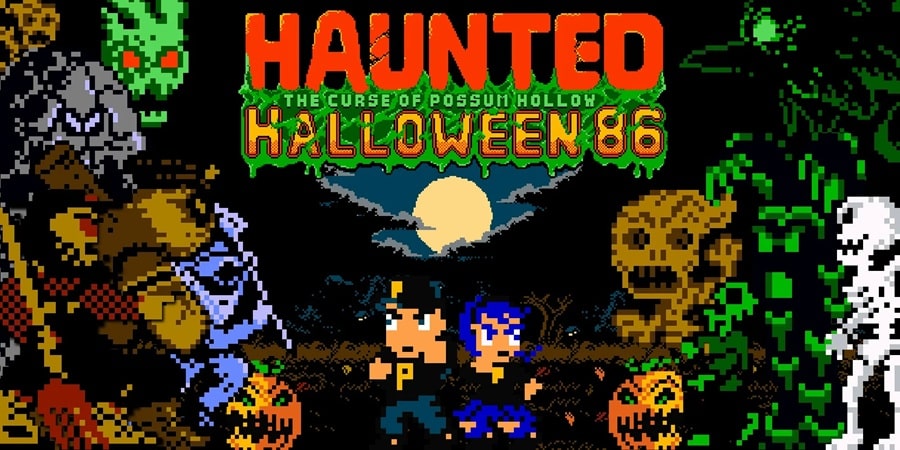 Haunted Halloween ’86
Haunted Halloween ’86
Call me naive, but I honestly believe this isn’t just a nostalgic cash grab. Retrotainment Games built Haunted: Halloween ’86 using authentic 6502 Assembly language, sticking to NES hardware specs. The game serves up modern mechanics like combo moves, upgradeable power-ups, and physics-based momentum. Add seven sprawling levels and some gnarly bosses, and you’ve got a treat worth trading all your Halloween candy for. Digital formats are coming this summer, with no specific release date announced as of now. But if you’re after the collectable cartridges those come directly from Spirit at their website and they literally sold out in a couple of hours. Restocks are coming, but no date on that yet either.
Looks like we all really love the retro experience.
Odd Old Indie: Night Tide
Growing up in Southern California in the 60’s and 70’s was a movie lover’s dream. Late night and weekend television in those days was almost completely given over to old movies, especially on the Los Angeles independent channels: KTLA channel 5, KHJ channel 9, KTTV channel 11, and KCOP channel 13.
The independent stations were especially prone to showing independent movies, small films that hadn’t cost much and hadn’t made much and could be acquired cheaply to occupy all the time that had to be filled until sign-off and the test pattern. Many of these movies were from the House of Corman (The Little Shop of Horrors, The Masque of the Red Death, Dementia 13), but most weren’t, and any night of the week you could watch a pulse-pounder like The Flesh Eaters, The Incredibly Strange Creatures Who Stopped Living and Became Mixed-Up Zombies, or Beast of Blood (once you had advanced — or descended — to Filipino horror movies you could consider yourself a schlock PHD.)
Most of these films were awful, of course (that’s how you wound up on channel 13 at two in the morning), but sometimes a (relative) diamond could be found among the ashes. One movie that I discovered during those years was Night Tide, an odd little indie that aimed a bit higher than the usual cheapie thriller. I was always happy when it popped up in the week’s TV Guide listings.
Made in 1960 and first screened in 1961, but not widely released until 1963 due to distribution confusion (it has a Corman connection after all, because it was released through Filmgroup, his distribution company) and directed by Curtis Harrington, it’s an offbeat film that has all of the expected deficiencies of a micro-budget independent movie along with some unexpected virtues. (It was supposedly made for $25,000, which wouldn’t even cover George Clooney’s carfare today.)
Clearly taking his inspiration from the series of nine horror films that Val Lewton produced for RKO in the 1940’s (Night Tide owes most to the first of them, 1942’s Cat People), Harrington (who wrote the script as well as directed) tells an ambiguous, poetic, melancholy story in an allusive, indirect way. Making a virtue of poverty, Harrington allows the viewer to fill in everything that is only suggested (because it would cost too much to show it), which was very much the strategy Lewton followed in making his underfinanced gems.
Night Tide is the story of a USN sailor, Johnny Drake (a twenty-five-year-old Dennis Hopper in his first lead role) and Mora (Linda Lawson), a young woman who appears as a mermaid in a boardwalk sideshow. (Most of the movie was shot just west of Los Angeles in Santa Monica.)
Strolling along a beachfront street one night, Johnny drops into a jazz club where he sees Mora sitting alone, raptly listening to the music. Struck by her dark beauty, Johnny asks if he can sit at her table to get a better view of the players. Mora agrees, but brushes aside the sailor’s attempts at conversation. While they are sitting there, a strange, black-clad, intense-looking woman comes up and speaks to Mora in a foreign language. The woman walks away, and Mora, visibly upset, rushes out of the club.
Johnny, desperate to make some kind of connection with this intriguing woman, follows Mora down the darkened street, all the while trying to persuade her to talk with him. Perhaps sensing a loneliness equal to her own and touched by his sincerity, Mora permits Johnny to walk her to her home above a carousel. She rebuffs his request to come upstairs with her, but she permits him to clumsily kiss her goodnight, and leaves him with an invitation to come back in the morning, when she will fix him breakfast.
When Johnny returns the next day, he first takes a look at the merry-go-round under Mora’s apartment, where he meets the ride’s operator and his granddaughter Ellen (Luana Anders), who both respond a little oddly when they hear that he’s there to visit the sideshow mermaid.
When Johnny goes upstairs, Mora greets him warmly and leads him through an apartment decorated with souvenirs of the sea, to a balcony overlooking the ocean, where they will have their breakfast. (Seafood, naturally.) During their conversation, the sailor and the enigmatic young woman shyly begin to get better acquainted.
Mora tells him about her job — “I wear an artificial fishtail and I lie in a tank that looks like it’s filled with water, and people pay twenty-five cents and come and look at me, and that’s how I make my living.” When Johnny asks her if she ever gets tired of it, she wistfully replies, “Sometimes — but it’s restful, anyway.”
When Mora asks Johnny to tell her something about his life, he tells her that he is alone in the world; his father left home when Johnny was just a boy, and when his mother died, he thought that the best way to get away from Denver, Colorado was to join the navy and see the world. “But I haven’t seen any of it yet.”
Then, as they are finishing their meal, an odd thing happens. A scavenging seagull swoops down on the table looking for scraps, and Mora takes it in her arms and gently strokes it and talks to it, and the wild creature seems perfectly calm and content. When Johnny asks her where she learned to do such a thing, Mora says that she doesn’t remember.
After their breakfast is done, they go down to the boardwalk and Johnny meets the man who owns the mermaid attraction and serves as its barker, Captain Samuel Murdock (Gavin Muir). He found Mora when she was a child on the Greek island of Mykonos, and brought the orphaned girl back to the United States as his ward. Murdock tells Johnny to drop by his house sometime; he will tell him some interesting things about his adoptive child.
Soon Johnny is spending every liberty with Mora, and even as they grow closer, the young sailor’s disquiet also grows, as he hears some strange things about his new girlfriend. Ellen (who is clearly attracted to Johnny) and others tell him that two young men who had grown close to Mora drowned in mysterious circumstances; the police are still investigating the deaths.
And one night on the beach, where people have gathered for a party, a curious thing occurs. A musician plays the bongo drums, and Mora begins to dance on the sand; as her movements grow wilder and more ecstatic, she looks toward the ocean and sees, standing silently there, watching her, the black-garbed woman who spoke to her in the jazz club. Johnny sees her too. Mora collapses in a swoon, and when Johnny rushes to her to see if she’s alright he looks around for the woman, but she is gone. The woman vanished n the few seconds it took him to get to Mora.
Increasingly worried, Johnny decides to visit Captain Murdock at his home in cement-canaled Venice, and as he nears the house, he sees the woman again. He pursues her, but she evades him in the maze of canals and bridges. When he arrives at the house, the captain gives him an effusive welcome, but soon adds to Johnny’s unease by telling him that he is in grave danger as long as he continues to see Mora, that the gentle-seeming girl might feel “compelled” to kill him. Before he passes out from drink, Murdock tells the disbelieving sailor that Mora is a siren, a member of the ancient race of sea people who lure men to their doom.
When Johnny tells Mora the captain’s story, she tells him that it’s true — “They are waiting for me to join them.” She believes that the strange woman who is following her is one of the sea people, “here to remind me of the time I must go to them in the sea.” Johnny’s scoffing at this absurd tale can neither shake Mora’s belief in her alien nature and her dark fate, or silence his own growing anxiety.
Visiting Mora after she finishes work one day, Johnny falls asleep on the couch while she takes a shower. He dreams that a towel-wrapped Mora walks out and sits by him on the couch, and looking down, he sees that her legs have turned into a fish’s tail; she is truly a mermaid, a creature not fully human. She leans over and begins to kiss him, and suddenly it is not the arms of a beautiful young woman that enfold him — he is entangled in the grotesque tentacles of a huge octopus, strangling him, devouring him. (This terrifying episode is probably Night Tide’s best-remembered scene.)
When Johnny awakens from this nightmare, he calls out to Mora but receives no answer. She has disappeared. Johnny follows her wet footprints out of the apartment and down to the beach. After frantically searching he finally finds her clinging to the pilings under the pier, barely holding on as she is battered by the waves of the incoming tide. As he carries her back to her apartment, she tells him that the sea people were calling her to them.
The next morning, Mora is strangely calm and later, after telling Johnny that the tides will be perfect (because the moon is full), she urges him to go diving with her at special place that she knows. (A few days earlier Johnny had visited a boardwalk Tarot reader who made ominous hints about his future due to the placement of the Moon card.) Johnny uneasily tries to convince Mora that a dive isn’t a good idea, but, unable to dampen her puzzling enthusiasm, he finally agrees.
Taking out a small boat, they make their dive (after Mora cautions the visibly nervous sailor to stay very close to her), and when they’ve gone down to the deepest point, Mora gets behind Johnny and cuts his air hose. As he desperately fights his way back to the surface, he looks back and sees Mora swimming away into the darkness. After waiting in the boat until long after her air would have run out, Johnny takes the boat to shore and stumbles back to Mora’s apartment, where he falls into an exhausted, troubled sleep.
There he has one last dream of this strange, ill-fated young woman — he sees her as a mermaid, sitting on the rocks with the waves crashing about her, an unreadable expression on her face as she regards herself in a mirror. When Mora turns and sees him, she slips into the churning water. Johnny reaches out and takes her hand, trying to pull her back up onto land, but he is not strong enough to overcome the immense power of the ocean’s pull, and a laughing Mora finally slips away from him and vanishes beneath the surface of the sea.
Later that rainy night, he wakes from this sleep, shaken and desolate, and walks to the boardwalk. Going into the mermaid exhibit, Johnny hesitantly looks into Mora’s tank, where he is stunned to see the body of the drowned girl floating face-up in the water, her hair streaming around her. She is still beautiful, even in death.
Captain Murdock (who found Mora’s body on the beach) emerges from the shadows with a gun in his hand and accuses Johnny of killing her, which the young man denies — “But I loved her.” “You loved her! What do you know about love?” Murdock replies. “I’ve loved her ever since she was a child. You did it and you must pay for it!” Murdock fires at Johnny but misses, and the shots bring the police, who take both men into custody.
At the police station a distraught Murdock makes a confession to a detective (and to Johnny — he asked that the sailor be present). When she was still a child, he began telling Mora that she was one of the sea people in the hope that it would keep her from forming close relationships with anyone else, and so prevent her from ever leaving him. Ultimately, even that didn’t keep Mora from wanting something more, and the captain killed her two boyfriends and made his ward believe that her inhuman nature was somehow responsible for their deaths; he just couldn’t bear the thought of losing the only person in the world he loved, the only person in the world who loved him.
Murdock’s “experiment in psychology” worked only too well; Mora “couldn’t face a recurrence of what had gone before, so rather than destroy the person she loved, she decided to embrace the rapture of the depths.”
The only thing left to clear up is the identity of the mysterious woman — was she an accomplice of Murdock, someone he had paid to follow Mora to remind her of her supposed evil destiny? The broken old man has never seen such a woman, never heard of her. She was part of no plan of his.
When Murdock is led out of the detective’s office, he gently pats Johnny on the shoulder, a sad little gesture between two men who will forever be linked by the loss of the woman they both immoderately loved.
The shore patrol arrives to take Johnny back to his ship, and Ellen is waiting at the desk to express her sympathy and to say goodbye. Maybe on his next liberty, Johnny can come by and take a ride on the carousel? The sailor smiles hesitantly and says that it seems like a good idea. As he walks out of the police station, the rain has ended, and a new day is dawning.
 Gavin Muir and Curtis Harrington
Gavin Muir and Curtis Harrington
The film closes with the lines from Poe’s “Annabel Lee” that gave it its title: “And so, all the night-tide, I lie down by the side / Of my darling — my darling — my life and my bride, / In her sepulchre there by the sea — / In her tomb by the surrounding sea.”
So, what do we have here? Is Night Tide a brilliant achievement, a neglected masterpiece? You can judge for yourself (there’s a very nice print on YouTube, though there wasn’t several years ago when I bought my Kino Lorber Blu-ray), but it’s not necessary to go quite that far.
You don’t have to look very hard to find Night Tide’s defects. The story, as I said before (and as Harrington always acknowledged) borrows heavily from Cat People, which is a better, more original film, and even if you’re not familiar with the earlier movie, it’s not too difficult to see where the story is going (Captain Murdock’s big revelation isn’t much of a surprise); the dialogue is sometimes stilted, both in the writing and in the delivery by the actors, some of the supporting playing is erratic, and the mark of the low budget is visually evident in dozens of ways.
But many of these failings have a positive aspect, too. If you’re going to pick a model, Cat People is a strong one, and many of its virtues are evident in its successor, while the low budget compelled Harrington to stick to the commonplace in costumes and sets, giving the movie a much-needed grounding in everyday reality (while also permitting the director to concentrate on character rather than on special effects). Despite a few overtly arty touches, the black-and-white cinematography (much of which was shot at night), strongly conveys the darkness and moody ambiguity of the story. (The film’s flute-heavy jazz score by David Raskin is both a plus and a minus; sometimes it’s delicate, eerie, and just about perfect, while at other times it’s discordantly, distractingly obtrusive.)
Perhaps the film’s greatest assets are Dennis Hopper and Linda Lawson. Both were experienced television actors in 1960, but Night Tide was the first movie lead for both of them, and the awkwardness and uncertainty that are sometimes detectable in their performances actually suit their characters very well. Hopper is convincingly shy and callow (a “fair young man, innocent and searching” as the Tarot reader calls him); his yearning for human contact comes across as touchingly genuine. (At the beginning of the movie, Johnny has some pictures taken in an automated photo booth; he puts his hat on, takes it off, smiles, looks serious… and then tucks the pictures into his pocket and walks away. He has no one to give them to.)
Linda Lawson, despite not being gifted with a very expressive voice, nicely coveys a loneliness and a consciousness of being separated from “normal” people that matches Johnny’s intense desire to connect with someone; she makes the lost, doomed Mora a moving, tragic figure.
Night Tide uses its limited resources to try for something different than the usual rubber-monster-on-the-loose quickie; it’s a mood piece in which feeling and atmosphere are more important than plot, a poetic, offbeat combination of fantasy and horror and mystery, wrapped around an ill-starred, very human love story. In some ways it’s almost an amateur film, but it’s none the worse for that. (Remember that one meaning of amateur is someone who does something just for the love of it.) The movie has a unique flavor, sweet and sad, and for all of its (understandable and forgivable) deficiencies, it lingers in the mind; it gets under your skin.
You can always recognize a film that was truly important to the people who made it, and Night Tide is one of those; clearly, it wasn’t just another job to Curtis Harrington, Dennis Hopper, Linda Lawson, and the rest of the people who worked on it — it meant something to them. If you give it a chance — say late some lonely night — you might find that this old, odd little movie has come to mean something to you, too.
Thomas Parker is a native Southern Californian and a lifelong science fiction, fantasy, and mystery fan. When not corrupting the next generation as a fourth grade teacher, he collects Roger Corman movies, Silver Age comic books, Ace doubles, and despairing looks from his wife. His last article for us was The Eccentric’s Bookshelf: Michael Weldon’s Psychotronic Encyclopedia of Film
Swordfights, Mysteries, and Dark Sorcery: Solomon Kane: The Serpent Ring #1 by Patrick Zircher
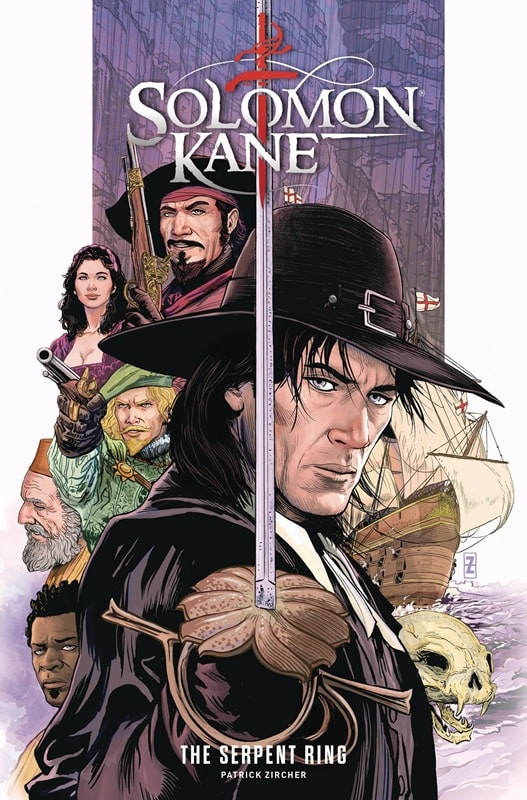
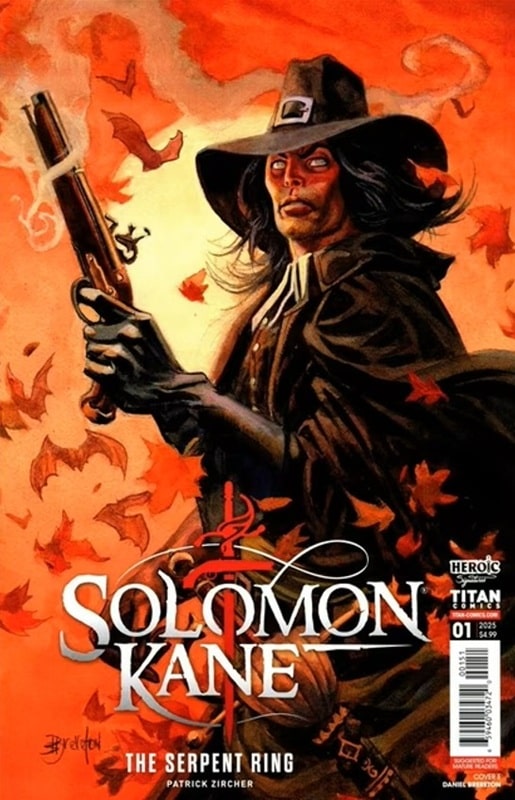
Solomon Kane: The Serpent Ring #1, and variant cover by Daniel Brereton (Titan Comics, March 26, 2025)
Sometimes a project and a creator are brought together in the right place at the right time. Titan Comics’ Solomon Kane mini series The Serpent Ring is one of those times. Writer/Artist Patrick Zircher is working at the very top of his game. The project is dear to his heart, and it shows.
The first issue begins, fittingly enough, in Africa. This would have pleased Kane’s creator Robert E. Howard, because some of REH’s best Kane tales, “The Footfalls Within,” “The Hills of the Dead,” “Wings in the Night,” etc, take place on that continent.
[Click the images to ring in bigger versions.]
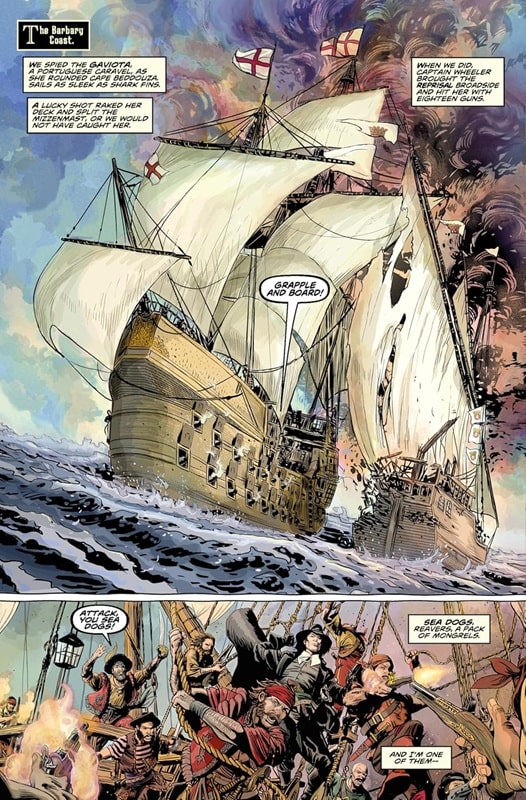
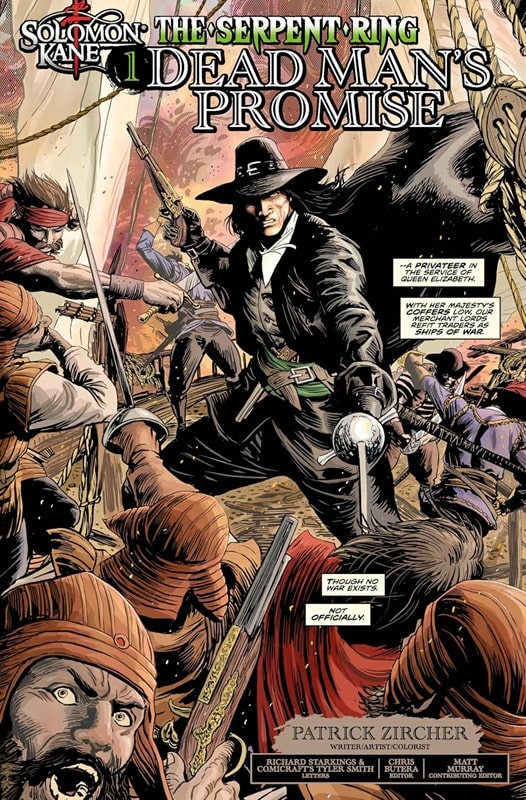
Interior art for Solomon Kane: The Serpent Ring #1 by Patrick Zircher
The first few pages of the comic are a prologue introducing some mysterious characters and incidents. We pick up with Solomon Kane three pages later, serving with a band of Queen Elizabeth’s privateers. Kane and his companions are in a pitched battle with the crew of a Spanish ship.
In an unfortunate occurrence Kane kills a passenger, ‘an innocent man,’ and makes a promise to the dying man to atone for his mistake. This sets the main plot in motion and Kane’s quest will take him from the Barbary Coast to Italy. On the way there will be swordfights, pistol battles, mysteries added to mysteries, and intimations of dark sorcery.
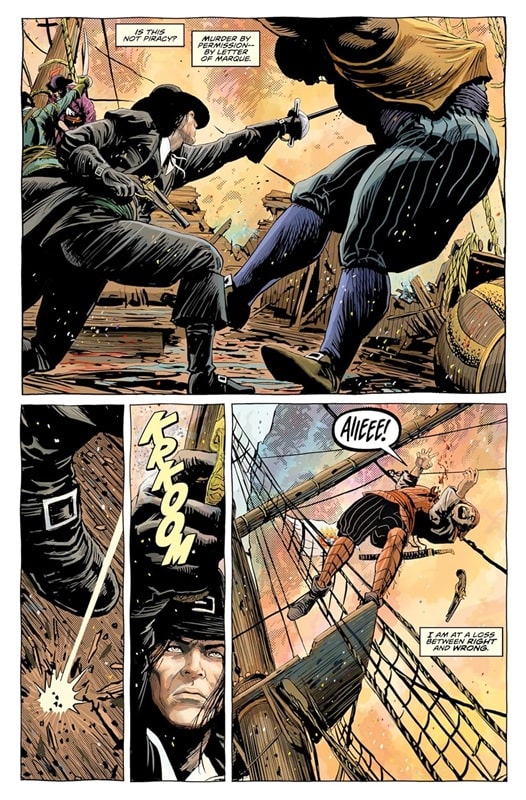
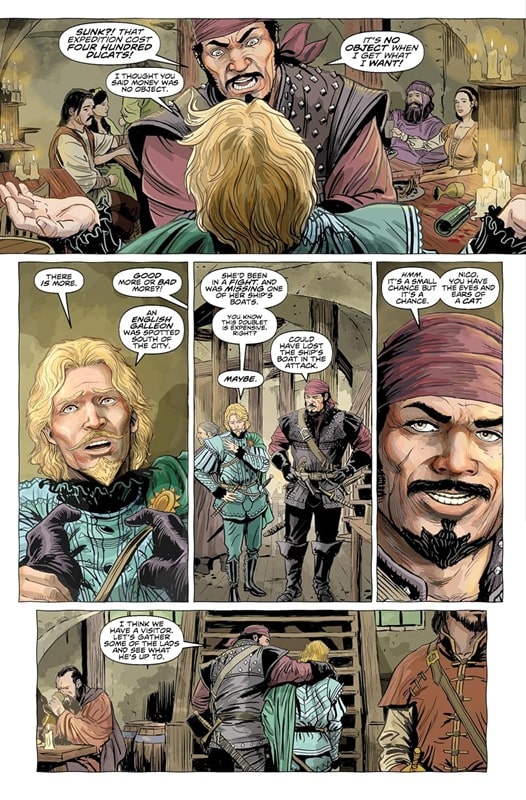
More interior art for Solomon Kane: The Serpent Ring #1 by Patrick Zircher
That’s all the plot I’ll give away, because you should read it for yourself, so let me talk a bit instead about Patrick Zircher’s work on the comic. Having spoken to Patrick online a good bit, I know this is one of his favorite comics he’s ever worked on. He’s a huge fan of Solomon Kane and it really comes through on the pages.
The story has an epic feel as it ranges around Europe, and a large cast of characters. All of that is well researched and beautifully illustrated, be it sailing ships or the streets of Napoli and Venice. Period costumes, weapons, and people are all extremely well done.

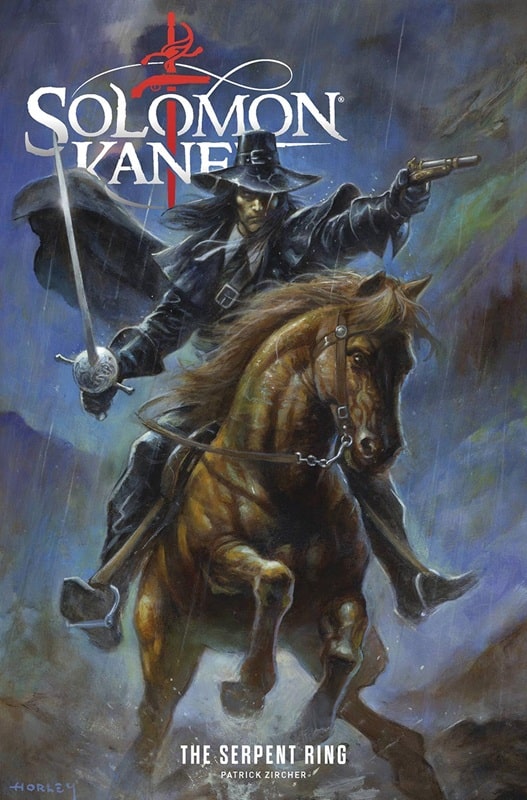
Issues #2 and #3 of Solomon Kane: The Serpent Ring. Covers by Rafael Kayanan and Alex Horley
For the Robert E. Howard fan this is prime stuff, Solomon Kane drawn and written by someone who loves the character and the world. It’s very much in the spirit of Howard’s work. I asked Patrick for a quote about his feelings working on the book and he said:
Solomon Kane embodies, in one character, what I love in stories. Action, adventure, suspense, horror, heroism, and wrestling with the ‘big questions’ of life.
Can’t ask for more than that.
Charles R. Rutledge lives in Atlanta, Georgia. This is his first article for Black Gate.
What I’ve Been Reading: April 2025
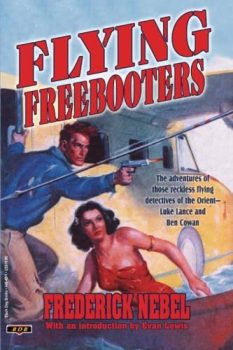 I continue to listen to audiobooks daily. They fit my lifestyle and let me get to a lot more stuff than I would if I just read. I mean, driving with a paperback in hand is quite the challenge!
I continue to listen to audiobooks daily. They fit my lifestyle and let me get to a lot more stuff than I would if I just read. I mean, driving with a paperback in hand is quite the challenge!
I just re-listened to the entire SPQR mystery series by John Maddox Roberts (who I have written about several times, including here). No way I could have sat down and re-read all thirteen.
And I plodded through listening to all 44 hours of Toll of the Hounds, the eighth book of Steven Erikson’s Malazan Book of the Fallen. It was the first book in the series I didn’t really care for – possibly because I don’t like the narrator. But I’ve had a paperback copy on the shelves for ten years, I think. At least I worked in listening to it. I have the audiobook for Dust of Dreams, which is just as long. But the same guy read the whole series, and I don’t want another 40+ hours of him.
But, I do like to still read a physical copy. So, let’s get to what I’ve been checking out on the printed page.
FLYING FREEBOOTERS – Frederick Nebel
Nebel’s is the second face on my Hardboiled Mt. Rushmore (Hammett on one side, Norbert Davis on the other). I’m not into the Aviation Pulps, but I am a fan of Nebel’s Gales & McGill action stories. I added several of Nebel’s Pulp Collections from the Black Dog Books table at Windy City. This included some of his other aviation stories. And I’m becoming more of a fan. Flying Freebooters contains three stories. “Isle of Lost Wings” and “Flying Freebooters first appeared in Wings magazine, in 1930.
Nebel used two organizations for many of his aviation stories. Garrison Airways is a flying service (passengers, mail, and freight) in the Far East. Feisty little Sam Garrison is founder and boss, with hardboiled pilots working for him. I’ve read a couple Garrison stories.
The second, the Strait Agency, is essentially a combination aviation security and private police force, also operating in the Far East. The use of airplanes in these reminds me of Horace McCoy’s Air Texas Rangers stories.
The first story is third person, while the second (and also the third in the book, are first person). These are high action, hardboiled stories that fly along, page after page. Nebel was writing for Black Mask at at this time as well, but he had developed, and continued honing, his craft in the Aviation Pulps. I am enjoying these, and I look forward to the other books I picked up, including some of his Canadian adventures.
MURDER: STRICTLY PRIVATE – Norvell Page
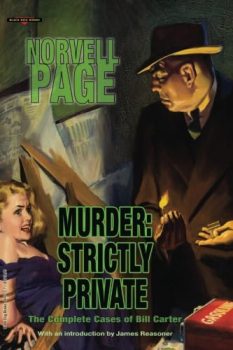 Version 1.0.0
Version 1.0.0
Page is best known as the primary writer of the hero Pulp, The Spider (under the house name, Grant Stockbridge). Like most Pulpsters, he wrote many genres, including weird menace, and G-men stories. I have his limited Western output as a Black Dog e-book.
I really struggle with the Spicy Pulps. Briefly a popular genre, they’re just so goofy I can’t take them seriously enough to enjoy them. I wrote a post on a Robert E. Howard spicy story – and it was more of a saucy-tinged adventure. Whereas, I can’t even finish a Dan Turner (Hollywood Detective) story in one -sitting.
Robert Leslie Bellem’s Turner is the most popular of the spicy detectives, even getting his own magazine. But to me, it’s like a parody of Race Williams. And Williams can be hard enough to absorb, without making it a spicy parody.
Page wrote a series of spicy stories featuring Bill Carter (who is not his Weird Menace star, Ken Carter), an investigative reporter in Miami. This volume collects (all?) twenty of them. Page is still kinda over-the-top for me, but these are FAR more readable than the Dan Turner stories. I’ll work my way through this book.
Speaking of Page, I recently picked up his short novel, Flame Winds, which originally appeared in the June, 1939 issue of Unknown magazine. It’s his take on the Prester John myth. Lamb included the Prester John legend in the Khlit story I’m currently reading now, “Changa-Nor.”
Roy Thomas used the novella for a three-part Conan comic, “Flame Winds of Lost Khitai.” I got the book because I plan on doing a Black Gate post on the whole Flame Winds thing. Should be neat, and I can incorporate the Lamb story as well.
WOLFE OF THE STEPPES – Harold Lamb
Lamb was a prolific Pulpster in the early 20th Century. A historian as well, his adventure stories are detail-filled thrill-rides. There are eighteen tales of Khlit the Cossack, a gray-bearded survivor on the Asian steppes around the start of the 17th Century.
Lamb was a great influence on Robert E. Howard, and Howard Andrew Jones collected all the Khlit stories in four volumes. There are four more books of Lamb’s adventure tales as well. The first story, which was much shorter than the others, didn’t do anything for me. The next three were novella length, and better Then I hit two linked stories: “The Mighty Manslayer” and “The White Khan.” I’m definitely into these tales now. I am reading the next, and I am enjoying Khlit.
Other than REH, I don’t read Adventure stories, but Lamb was good. I’ve read a couple of his Viking, and Crusader, stories, from other books. They were also good reads.
HIRED GUNS – Steve Hockensmith
 In February of 2024, I read/listened to the entire Holmes on the Range series, then I did a new post, a comprehensive chronology, and then a Q&A with Steve. I’m a HUGE fan of these fun Western mysteries, with a Holmes influence. Link to all three posts, here.
In February of 2024, I read/listened to the entire Holmes on the Range series, then I did a new post, a comprehensive chronology, and then a Q&A with Steve. I’m a HUGE fan of these fun Western mysteries, with a Holmes influence. Link to all three posts, here.
Later in 2024, he published two new Hired Guns, and No Hallowed Ground, featuring other operatives of the Double-A Western Detective Agency. I read the first book, and I liked it. These are Western mysteries – no Holmes influence. More like hardboiled cowboy stories. Looking forward to the second one when I can fit it in the schedule. I really enjoy reading Steve’s stuff.
Other What I’ve Been ReadingWhat I’ve Been Reading: November, 2024: (Glen Cook, Dodgers’ baseball)
What I’ve Been Reading: September, 2024 (Harold Lamb, Hugh Ashton, Scott Oden)
What I’ve Been Reading: November, 2023 (Holmes on the Range, The Caine Mutiny, Jules De Granden)
What I’ve Been Reading: September 2022 (Columbo, Douglas Adams, Cleveland Torso Murderer)
What I’ve Been Reading: May, 2021 (Cole & Hitch, Dortmunder, and Parker, and Tony Hillerman)
What I’ve Been Reading: September 2020 (Jo Gar, Sherlock Holmes, Casablanca the movie, more)
What I’ve Been Reading: January, 2020 (Glen Cook, John D. MacDonald, Howard Andrew Jones, more)
What I’ve Been Reading: December, 2019 (Scott Oden, Norbert Davis, David Dickinson)
What I’ve Been Reading: July, 2019 (Clive Cussler, Gabriel Hunt, Max Latin)

Bob Byrne’s ‘A (Black) Gat in the Hand’ made its Black Gate debut in 2018 and has returned every summer since.
His ‘The Public Life of Sherlock Holmes’ column ran every Monday morning at Black Gate from March, 2014 through March, 2017. And he irregularly posts on Rex Stout’s gargantuan detective in ‘Nero Wolfe’s Brownstone.’ He is a member of the Praed Street Irregulars, founded www.SolarPons.com (the only website dedicated to the ‘Sherlock Holmes of Praed Street’).
He organized Black Gate’s award-nominated ‘Discovering Robert E. Howard’ series, as well as the award-winning ‘Hither Came Conan’ series. Which is now part of THE Definitive guide to Conan. He also organized 2023’s ‘Talking Tolkien.’
He has contributed stories to The MX Book of New Sherlock Holmes Stories — Parts III, IV, V, VI, XXI, and XXXIII.
He has written introductions for Steeger Books, and appeared in several magazines, including Black Mask, Sherlock Holmes Mystery Magazine, The Strand Magazine, and Sherlock Magazine.
You can definitely ‘experience the Bobness’ at Jason Waltz’s ’24? in 42′ podcast.
Shai Dorsai: Dorsai! by Gordon R. Dickson
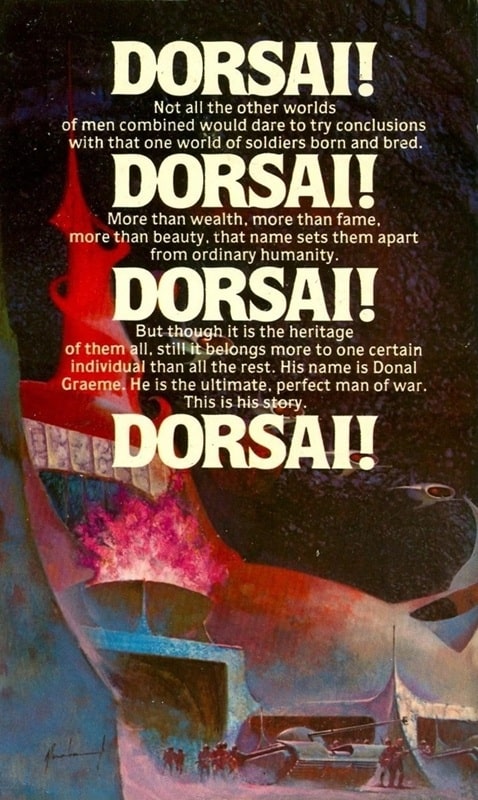
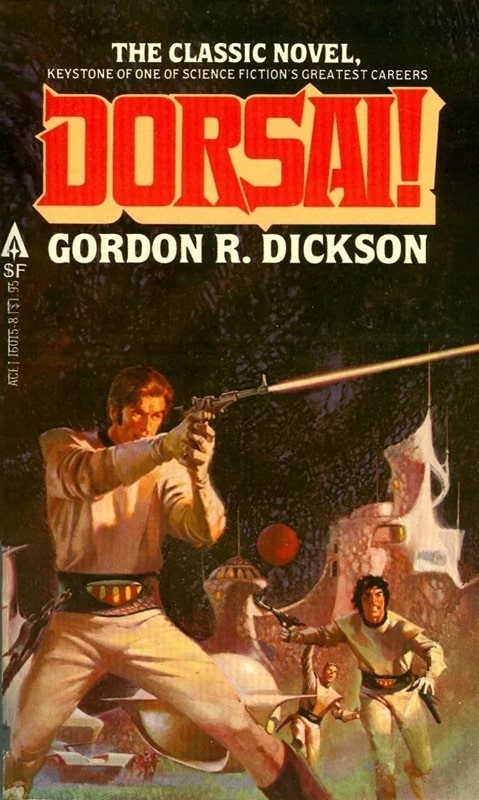
Dorsai! by Gordon R. Dickson (Ace Books, February 1980). Cover by Jordi Penalva
In 1959, Robert A. Heinlein published Starship Troopers, one of the founding works of military science fiction as a genre. But that same year saw the serialization of Gordon R. Dickson’s Dorsai! in Astounding Science Fiction, a work that may have been equally influential, though it seems now to be less remembered. In fact, both were nominated for the Hugo Award in 1960, though Starship Troopers won.
Dorsai! is set in an interstellar future, with some sixty billion human beings inhabiting 16 planets of eight solar systems. Several of the stars are named in the novel, and as was common at that time, many of them are astrophysically implausible candidates to have biospheres, being of spectral types with relatively short lifespans: Altair (type A7), Fomalhaut (type A4), and Sirius (type A0). Fomalhaut and Sirius are also multiple stars, which limits the possible planetary orbits around them. At least Ceta, orbiting Tau Ceti, is a plausible Earthlike planet! It’s also noteworthy that several of these solar systems have multiple habitable planets — though that’s also true of our own, where Dickson has Mars and Venus humanly colonized, a project that seemed far more daunting only a few years later!
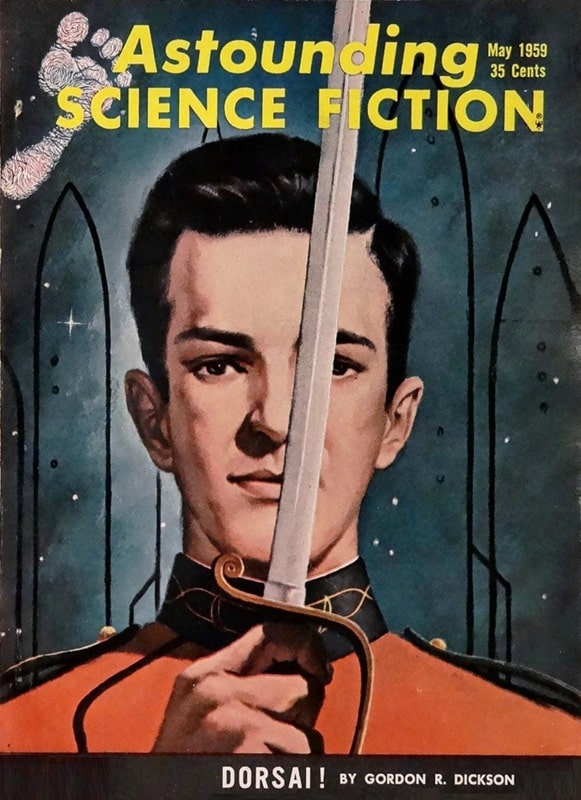 Astounding Science Fiction, May 1959, containing the first installment of Dorsai! by Gordon R. Dickson. Cover art by H. R. Van Dongen
Astounding Science Fiction, May 1959, containing the first installment of Dorsai! by Gordon R. Dickson. Cover art by H. R. Van Dongen
But all this is somewhat beside the point, because unlike his lifelong friend Poul Anderson, Dickson isn’t writing about the physics of his planets, or the biology it enables. To a first approximation, his focus is sociology: the planets of his interstellar future have largely divided up into groups that emphasize different types of human activity, almost like the varnas [“castes”] of ancient India — and different ethical values along with them.
Thus, we have the “Venus group” (Venus itself, Newton, and Cassida), whose focus is on technology and the physical sciences; Ceta, a planet of commercial enterprises and investors; the “Friendlies,” Harmony and Association, two worlds of devout monotheists; the “Exotics,” Mara and Kultis, whose emphasis is partly philosophy (more in the Hindu or Buddhist style than in the Western) and partly a science of human potential, called ontogenetics, that apparently can be used for selective breeding for specific desired behavior.
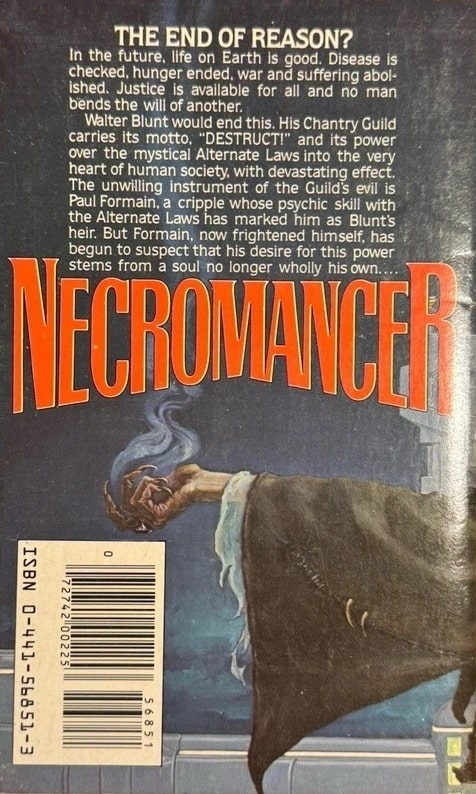
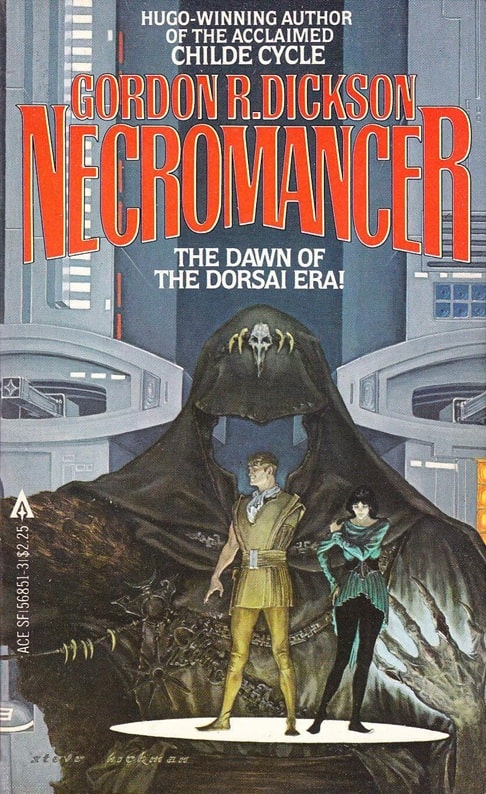
Book 2 in the Dorsai series: Necromancer (Ace, April 1981). Cover by Stephen Hickman
And then there’s the Dorsai, for whom the book (and several of its sequels) is named. It’s the name both of a planet and of the people who inhabit it. Compelled by a shortage of natural resources, their men hire out as mercenaries, known as the best soldiers in the humanly inhabited universe, both naturally talented at war and intensively trained. One of these is Dickson’s protagonist, Donal Graeme, the focus of the entire narrative.
This diversity of planetary societies sets up the novel’s conflict. In the first place, the planets are specialized, not merely in broad cultural patterns, but in economic detail. There are more specialized occupations than any one planet can afford to train for itself; the human race has a sixty-billion-person division of labor. This creates a need for specialists from each planet to travel to other planets where their services are needed, just as the Dorsai do.
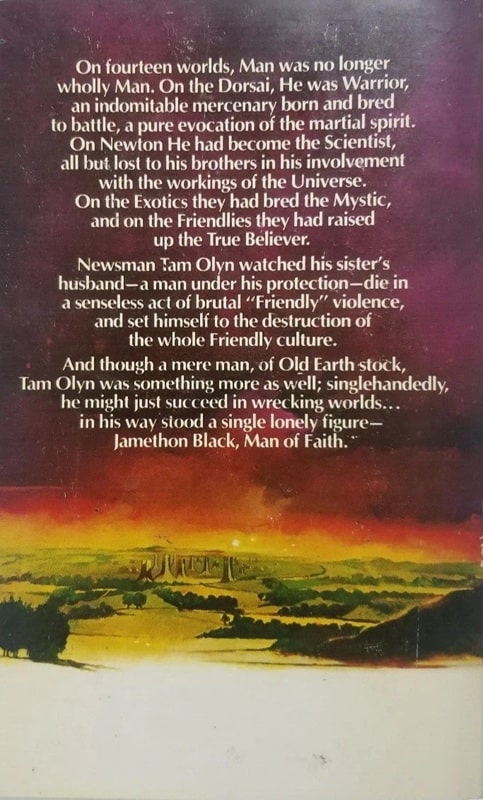
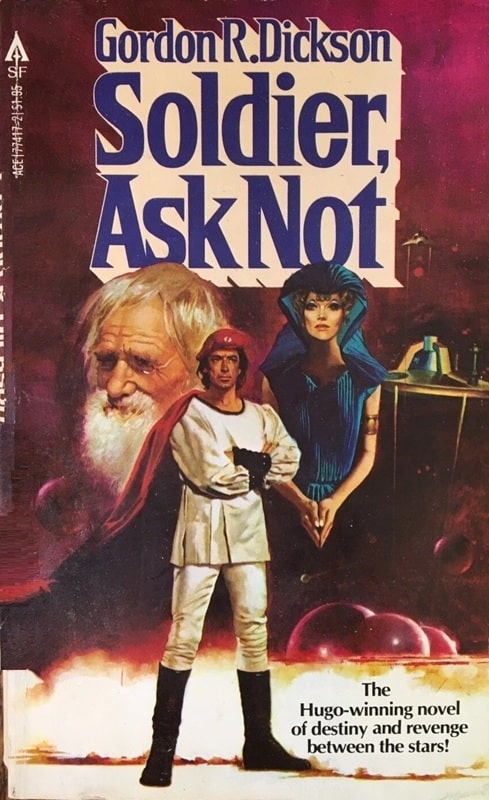
Dorsai, Book 3: Soldier, Ask Not (Ace, March 1980). Cover by Enric
But the terms on which they do so are set in different ways by different planets. At one extreme are the tight worlds: the technologically advanced Venus group, the religiously fanatical Friendlies, and Coby, a mining world controlled by a criminal cartel. At the other are Old Earth and Mars, described as “republican worlds”; the Exotics; and the Dorsai, which are counted as loose worlds.
In between are several miscellaneous worlds, including the commercial Ceta and two worlds with strong central governments, New Earth and Freiland. The tight worlds treat labor contracts virtually as indentures and are in a position to dominate the labor markets, putting them at odds with the loose worlds.
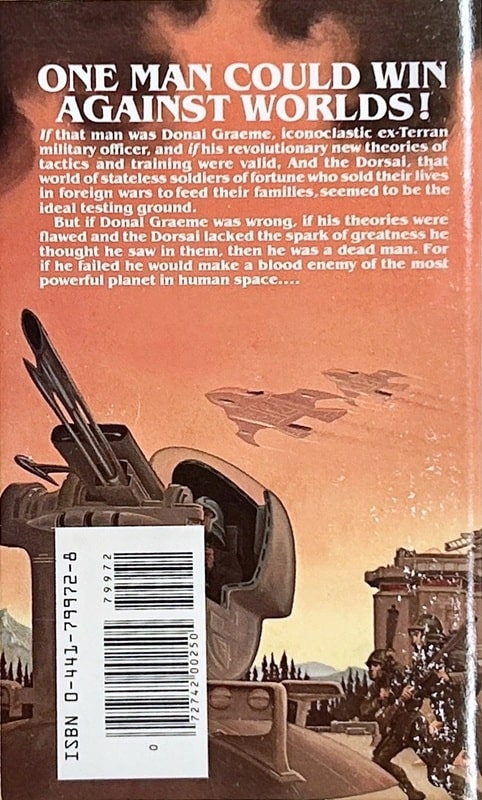
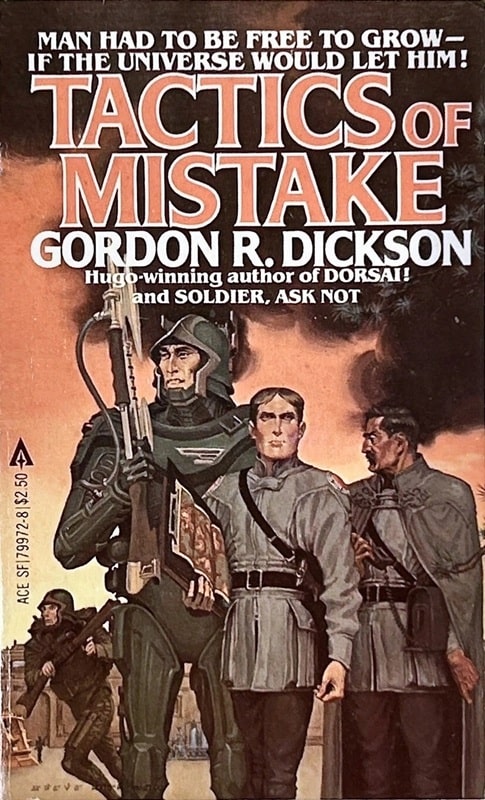
Dorsai, Book 4: Tactics of Mistake (Ace, May 1981). Cover by Stephen Hickman
It struck me on this reading that Dickson’s view of Harmony and Association seems to have changed as he wrote the series. Here they are harshly authoritarian societies with no evident redeeming features. In Soldier, Ask Not, published eight years later, they appear much more sympathetically, and it seems that Dickson’s unfinished final volume would have shown them as an essential element in the reunited human race — the element of faith, as the Dorsai are courage and the Exotics wisdom. (The other major tight faction, the Venus group, are seemingly left behind as having nothing essential to add to human destiny.)
Donal Graeme himself fits this theme of human reunification: both of his grandfathers were Dorsai, but both of his grandmothers Maran. (This hybrid ancestry made me think of another military genius in later science fiction, Lois McMaster Bujold’s part-Betan, part-Barrayaran Miles Vorkosigan.) This gives him a peculiar mix of abilities. He’s a brilliant warrior and commander, fitting a work of military fiction. But he also have some gifts that transcend normal humanity, as he’s told during his employment by the Exotics.
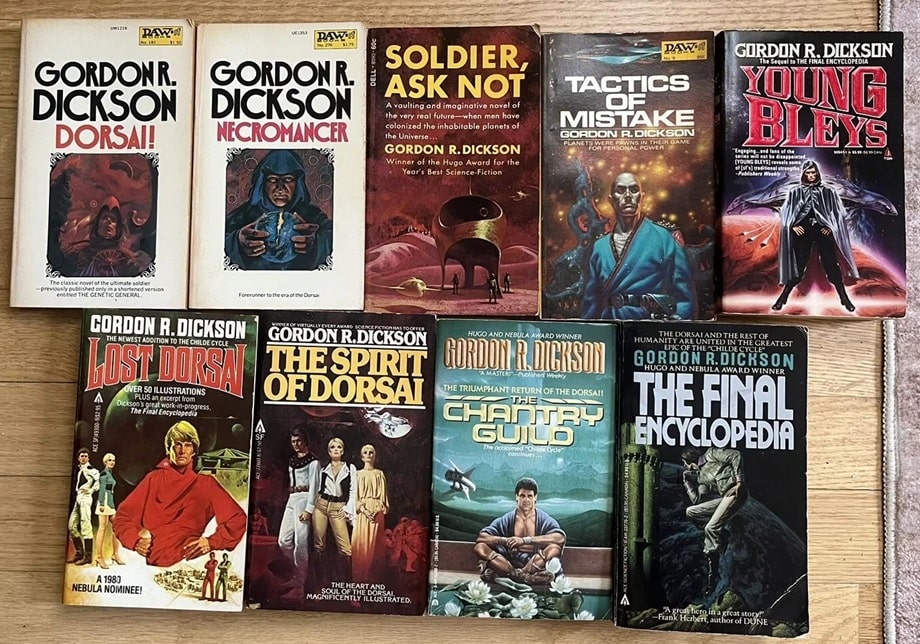 Nine paperbacks in the Dorsai series by Gordon Dickson (also called the Childe Cycle)
Nine paperbacks in the Dorsai series by Gordon Dickson (also called the Childe Cycle)
We get a foretaste of this when he finds himself able to walk on air, apparently simply by believing he can! But more profound than that is a peculiar kind of insight that deepens over the course of the novel, as a result of various stressful experiences. And that insight sets him up, almost from the outset, as an opponent of another major character: William of Ceta, a master entrepreneur whose aim is to take full advantage of the interstellar labor market.
Donal and William become both political and romantic rivals, but both rivals reflect Dickson’s underlying theme of human destiny and the question of who will shape it. In this theme, Dorsai! in a lot of ways transcends the category of military science fiction.
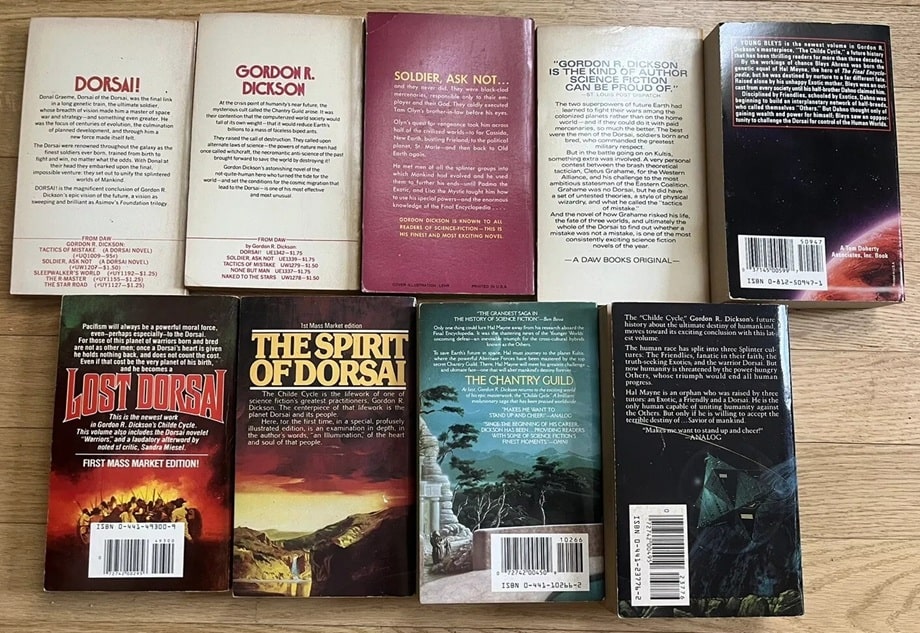 Nine paperbacks in the Dorsai series by Gordon Dickson (back covers)
Nine paperbacks in the Dorsai series by Gordon Dickson (back covers)
On one hand, this theme strikes me as more mythological than science fictional — which I’m not sure Dickson would even have disputed! On the other hand, it points the way toward the deeper emotional resonance of some of the later books, especially Soldier, Ask Not.
Dorsai! also sets a pattern Dickson will follow in later novels in the series, of presenting conflict ultimately not as a clash of institutions (despite his comments about loose and tight worlds) but as a collision of two larger than life figures on opposing sides: not so much realistic fiction as epic. This volume is a somewhat simple first presentation of the theme, but at the same time one of the clearest in the series.
William H. Stoddard is a professional copy editor specializing in scholarly and scientific publications. As a secondary career, he has written more than two dozen books for Steve Jackson Games, starting in 2000 with GURPS Steampunk. He lives in Lawrence, Kansas with his wife, their cat (a ginger tabby), and a hundred shelf feet of books, including large amounts of science fiction, fantasy, and graphic novels. His last article for us was a review of Singularity Sky by Charles Stross.
Tubi Dive, Part III
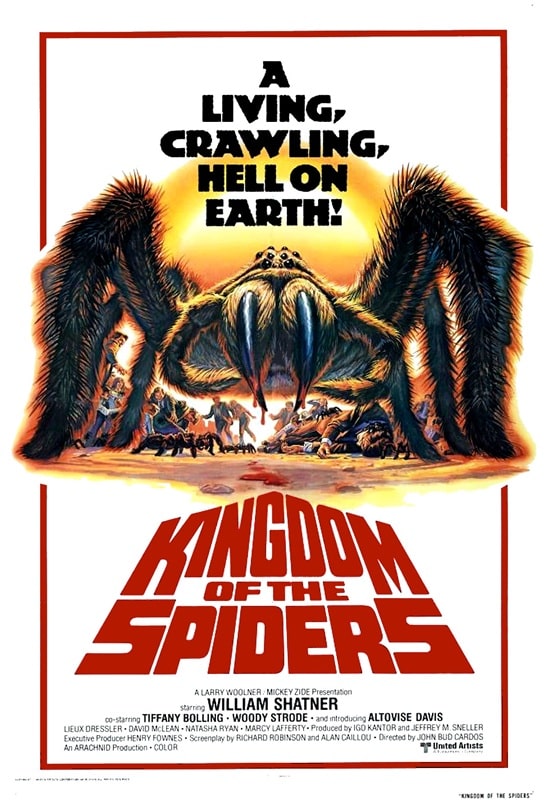 Kingdom of the Spiders (Dimension Pictures, November 23, 1977)
Kingdom of the Spiders (Dimension Pictures, November 23, 1977)
50 films that I dug up on Tubi.
Enjoy!
Kingdom of the Spiders (1977)Ah, the 70s. My formative years. Angry nature films were rampant around this time (much to my delight), and now it’s time for tarantulas to be miffed at our overuse of pesticides.
William Shatner plays Rack Hansen (staggeringly good name), a lecherous animal doctor in rural Arizona. When I say lecherous, I mean toward female humans. When Woody Strode finds his prize calf dead, the Shat is called in to figure it out. He calls in an expert from Flagstaff, and unfortunately for the expert, she is hot and blond. Shatner is all over her like tribbles on a starship.
They eventually ascertain the death was caused by spider bites, and then all eight-legged hell breaks loose.
The film is seriously daft in some spots, egregiously misogynistic in others, and cheesy to the extreme, but I had a great time with it. The climax in town is particularly Irwin Allen-style over the top chaos, and the final shot, though portrayed through a sub-par matte painting, is suitably chilling.
Worth a look if you haven’t seen it.
7/10
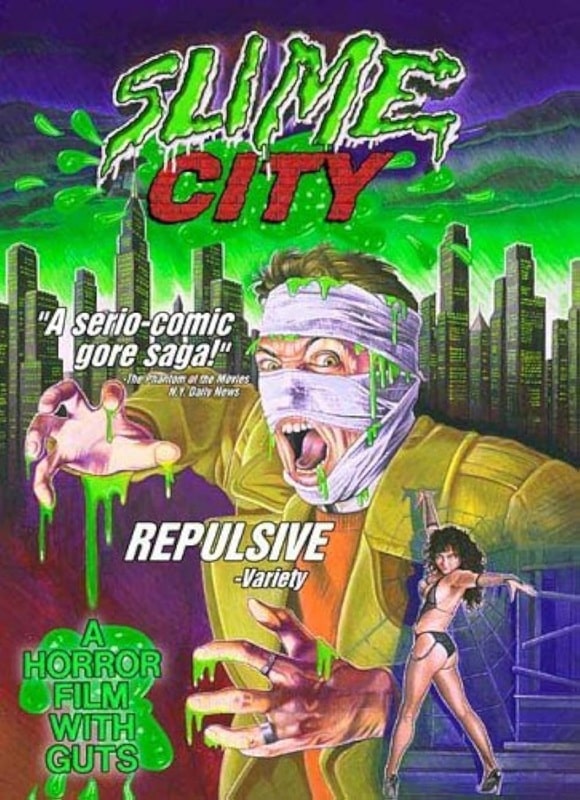
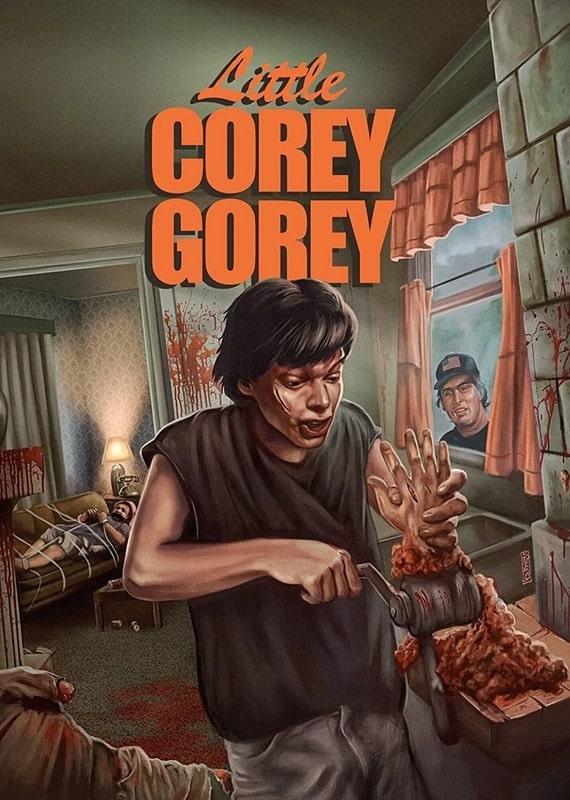
Slime City (Media Blasters, 1988) and Little Corey Gorey (DML, 1993)
I’m sometimes asked why I haven’t gotten around to watching The Brutalist or Wicked yet, and that’s because I’m too busy watching this sort of stuff.
Alex moves into a decrepit apartment building and soon encounters some fellow tenants (goth poet Roman and seductive vamp Nicole), both of whom are into eating ‘Himalayan yogurt’ and drinking a strange green liquor. It turns out these vittles are the sustenance of cultists who have possessed their bodies, and Alex is next in line. Tempted by the drink and Nicole’s jangly bits, Alex succumbs to the dark sorcery afoot, and slowly turns into a slimy murderer, ultimately going full Darkman. As you do.
It’s all quite daft and low-budget, but the dodgy line delivery and goop-stained pillows are all worth it for the final act, which involves Re-animator-levels of dismemberment (albeit less refined).
Alex’s prudish girlfriend and sex crazy Nicole are played by the same actor, Mary Huner, and I have to give her credit for fooling me. The effects are mucky and rubbery, and there are a couple of funny lines, mostly from Alex’s doofus pal.
A good entry-level flick for other fare such as Street Trash or The Abomination.
Slightly recommended.
6/10
Little Corey Gorey (1993)I’ve seen this one listed as a comedy (it’s not), and a slasher (still not), but at the end of the day, Little Corey Gorey is just a nasty bit of schlock, and not the good kind.
It’s that timeless story of a teen (9th grader) bullied and tortured by his step-mother and brother to the point where he snaps and goes on an accidental killing rampage. There’s not much else to the plot, but that usually doesn’t bother me when I’m watching one of these flicks.
However, virtually all of the main characters are so cartoonishly vile, including our ‘protagonist,’ that it was ultimately a miserable watch.
Corey, for whom we are supposed to be rooting, is a creepy, knicker-sniffing stalker and, though he certainly doesn’t deserve the abuse from his step-family, it’s impossible to sympathize with him. The only characters in this film with any decency are a Black family that live next door, and I trust this was done for a reason. There is an ongoing subplot about an escaped serial killer, but this one is nipped in the bud fairly quickly when it could have been used in a far more interesting way.
3/10
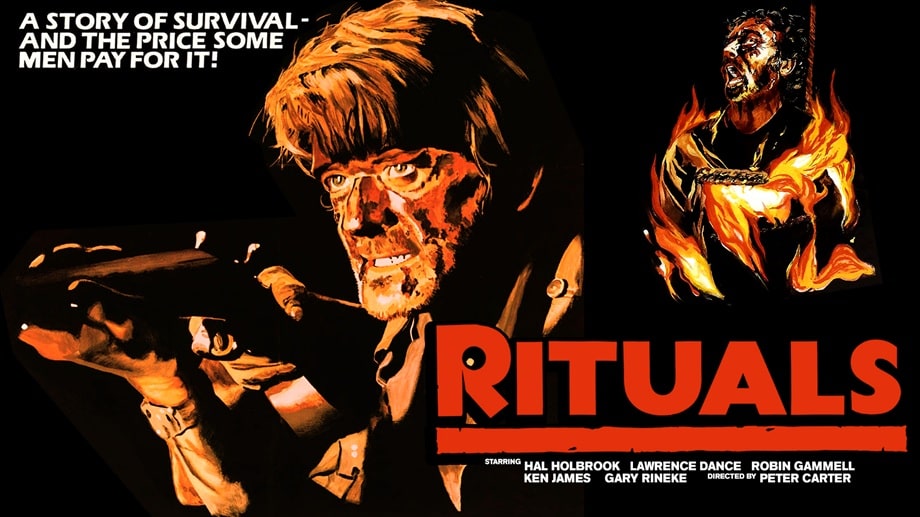 Rituals (Astral Films, August 26, 1977)
Rituals (1977)
Rituals (Astral Films, August 26, 1977)
Rituals (1977)
Here’s a Canadian film (shot in Northern Ontario) that is often dismissed as a Deliverance rip-off — but it’s much more than that. Sure, it takes the form of the tried and tested ‘fish out of water’ genre by throwing five surgeons into the remote wilderness to try and survive a deranged killer, but there’s a grittiness to the whole affair that elevates the film. Also, the characters are well-written, and an early scene where they are trying to cross a river, a scene full of unintended plunges and improvised cajoling, helps us to empathize with the group before their nightmare begins.
The kinetic camerawork gives the film an authenticity, and semi-obscured shots from the killer’s POV provide a real sense of danger. Before this film I’d never really appreciated Hal Holbrook as anything more than an interesting character actor, but he really impressed me with his physical and emotional depth.
Definitely worth a look.
8/10
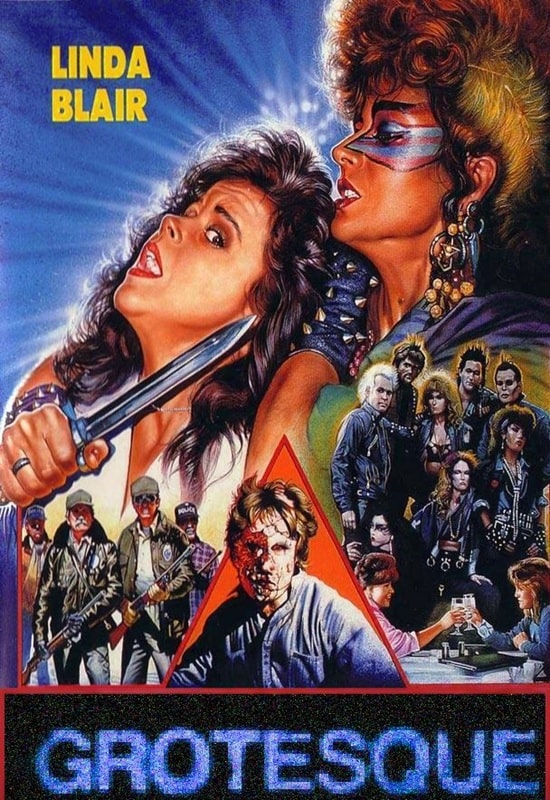 Grotesque (Empire Pictures, 1988)
Grotesque (1988)
Grotesque (Empire Pictures, 1988)
Grotesque (1988)
You want weird, and yet strangely compelling? I’ve got you.
Grotesque is executive produced (and briefly stars) Linda Blair, and Tab Hunter has a main role in it, along with Donna (Angel) Wilkes, so the schlocky cult movie DNA is intact. However, this home invasion horror is such an odd beast; bookended by a couple of movie fake-outs, and being a lot tamer than one might expect for a film that has special effects at its core.
The tale is as old as time: a special effects artist invites his family to their remote lodge, where they are set upon by a roving gang of ‘punkers’ who proceed to slaughter said family. This is witnessed by a disfigured man-child, who promptly goes on a murderous punk-slaying spree, and then the film shifts gears into a boring police procedural complete with prolonged ‘good cop/bad cop’ routine, while Linda Blair excuses herself offscreen. Then it turns into a sort of Twilight Zone episode and then descends into a ‘comedic’ finale (your experience may vary).
My brain is telling me I enjoyed it — but I really don’t listen to my brain any more.
5/10
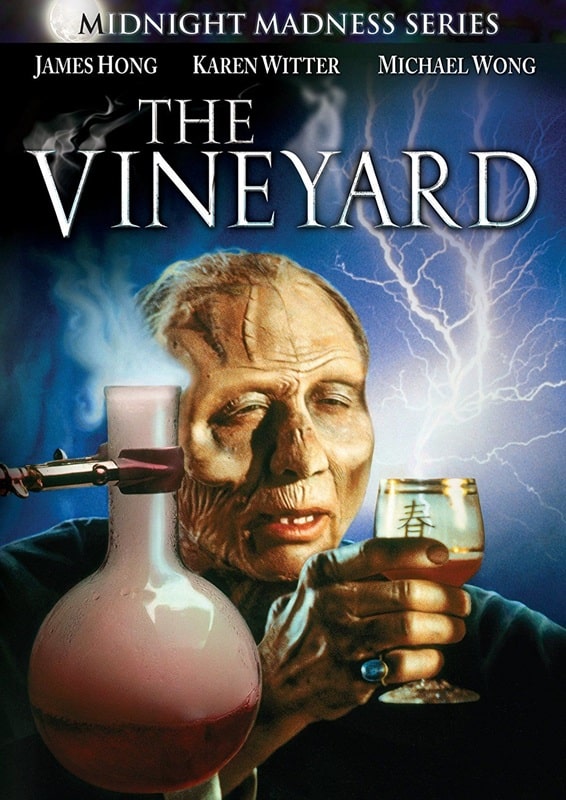
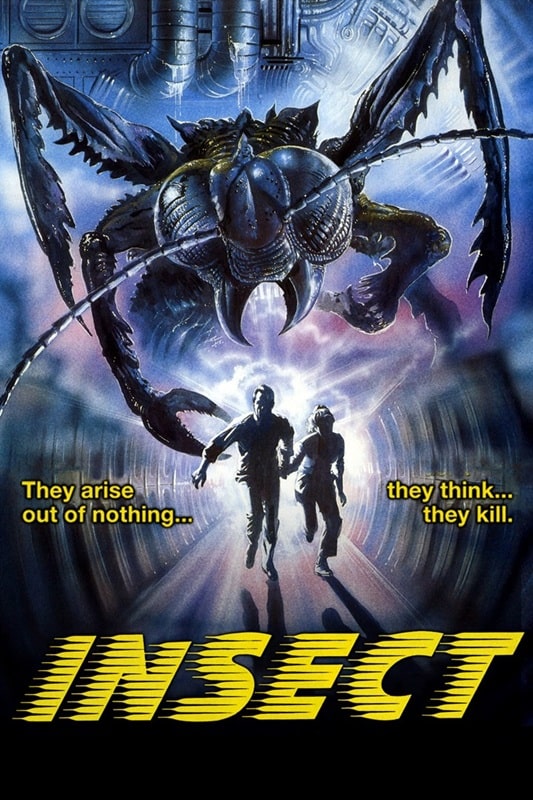
The Vineyard (New World Pictures, 1989) and
Insect! (International Spectrafilm, September 25, 1987)
James Hong, right? RIGHT?
We all love him, from Big Trouble in Little China to Everything Everywhere All At Once, from Kung Fu Panda to Balls of Fury.
James decided he wanted to make a horror film, so he wrote one, co-directed it, and starred in it. What makes him a legend? Did I mention he wrote this for himself?
EXT. DAY
A large, gothic mansion bordered by lush foliage. A bird cries in the distance.
DR. PO (me, James Hong) is standing on a balcony, fondling the pert chesticles of a blond lady.
CUT TO:
INT. BEDROOM
DR. PO (me) is having it away with the blond lady. She’s still naked.
DR. PO (me)
Awesome. I love knockers, me.
You go, James Hong!
The Vineyard is a tale as old as time (again). The descendant of a long line of immortals has become a famous vintner, but his secret ingredient is chained up ladies, of whom he supps in a strange concoction to maintain his youth (his middle age TBH). When he’s finished with them he buries them in the back yard where they lay as restless zombies, unable to rise because he is keeping them in the ground with Mayan voodoo.
Dr. Po holds a fake audition at his mansion for a fake film and a lot of pretty girls and boys turn up for it, only to discover that they are mere ingredients for his latest vintage. Po is also keeping his ancient mom in the attic room, and she is a dead ringer for Zelda from Terrahawks (if this means anything to you).
Shenanigans ensue, involving much running, shooting of arrows, extremely heavy facial prosthetics and dodgy late 80s visual effects. It’s drastically cheesy and somewhat hilarious, and I had a great time. God bless James Hong.
7/10
Insect! (aka Blue Monkey) (1987)Find any dictionary worth its salt, look up ‘hokey’ and you’ll find the poster for this film. Then you’ll see a small print addendum that reads “see also: hilariously awesome.”
Insect! is a proudly Canadian schlockfest, and it features a who’s who of the best Canadian character actors; John Vernon, Don Lake, Joe Flaherty, Robin Duke, and a 7-yr-old Sarah Polley!
The main protagonist is a weather-beaten detective played by Steve Railsback, who I always thought had more of a serial killer look than a leading man, but hey ho — I’m sure he has his fans.
Long story short, an old fella is infected by a parasite, which promptly busts out of him, grows enormous, makes itself a mate and goes into egg production, all the while eating the hospital staff.
Speaking of the hospital, this has to be the most unsecure, ethically murky, run-down medical establishment ever put on film — and I’ve seen Session 9.
Anyhoo, nurses are eaten, bugs are squished and Steve smokes next to a pregnant lady. The gore is limited but gooey, and the effects on the whole are surprisingly fun. Special shout out to a gaggle of seemingly parent-less children who run free around the hospital (and are, in fact, responsible for all the deaths in the film).
See it if you enjoy stickiness.
6/10
Previous Murkey Movie surveys from Neil Baker include:
Tubi Dive, Part I
Tubi Dive, Part II
What Possessed You?
Fan of the Cave Bear
There, Wolves
What a Croc
Prehistrionics
Jumping the Shark
Alien Overlords
Biggus Footus
I Like Big Bugs and I Cannot Lie
The Weird, Weird West
Warrior Women Watch-a-thon
Neil Baker’s last article for us was Part II of Tubi Dive. Neil spends his days watching dodgy movies, most of them terrible, in the hope that you might be inspired to watch them too. He is often asked why he doesn’t watch ‘proper’ films, and he honestly doesn’t have a good answer. He is an author, illustrator, teacher, and sculptor of turtle exhibits. (AprilMoonBooks.com).
Tor Doubles: #3 Brian W. Aldiss’s The Saliva Tree and Robert Silverberg’s Born with the Dead
 Cover for Born with the Dead by Ron Walotsky
Cover for Born with the Dead by Ron WalotskyCover for The Saliva Tree by Lee Edwards
Tor Double #3 was originally published in December 1988. The two stories included are Brian W. Aldiss’s The Saliva Tree and Robert Silverberg’s Born with the Dead. The volume was published as a tête-bêche, with Les Edwards providing the cover art for The Saliva Tree and Ron Walotsky painting the cover for Born of the Dead.
The Saliva Tree was originally published in F&SF in September, 1965. It won the Nebula Award and was nominated for the Seiun Award.
Set in the mid-1890s, The Saliva tree is the story of Geoffrey Rolles, a young gentleman of leisure in the East Anglian village of Cottersall. His head filled with socialism, he has embarked upon a correspondent with H.G. Wells, one of England’s preeminent socialists of the time. He has also taken an interest in local farmer Joseph Grendon, who has demonstrated his forward thinking ways by installing an electric generator on his farm.
The specific events of the story are sparked when Rolles and a friend see a meteor streaking through the sky, possibly striking the earth on Grendon’s property. Although Grendon welcome’s Rolles’s presence, his farmhand, Bert Neckland, sees Rolles as a rival for the affections of Grendon’s daughter, Nancy. Although Rolles claims not to be interested in her, his relationship with her will grow throughout the several months it takes for the story to unroll.
There is an interesting dichotomy to The Saliva Tree, which Aldiss handles well. The average reader, even if they don’t read a lot of science fiction, lives in a world in which the tropes of science fiction have existed since the 1890s and have seeped into the mainstream. For Aldiss’s characters, the concepts are not even new, they are non-existent. Rolles has read The Time Machine, but the ideas of alien invasion or invisible creatures are not part of his world view. Even faced with the evidence, it takes him a long time to begin to understand what is happening, and longer to convince Nancy, Grendon, and others of that truth. And that delay has terrifying consequences for both the human and animal inhabitants of Grendon’s farm.
In many cases where the reader figures out what is happening before the characters, the reader can get annoyed with the characters, but Aldiss manages to avoid this trap, partly by focusing on the characters’ relationships, but also because he has clearly defined Rolles as intelligent and forward thinking (if aimless), and it is clear that he is steps ahead of everyone in putting together the pieces with which he is presented.
Rolles maintains a correspondence with H.G. Wells, who has, by this time, published The Time Machine, but publication of The Invisible Man and The War of the Worlds is still in his future (which places the story in 1896). The implication of Rolles’s letters is that Wells based those two stories on the events that took place on Grendon’s farm, with the creatures’ invisibility inspiring the first novel and their extraterrestrial origin leading to the latter book.
While Wells is the primary and most obvious influence on The Saliva Tree, the isolated setting, the horrors occurring there, and the one person who comes to understand what is occurring despite every bit of human experience, indicates the story also owes a debt to the eldritch horror written by H.P. Lovecraft and his followers. The Aurigans, as Rolles refers to them, remain something of a mystery, but they serve their purpose of being an otherworldly presence that threatens the characters’ understanding of the world and limit their ability to respond, even as they realize what is happening on Grendon’s farm.
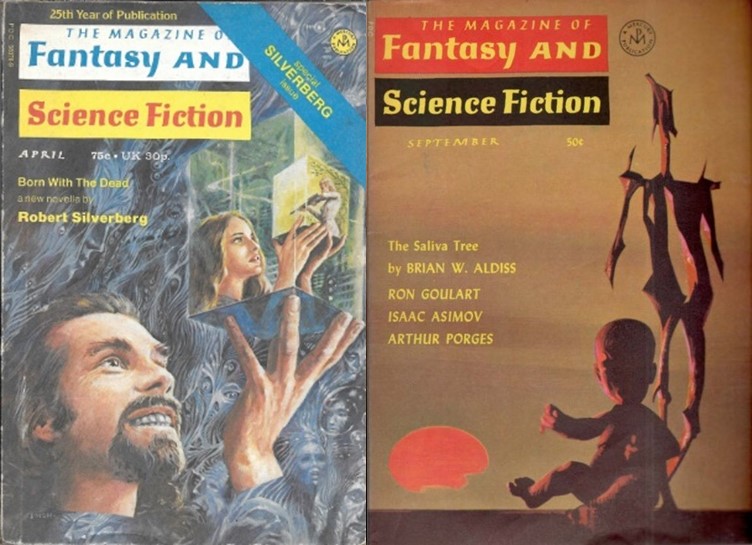 F&SF 4/74 cover by Ed Emshwiller
F&SF 4/74 cover by Ed EmshwillerF&SF 9/65 cover by Bert Tanner
Born with the Dead was originally published in F&SF in April, 1974. It was nominated for the Hugo Award and the Nebula Award, winning the latter as well as the Locus poll. It is also the first of five stories Robert Silverberg had published as part of the series.
Silverberg follows Jorge Klein, who is trying to come to terms with the death of his wife, Sybille. Klein has travelled to the island of Zanzibar, a place his wife had studied and never managed to visit before her death. Klein’s visit to Zanzibar, however, is not just an homage to his dead wife. Upon her death, Sybille went through a process called “rekindling,” which made her a “dead,” a sort of zombie, but one who can continue their life, although the dead cut off all their ties to their previous life and live in “Cold Town” communities. Klein, therefore, is grieving for a wife he knows is still pursuing her interests, just without him.
Sybille is traveling with companions, including dead anthropologist Kent Zacharias, who specializes in the Ohio Mound Builder cultures. Although Silverberg hints that Zacharias and Sybille have become a couple, he doesn’t fully explore their relationship and it may be a more platonic relationship built on shared interests. When Klein indicates he wants to meet with Sybille Zacharias informs him that she has no interest in meeting with Klein.
Despite the rebuff, Klein continues in his attempt to talk to Sybille, going so far as to work with a friend to impersonate one of the dead and travel to a Cold Town to try to meet with Sybille, breaking all rules of propriety that govern the relationships between the living and the dead. In the process, Silverberg is able to show the biggest different between the living and the dead. The rekindled have left their emotions behind. Sybille (and her companions) may not want to meet with Klein, but they seem incapable to getting angry at him for his attempts to talk to his one-time wife.
Klein, for his part, can’t accept that he is living in a world where his wife walks among the living, but is no longer interested in him, unable to get past her death, which in many ways is more reflective of a divorce. He seems positive that if he can only talk to her she would be willing to take him back into her “life,” despite what everyone tells him.
Eventually, Klein’s intrusiveness eventually becomes too much for Sybille and her companions and they have to come up with a way to help Klein get over his sense of loss since Sybille’s death and his inability to understand that even though she still exists, he is no longer part of his life.
Silverberg sets up an interesting problem, and his way of flipping the narrative between Klein and Sybille almost makes it difficult to tell whose story he is telling. In death, Sybille has a group of friends and seems to have a full life, while in life, Klein is alone, using his acquaintances to achieve the goal he is fixated on to the detriment of his job and life. Born with the Dead is an interesting and well-crafted look at a pervasive love that turns into something worse with the death of one of the partners, placing it against a fantasy background, since the method of rekindling is described in scientific terms, but without a scientific rationale.
Ann interesting note. While the concept of the Tor Doubles is that neither side is the A-side, the placement of the ISBN on one side makes it feel like the B-side. With the publication of the third Tor Double, there is a further distinguishing feature. For the first two volumes, the titles on both sides of the book were embossed. Beginning with this volume, only one of the titles is embossed.
 Steven H Silver is a twenty-time Hugo Award nominee and was the publisher of the Hugo-nominated fanzine Argentus as well as the editor and publisher of ISFiC Press for eight years. He has also edited books for DAW, NESFA Press, and ZNB. His most recent anthology is Alternate Peace and his novel After Hastings was published in 2020. Steven has chaired the first Midwest Construction, Windycon three times, and the SFWA Nebula Conference numerous times. He was programming chair for Chicon 2000 and Vice Chair of Chicon 7.
Steven H Silver is a twenty-time Hugo Award nominee and was the publisher of the Hugo-nominated fanzine Argentus as well as the editor and publisher of ISFiC Press for eight years. He has also edited books for DAW, NESFA Press, and ZNB. His most recent anthology is Alternate Peace and his novel After Hastings was published in 2020. Steven has chaired the first Midwest Construction, Windycon three times, and the SFWA Nebula Conference numerous times. He was programming chair for Chicon 2000 and Vice Chair of Chicon 7.
Goth Chick News: The Chicago Comic & Entertainment Expo Breaks Records for Nerdy Goodness
 C2E2 mailing insert with our Expo passes
C2E2 mailing insert with our Expo passes
Though Black Gate photog Chris Z and I have affectionately referred to ourselves as “horror nerds” almost from the beginning of working together, I was never quite sure if the term “nerd” was offensive to others. Therefore, in making a small nod to Big Cheese John O’s constant plea to not embarrass him, we only said “nerd” (and “geek” for that matter) in private or in hushed tones.
Then suddenly, either due to the term being liberally employed on the Netflix hit Stranger Things, or because compared to the rest of the world right now “nerds” are downright endearing, being one is akin to being a cool kid. So it’s no surprise that I absolutely loved the mailing insert that accompanied our Chicago Comic and Entertainment Expo passes this year.
 Chicago C2E2 Entrance Hall
Chicago C2E2 Entrance Hall
The Chicago Comic & Entertainment Expo, affectionately known as C2E2, is where the geeks and nerds collide with the fantastical and the macabre in a celebration of pop culture of epic proportions. Drawing fans, creators, and industry professionals from across the globe, this annual Chicago event is a haven for enthusiasts of comics, gaming, cosplay, television, movies, and more.
C2E2’s story begins in 2010, brought to life by ReedPOP, the masterminds behind globally recognized events like New York Comic Con and PAX. It was envisioned as a platform for fans to connect with their favorite creators and discover emerging talents across entertainment industries. Over the years, this vision has transformed into a pulsating, larger-than-life experience.
 The crowded halls of C2E2
The crowded halls of C2E2
We have been covering the show since its inception fifteen years ago, and it has gotten bigger each year, consuming more and more space in Chicago’s behemoth McCormick Convention Center. C2E2 2025 kept the trend going by achieving a record-breaking attendance of 100,000 fans over its three-day event, marking this year as the highest turnout in the convention’s history.
Of course, a couple of other “firsts” definitely contributed to the fandom crush. First up was a Lord of the Rings reunion that included Elijah Wood (Frodo Baggins), Sean Astin (Samwise Gamgee), Dominic Monaghan (Meriadoc ‘Merry’ Brandybuck), Billy Boyd (Peregrin ‘Pippin’ Took), John Rhys-Davies (Gimli), and Andy Serkis (Gollum).
 C2E2 cosplay
C2E2 cosplay
Though many of these actors have appeared together at other conventions such as the Fan Expo in New Orleans and Cleveland, C2E2 marked the first time they have all appeared at the same event. We walked by literally the longest line of people we have ever seen at a convention and learned it was for none other than Gollum (Andy Serkis) which is even more incredible when you think that his actual face never appeared in the film.
 The Breakfast Club reunion at C2E2
The Breakfast Club reunion at C2E2
Another first was a reunion of The Breakfast Club cast including Emilio Estevez (Andrew Clark), Molly Ringwald (Claire Standish), Judd Nelson (John Bender), Ally Sheedy (Allison Reynolds) and Anthony Michael Hall (Brian Johnson). This event was teased all over our local TV stations for the week leading up to C2E2 and generated a huge amount of buzz before, during and after the show. We had a great encounter with Anthony Michael Hall, but more on that in a few.
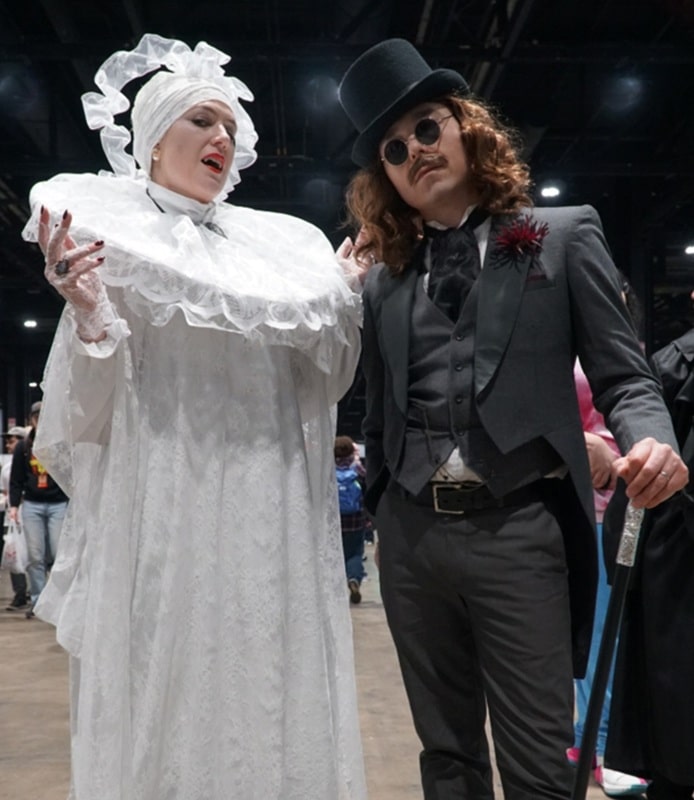 C2E2 cosplay
C2E2 cosplay
What makes C2E2 truly spellbinding is its seamless fusion of traditional comic convention staples with broader pop culture allure. While comic books and graphic novels form the heart of the expo, it’s also a playground for major studios, publishers, and independent creators unveiling their latest marvels. The event has become a must-visit destination for exclusive announcements, tantalizing sneak peeks, and insider insights.
C2E2 2025 played host to over 800 exhibitors and artists, so describing even a fraction of the cool stuff we saw would blow up Black Gate.com, but here are a few of our favorites.
 Geeky Girl Stitches
Geeky Girl Stitches
Geeky Girl Stitches: Creating handmade embroidered keychains paying homage to all manner of pop culture iconography, Tabitha Minnich wins for high-quality workmanship on these small bits of awesomeness that nearly everyone would want. We couldn’t believe the incredible range of interests represented by Tabitha’s merch; from Harry Potter to Disney, and Marvel to gaming there was something for everyone. Priced at $10 each Chris Z and I both walked away with some.
 I Contain Multitudes by Christopher Hawkins (April 30, 2025)
I Contain Multitudes by Christopher Hawkins (April 30, 2025)
Author Christopher Hawkins: There’s nothing like discovering a new horror author. His works of short fiction have been published in Sinister Tales, Murky Depths, and The Harrow, as well as in the anthologies Read By Dawn Vol 2, Shadow Regions, and The Big Book of New Short Horror. However, Hawkins was a C2E2 promoting his latest work I Contain Multitudes.
Unstuck from reality, Trina Bell never wakes up in the same world twice. Lost and alone, she crosses paths with an old librarian who is the only person who remembers her when everything else changes around them. When an encounter with a sadistic doctor makes Trina question whether she herself might be the cause of the shifting realities that are escalating out of control, she sets out to stop them.
As each successive world becomes more unstable and dangerous than the last-and with the librarian lost and descending into madness-Trina must confront the secrets rooted deep in her own past in order to find a way to repair her world before it collapses for good.
I Contain Multitudes will be available April 30th and is available for preorder on Amazon.
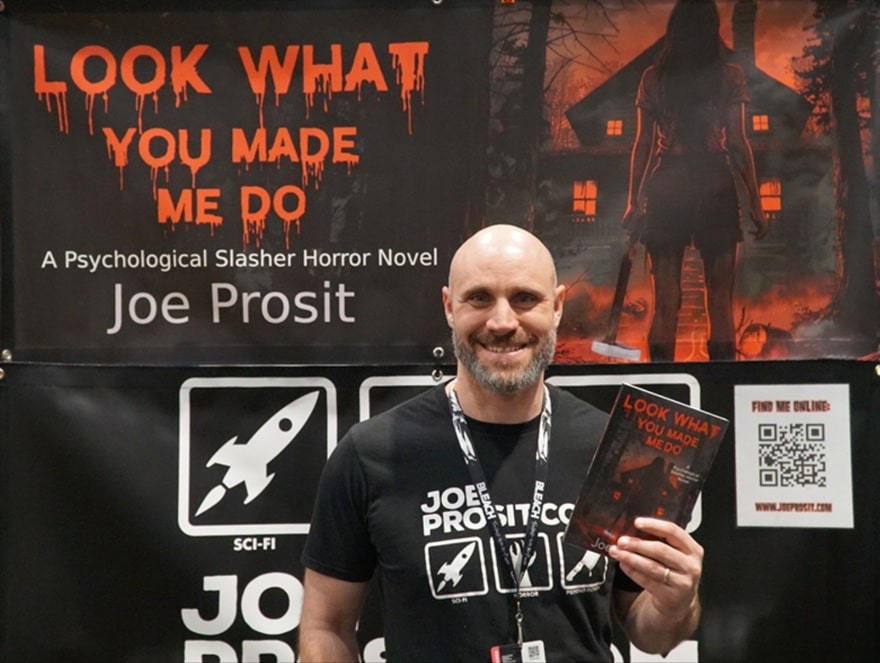 Look What you Made Me Do, by Joe Prosit (May 1, 2024)
Look What you Made Me Do, by Joe Prosit (May 1, 2024)
Author Joe Prosit: And while we’re gushing about new authors, we also were intrigued by Joe Prosit, an independent author living and writing in Brainerd, MN. His novels include Bad Brains, 99 Town, 7 Androids, Zero City, and most recently Look What You Made Me Do, a final-girl, psychological slasher horror which caught our attention.
At only seventeen, Taylor Mosley was the sole survivor of a brutal mass murder. She lived through “that night” and killed the madman who slaughtered her friends, but twenty years later, she still struggles to function in her modern corporate workplace.
Taylor is convinced the killer from her past is back and stalking her through her suburban neighborhood. Someone is sending her threatening texts, vandalizing her home, and following her on her daily runs. Is it her strange and aggressive therapist, her toxic ex-boyfriend, or the murderer from her youth? She manages to get free of her ex, only for the police to become more interested in what she’s done than who is still after her. As the threats of her present day collude with the nightmare of her past, she struggles to understand what is real, what is memory, and what is hallucination.
Maybe someday she can enjoy her idea life, but for now, Taylor must evade the police, unmask her tormentor, juggle her romantic relationships, find a healthy work-life balance, quench her thirst for revenge, and make a stand for women everywhere while still finding time to relax and enjoy a nice merlot.
Prosit has published many short stories in various magazines and podcasts and compiled them in his short story collection title, Machines Monsters and Maniacs Volume I. The second volume is coming this October. Look What You Made Me Do is available now on Amazon.
 Fandom Alley
Fandom Alley
Fandom Alley: Producing what they explain are “Film Cell” presentations, Fandom Alley has framed art that contains one or more clips of real 35mm film from the movies. We pressed the representative we spoke to regarding the classic horror movies they had on display, specifically as I was drooling over Bela Lugosi’s Dracula.
Clearly these aren’t cells from original films as cutting those would not only be blasphemous but downright impossible. The rep told us that each cell was real film from the movie and each art piece came with a certificate of authenticity. Beyond that, he could not say more has he was “bound by a non-disclosure agreement.”
So, the bottom line is these are real cells of real movie reprints, but still, one of the coolest things we saw – especially as they had small light boxes that fit behind the framed pieces making them true bits of art. Prices start at $35 and go up from there, and are available online.
 Geekify does Patrick Rothfuss
Geekify does Patrick Rothfuss
Geekify: We first met the crew from Geekify at C2E2 2015 where I purchased a leather cover for my tablet that looked the “Handbook for the Recently Deceased” from Beetlejuice. A Colorado-based creative studio that masterfully blends the realms of geek culture with artisanal craftsmanship, Geekify Inc operates as a fusion of a mad scientist’s lab and a full production workshop.
They officially license pop culture merchandise from beloved franchises such as The Princess Bride, Labyrinth, and The Hobbit, and their booth featured an array of handcrafted items, including leatherbound books, cloth maps, enamel pins, and cosplay accessories, all reflecting their commitment to quality and detail. They also make custom items such as maps, and I’ve already hit them up for a “life size” version of the map of the ” time holes” of the universe, from the 1981 film Time Bandits.
 Chicago C2E2
Chicago C2E2
Chicago Horror Writers: The HWA Chicagoland Chapter is the regional chapter of the Horror Writers Association. The Chapter consists of local writers, editors, artists, publishers in and around the Chicagoland area to help support, promote and network with others in the genre. The Chapter hosts monthly meetings at local libraries and/or bookstores in the Chicagoland area for anyone who is interested in horror or dark literature.
The Horror Writers Association (HWA) is a nonprofit organization of writers and publishing professionals around the world, dedicated to promoting dark literature and the interests of those who write it. HWA was formed in 1985 with the help of many of the field’s greats, including Dean Koontz, Robert McCammon, and Joe Lansdale. Today, with over 1250 members in countries around the world, it is the oldest and most respected professional organization for the much-loved writers who have brought you the most enjoyable sleepless nights of your life.
I am super excited about meeting members of the Chicago chapter and am in the process of establishing membership after all these years of covering HWA’s Stoker awards.
 It cosplay at C2E2
It cosplay at C2E2
And finally, a short story of our meeting with Anthony Michael Hall. Chris Z and I were walking past the many celebrity tables trying to get a peep at some. The configuration has the celebrities at quite a distance, behind long, roped off aisles where the hoards of fans line up. As it was late in the afternoon on a Friday, some celebrities were gone while others weren’t making an appearance until Saturday.
We walked by the area where the stars of The Breakfast Club were seated, though only the boys were in attendance on Friday. The only person at his table was Anthony Michael Hall and I paused at the end of his aisle squinting to get a look at him. It looked like he might be packing up for the day as there was no line of fans. Hall was chatting with his C2E2 “handler.”
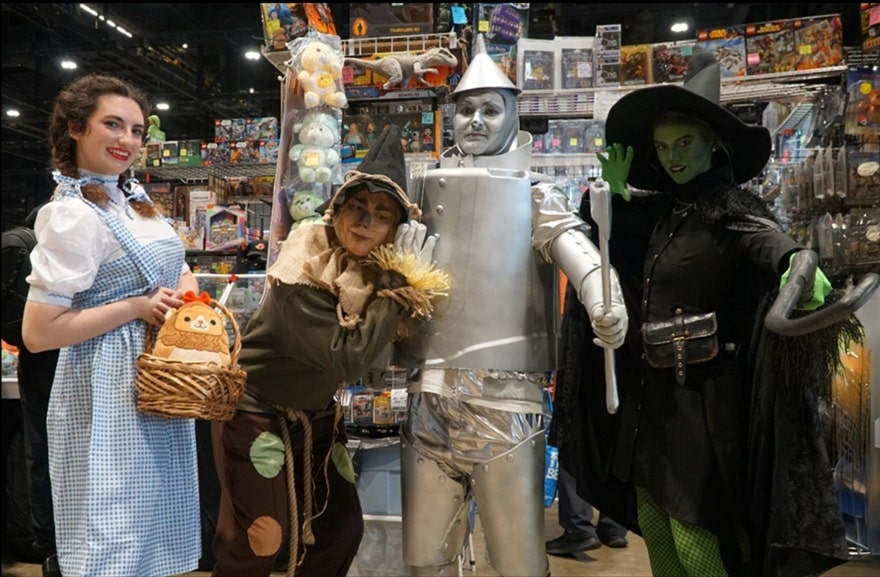 Gone With the Wind cosplay at C2E2
Gone With the Wind cosplay at C2E2
Suddenly, Hall looked up and raised his arm, waving enthusiastically in my direction. Instinctively I raised my hand and waved back with equal enthusiasm and started making my way down the aisle toward him. Chris Z recovered from his temporary shock and said, “Wait! You know Anthony Michael Hall???” I said, “Sort of, we have some mutual friends.” Chris just kept saying, “Wait! What?”
When I reached Hall’s table a little ahead of Chris, I whispered to Hall to play along. I then proceeded to say how great it was to see him again, and he did the same. We acted like old friends while Chris was speechless. I finally owned up, and the three of us had a wonderful chat. Hall told us stories about filming in Chicago and his great memories of our city. And who had Hall really been waving to? None other than Judd Nelson who stuck his head around a curtain to also say hello.
Looking ahead, C2E2 2026 is scheduled for March 27–29 at McCormick Place. For more information and updates, visit the official C2E2 website. Embrace the dark, the delightful, and everything in between — it’s what C2E2 does best.
The Eccentric’s Bookshelf: Michael Weldon’s Psychotronic Encyclopedia of Film
1983? Let me tell you how it was.
In a World Without the Internet, before Youtube, before Netflix, before Prime, before 4K UHD smart TVs, before social media or Substack or niche newsletters, before IMDb and Rotten Tomatoes, before DVDs and Blu-rays, even before blogs (gasp!), you would find yourself sitting around late at night, channel surfing, listlessly flipping through TV Guide, restlessly looking for something to watch, and you would come across a movie like The Horror of Party Beach and you would think, “What the hell? Is this worth ninety minutes of my life?” And since you would likely have only once chance to see the thing, it was a decision fraught with import. (I’ve always wanted to use that phrase.)
In the absence of all of the resources and options we now take for granted, how did you decide what to do? I’ll tell you what I did — I reached for The Psychotronic Encyclopedia of Film.
The brainchild of Uber-Geek Michael Weldon and an offshoot of his Psychotronic Video magazine, the book is, according to the back cover, “The complete viewer’s guide to the weirdest movies of all time!” It’s a boast that the volume makes good on with one pseudopod tied behind its back.
The back cover also sports an important disclaimer:
WARNING! The author of this book has been watching these movies obsessively since the age of 6. He is now unfit for conventional employment. Because of the addictive nature of these films, we the publishers cannot guarantee that your sanity won’t be endangered by reading this book.
Just what is a “psychotronic” movie? Well, it’s a broad category covering all manner of films, from horror and science fiction to juvenile delinquent dramas to women behind bars sleaze to sword-and-sandal epics; in other words, low-budget exploitation movies generally, with some exceptions for big-budget productions with low-budget souls. To again quote the back cover (and let me tell you, it’s one of the greatest back covers of all time — and the front cover is no slouch, either),
From the slightly offbeat to the outlandishly bizarre… from the no-budget quickie to the multimillion-dollar box-office smash… PSYCHOTRONIC films range from Attack of the Killer Tomatoes to E.T…. from Angel’s Wild Women and Hellcats of the Navy to I Dismember Mama and Let Me Die a Woman… from sincere social commentary to utter trash. PSYCHOTRONIC stars are ex-models, ex-sports heroes, dead rock idols, future presidents, would-be Marilyns, and has-beens of all types.
Once you manage to get past the cover — no easy task — the book consists of over 3,000 punchy reviews of psychotronic movies (most written by Weldon himself), seasoned with tons of great photographs: movie posters, lobby cards, publicity stills, and images from the actual films adorn almost every page.
It was a great day when I bought my first copy of The Psychotronic Encyclopedia. (I’ve gone through several over the years, and when I wear one out, I give it to a prospective acolyte; I aim to earn my way into psychotronic heaven by actively proselytizing. These days if you want a copy your best bet is eBay, where you can also find copies of Psychotronic Magazine.)
In the bad old days, it was extremely hard to find out about these films, and a surprising number of people — some of them capable of speaking in complete sentences and holding down real jobs, believe it or not — wanted precisely the kind of information that only The Psychotronic Encyclopedia could provide.
But don’t take my word for it. Let card-carrying Respectable Citizen and certified Hero of the Mainstream Literary Establishment Colson Whitehead, who won the National Book Award and the Pulitzer Prize for his novel The Underground Railroad and who also penned the zombie apocalypse saga Zone One, vouch for the value of the psychotronic worldview. Whitehead declared that
Weldon’s book was proof that even the most unlikely idea had a chance. If these movies existed, then surely whatever measly story was bubbling in my brain was not so preposterous. The psychotronic movie’s disregard for mimesis, its sociopathic understanding of human interaction, its indifferent acting, and its laughable sets were a kind of ritualized mediocrity. The filmmakers were so inept in their portrayal of any kind of recognizable reality that their creations became a form of grubby science fiction, documentaries about an alternative planet.
Bull’s-eye. Disreputable, shocking, embarrassing, tasteless, tacky, trashy, revolting, hilarious (intentionally or, more commonly, unintentionally), utterly free from the constraints of competence and good manners imposed on “serious” filmmakers, offhandedly subverting every decent value (often including that of minimal coherence), psychotronic films are rebellion made flesh — or celluloid. Just watching one feels like striking a blow for liberty, and Michael Weldon’s book is a revolutionary manifesto more radical than anything ever tossed off by Marx and Engels. (Just imagine what that pair of stuffy Germans would have made of Hot Rods to Hell or Robot Monster!)
Of course, because the book was published in 1983, it also an artifact from A World Without any Movie Made over the Last Forty Years — no Repo Man, no Silence of the Lambs, no Dark City, no Revenge of the Sith (ok, not having that movie might be a feature rather than a bug), no Shaun of the Dead, no Independence Day.
This admittedly limits the Psychotronic’s utility somewhat, but I still find myself thumbing through its well-worn pages with embarrassing frequency. Sometimes you just have to know who starred with Bela Lugosi in The Devil Bat or what year Roger Corman made Ski Troop Attack, and it’s one of those books that’s truly like a bag of potato chips — you can’t read just one entry. Before you know it, you’ve blown an hour seeing if Weldon did justice to Count Yorga, Vampire or The Mole People, gaining new insight into Werewolf in a Girl’s Dormitory or Whatever Happened to Baby Jane, and admiring photographs of Chubby Checker, Jayne Mansfield, and Vincent Price (not from the same movie, unfortunately — some things will never happen this side of paradise).
Anyway, if the years 1984 to 1995 are all that important to you (I can barely remember them, myself) Weldon produced a second volume called The Psychotronic Video Guide in 1996. But while the original Psychotronic Encyclopedia still lives right under my wide-screen TV where I can lay hands on it at a moment’s notice, I found that I never used the Psychotronic Video Guide that much.
Maybe that’s because by 1996 we were on the cusp of a change the magnitude of which we couldn’t even begin to imagine, and the old world of B-movie, cult movie, low-budget, late-night old movie TV was about to vanish forever, or at least be transformed almost beyond recognition. Today if you want to investigate The Horror of Party Beach, you can watch it any hour of the day or night on Youtube (at least as of last weekend — as you know, the streaming world is as inconstant as our nation’s trade policy) and there are countless people on that same platform who do nothing but yammer endlessly about these kinds of movies.
It’s great, in its way, but sometimes I miss the old days when opportunities were fleeting and consequently the choices seemed more important; hell, I even miss the used car commercials.
So, what did I do about that non-hit of 1964, The Horror of Party Beach, when I came across it all those years ago? Did I sacrifice an hour and a half of the only life I’ll ever have to watch such a manifest piece of junk? Such a momentous decision would paralyze most people, but I consulted the Psychotronic Encyclopedia, and on page 331 I was told,
Forget anemic teen horror movies like Ghost in the Invisible Bikini. This low-budget gem from Stamford, Connecticut, features kids on the beach dancing to “The Zombie Stomp” and a girl who drinks hard liquor and strips for bikers. Meanwhile radioactive waste turns human skulls on the bottom of the ocean into horrible monsters! They kill the wayward girl on the beach, then all the girls at a slumber party. If you don’t understand what’s happening, newspaper headlines (MONSTERS STRIKE!, MONSTERS STRIKE AGAIN!, and MASS MURDER AT SLUMBER PARTY!) are shown to keep you informed. With great music by the Del-Aires, lame jokes, phony blood, a sportscar driven through New York City, and a maid named Eulabelle who saves the day by knocking a beaker of sodium on a living monster hand, which promptly disintegrates. Billed as “the first horror monster musical!” it’s a cool classic that was also turned into a photo comic book. EXTRA! EXTRA! FIVE MORE KILLED BY MONSTERS!
Did I watch The Horror of Party Beach?
Don’t ask stupid questions.
Thomas Parker is a native Southern Californian and a lifelong science fiction, fantasy, and mystery fan. When not corrupting the next generation as a fourth grade teacher, he collects Roger Corman movies, Silver Age comic books, Ace doubles, and despairing looks from his wife. His last article for us was Movie of the Week Madness: Duel


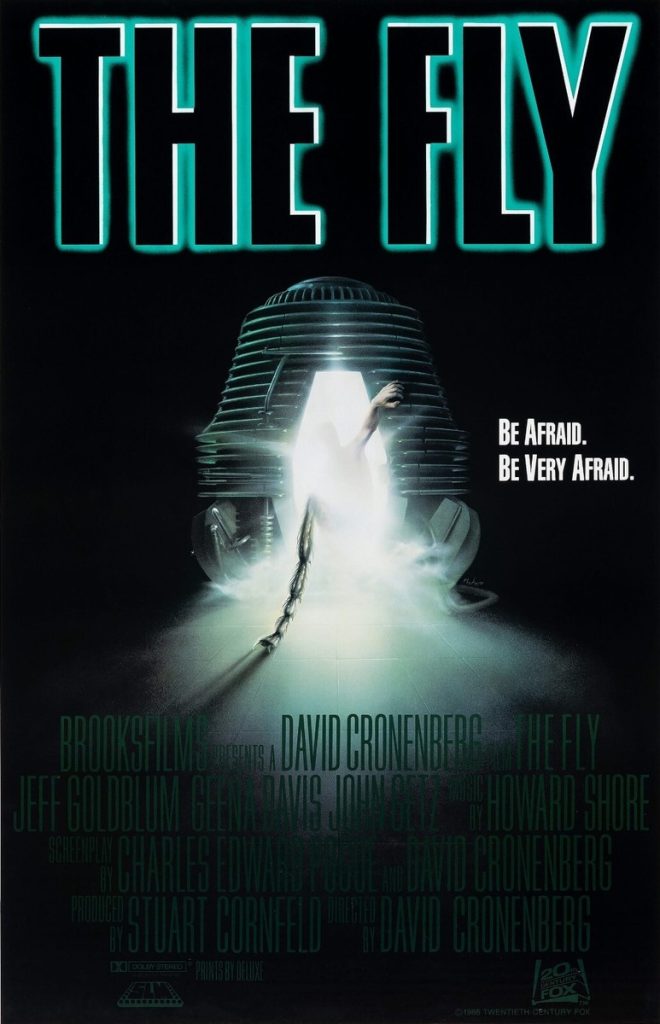
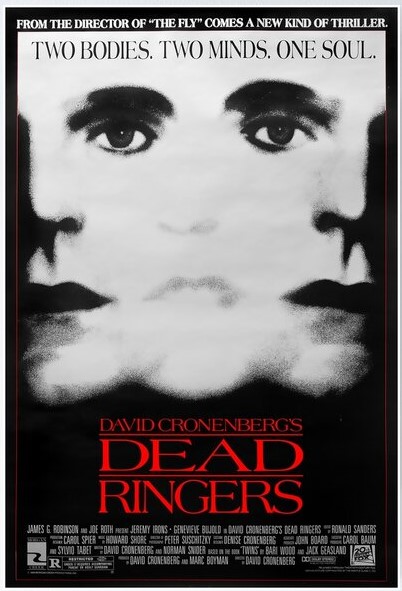
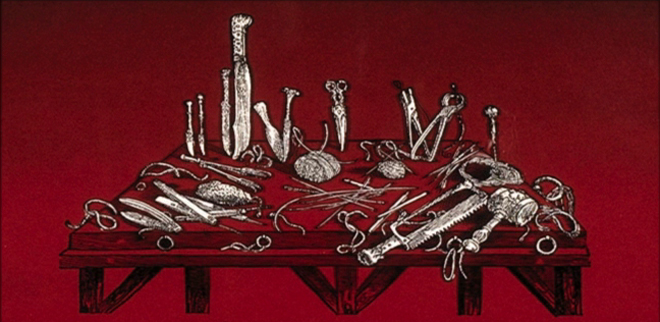
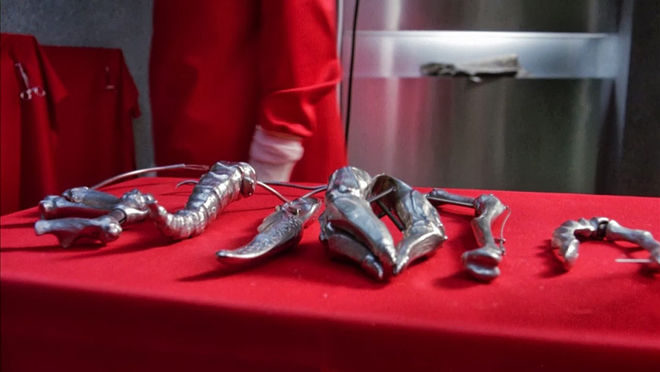
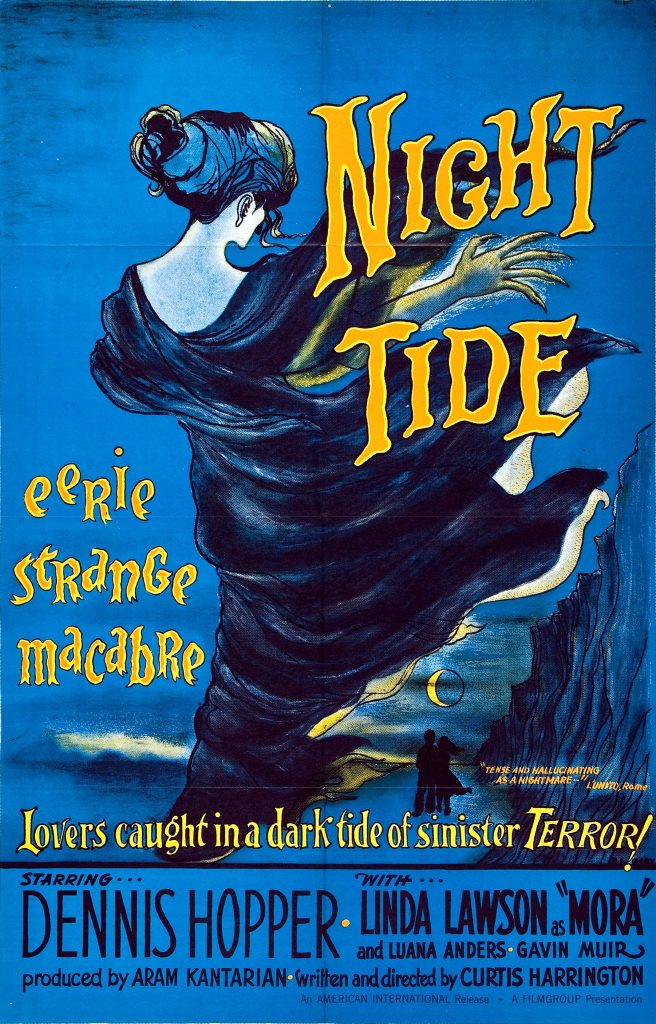



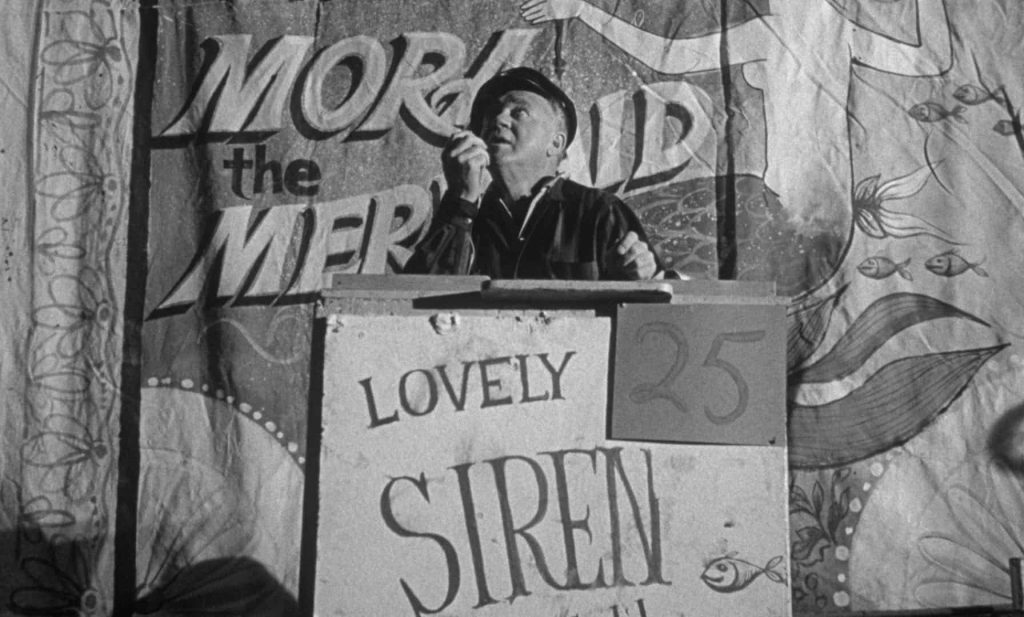

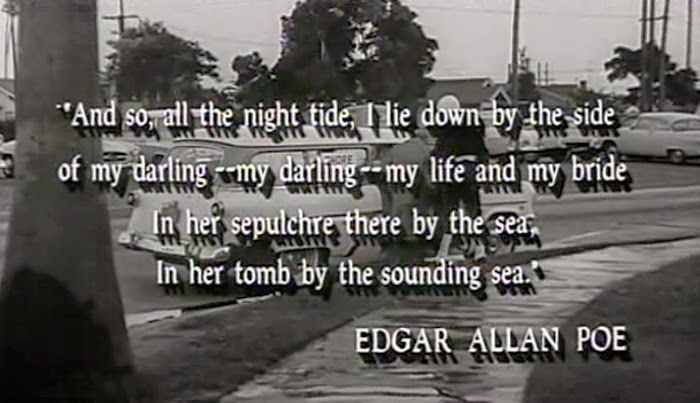
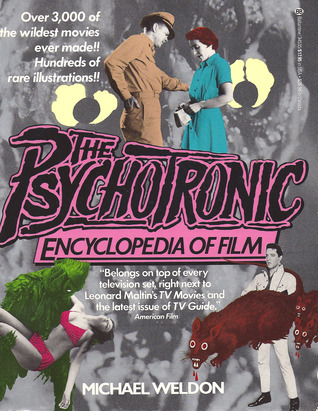
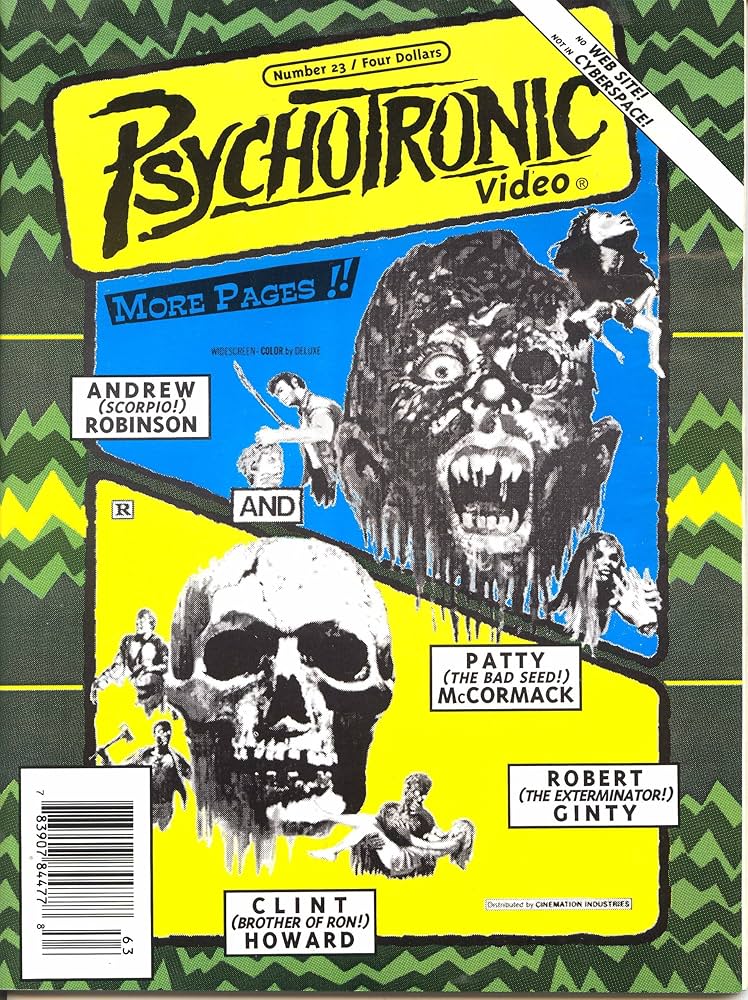
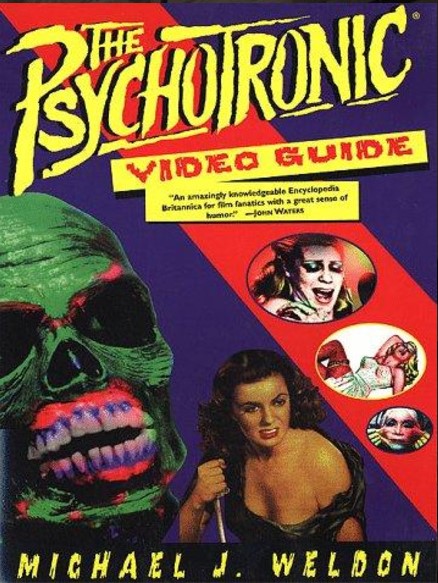
Recent comments